Motorola Mobility T56DW1 Portable Cellular / PCS GSM Transceiver User Manual UG C330 GSM
Motorola Mobility LLC Portable Cellular / PCS GSM Transceiver UG C330 GSM
Exhibit 8 Users Manual

APPLICANT: MOTOROLA, INC. FCC ID: IHDT56DW1
EXHIBIT 8
INSTRUCTION MANUAL
A preliminary draft copy of the Users Manual follows:

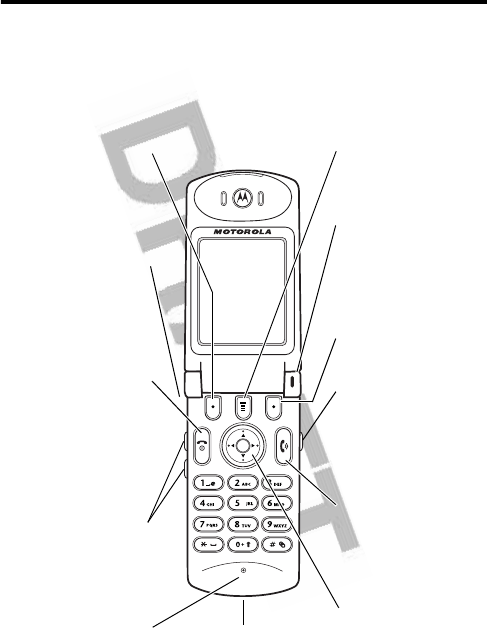
1
Welcome
Welcome to the world of Motorola digital wireless
communications! We are pleased that you have chosen the
Motorola T725 EDGE wireless phone.
Headset Jack
Insert headset
accessory for
hands-free use.
Status Light
See incoming call
and service status.
Volume Keys
Adjust earpiece and
ringer volume.
Voice Key
Record phonebook
& shortcut names
(hold for voice
records).
Microphone Accessory
Connector Port
Insert charger and
phone accessories.
Power Key
& End Key
Turn phone on and
off, end phone
calls, exit menu
system.
Right Soft Key
Perform functions
identified by right
display prompt.
Menu Key
Left Soft Key
Perform functions
identified by left
display prompt.
Send Key
Send and answer
calls, view recent
dialed calls list.
5-Way
Navigation Key
Scroll through
menus and lists, set
feature values.
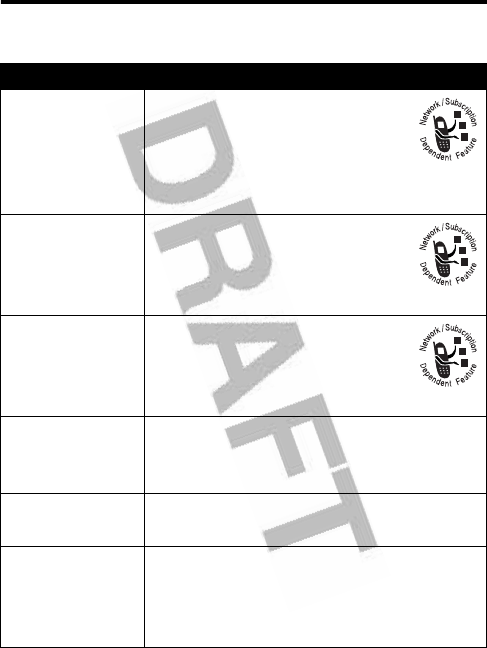
2
Check It Out!
Feature Description
Send
Multimedia
Message
Send a multimedia message
with pictures, animations, and
sounds:
M
>
Messages
>
Create Message
>
New MMS
Read Message
Read a new text or multimedia
message that you have
received:
Press
READ
(
+
).
Store Message
Objects
Go to a multimedia message
slide, or highlight an object in a
letter, then:
M
>
Store
Create
Phonebook
Entry
Create a new phonebook entry:
M
>
Phonebook
M
>
New
>
Phone Number
or
Email Address
Dial Number in
Phonebook
Call a number stored in the phonebook:
M
>
Phonebook
> entry to call
N
Voice Dial
Number in
Phonebook
Voice dial a number stored in the
phonebook:
Press and release the voice key, and say
the entry’s name (within 2 seconds).

3
Motorola, Inc.
Consumer Advocacy Office
1307 East Algonquin Road
Schaumburg, IL 60196
1-800-331-6456 (United States)
1-888-390-6456 (TTY/TDD United States)
1-800-461-4575 (Canada)
www.motorola.com
(United States)
www.motorola.ca
(Canada)
MOTOROLA and the Stylized M Logo are registered in the US Patent &
Trademark Office. Java and all other Java-based marks are trademarks or
registered trademarks of Sun Microsystems, Inc. in the U.S. and other
countries. All other product or service names are the property of their
respective owners.
© Motorola, Inc. 2003.
Software Copyright Notice
The Motorola products described in this manual may include copyrighted
Motorola and third-party software stored in semiconductor memories or other
media. Laws in the United States and other countries preserve for Motorola
and third-party software providers certain exclusive rights for copyrighted
software, such as the exclusive rights to distribute or reproduce the copyrighted
software. Accordingly, any copyrighted software contained in the Motorola
products may not be modified, reverse-engineered, distributed, or reproduced
in any manner to the extent allowed by law. Furthermore, the purchase of the
Motorola products shall not be deemed to grant either directly or by implication,
estoppel, or otherwise, any license under the copyrights, patents, or patent
applications of Motorola or any third-party software provider, except for the
normal, non-exclusive, royalty-free license to use that arises by operation of
law in the sale of a product.
Manual number: 6809469A53-X
Cover number:
8988485L61-O

4
Menu Map
Main Menu
n
Phonebook
s
Recent Calls
• Received Calls
• Dialed Calls
• Notepad
• Call Times
•Data Times
•Data Volumes
e
Messages
• Create Message
• Message Inbox
• mMode Messging
• Email Msgs
•Browser Msgs
•Voicemail
•Outbox
• Drafts
•Quick Notes
w
Settings
(see next page)
M
Datebook
É
Office Tools
• SIM Applications *
•Calculator
• Datebook
• Shortcuts
•Voice Records
•Alarm Clock
• Dialing Services
•Fixed Dial
•Service Dial*
Q
Games & Apps
á
Web Access
• mMode
• Web Shortcuts
• Stored Pages
•History
•Go To URL
• Browser Setup
• Web Sessions
h
Multimedia
• Themes
•Pictures
• Sounds
• MotoMixer
•Camera
This is the standard phone menu
layout.
Menu organization and
feature names may vary on your
phone.
Not all features may be
available on your phone.
* Indicates Network or Subscription
Dependant Features
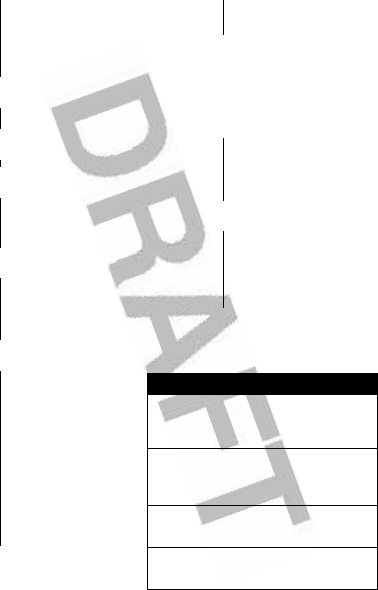
5
Settings Menu
l
Personalize
• Home Screen
• Main Menu
•Color Style
•Greeting
• Wallpaper
• Screen Saver
t
Ring Styles
• Style
•Style Detail
L
Connection
•Sync
H
Call Forward
•Voice Calls
•Fax Calls
•Data Calls
• Forward Status
U
In-Call Setup
• In-Call Timer
• My Caller ID
• Talk and Fax
• Answer Options
• Call Waiting
Z
Initial Setup
• Time and Date
•1-Touch Dial
• Display Timeout
• Backlight
• Status Light
• TTY Setup
•Scroll
• Language
• Battery Save
• Brightness
•DTMF
•Master Reset
• Master Clear
m
Phone Status
•My Tel. Numbers
• Active Line *
• Battery Meter
S
Headset
J
Car Settings
j
Network
u
Security
• Phone Lock
• Lock Application
•Fixed Dial
• SIM PIN
•New Passwords
c
Java Settings
•Java System
• Delete All Apps
• App Vibration
• App Volume
• App Backlight
• DNS IP
* Indicates Network or Subscription
Dependant Features
Shortcuts
Change ringer alert:
Open flip and press volume keys
up or down.
Display my phone number:
Press
M#
(from home
screen).
Go to dialed calls list:
Press
N
(from home screen).
Exit menu system:
Press
O
.

6
Contents
Menu Map
. . . . . . . . . . . . . . . . . . . . . . . . . . . . . . . . . . . . . . 4
Safety and General Information
. . . . . . . . . . . . . . . . . . . 12
Getting Started
. . . . . . . . . . . . . . . . . . . . . . . . . . . . . . . . . 18
About This Guide . . . . . . . . . . . . . . . . . . . . . . . . . . . . . . 18
Installing the SIM Card . . . . . . . . . . . . . . . . . . . . . . . . . . 19
Installing the Battery . . . . . . . . . . . . . . . . . . . . . . . . . . . . 19
Charging the Battery. . . . . . . . . . . . . . . . . . . . . . . . . . . . 20
Battery Use . . . . . . . . . . . . . . . . . . . . . . . . . . . . . . . . . . . 21
Attaching the Camera . . . . . . . . . . . . . . . . . . . . . . . . . . . 23
Turning Your Phone On. . . . . . . . . . . . . . . . . . . . . . . . . . 23
Adjusting Volume . . . . . . . . . . . . . . . . . . . . . . . . . . . . . . 24
Making a Call . . . . . . . . . . . . . . . . . . . . . . . . . . . . . . . . . 24
Answering a Call . . . . . . . . . . . . . . . . . . . . . . . . . . . . . . . 25
Viewing Your Phone Number . . . . . . . . . . . . . . . . . . . . . 25
Highlight Features
. . . . . . . . . . . . . . . . . . . . . . . . . . . . . . 26
Sending a Multimedia Message . . . . . . . . . . . . . . . . . . . 26
Receiving a Multimedia Message . . . . . . . . . . . . . . . . . . 28
Sending an Email Message . . . . . . . . . . . . . . . . . . . . . . 28
Using Photos and Pictures . . . . . . . . . . . . . . . . . . . . . . . 31
Taking and Sending a Photo. . . . . . . . . . . . . . . . . . . . . . 33
Making a Conference Call. . . . . . . . . . . . . . . . . . . . . . . . 36
Synchronizing Data. . . . . . . . . . . . . . . . . . . . . . . . . . . . . 36
Learning to Use Your Phone
. . . . . . . . . . . . . . . . . . . . . . 38
Using the Display . . . . . . . . . . . . . . . . . . . . . . . . . . . . . . 38
Using the 5-Way Navigation Key. . . . . . . . . . . . . . . . . . . 42
Using Menus. . . . . . . . . . . . . . . . . . . . . . . . . . . . . . . . . . 43
Entering Text. . . . . . . . . . . . . . . . . . . . . . . . . . . . . . . . . . 46
Using the Status Light. . . . . . . . . . . . . . . . . . . . . . . . . . . 56

7
Using the External Display . . . . . . . . . . . . . . . . . . . . . . 56
Changing a Code, PIN, or Password. . . . . . . . . . . . . . . 57
Locking and Unlocking Your Phone. . . . . . . . . . . . . . . . 57
If You Forget a Code, PIN, or Password . . . . . . . . . . . . 58
Using the Phonebook . . . . . . . . . . . . . . . . . . . . . . . . . . 59
Setting Up Your Phone
. . . . . . . . . . . . . . . . . . . . . . . . . . 61
Storing Your Name and Phone Number . . . . . . . . . . . . 61
Setting the Time and Date. . . . . . . . . . . . . . . . . . . . . . . 61
Setting an Alert Style. . . . . . . . . . . . . . . . . . . . . . . . . . . 61
Setting Answer Options. . . . . . . . . . . . . . . . . . . . . . . . . 62
Setting a Wallpaper Image . . . . . . . . . . . . . . . . . . . . . . 63
Setting a Screen Saver Image . . . . . . . . . . . . . . . . . . . 64
Setting Display Brightness . . . . . . . . . . . . . . . . . . . . . 65
Setting Display Color Style . . . . . . . . . . . . . . . . . . . . . . 65
Adjusting the Backlight . . . . . . . . . . . . . . . . . . . . . . . . . 65
Conserving Battery Power. . . . . . . . . . . . . . . . . . . . . . . 65
Calling Features
. . . . . . . . . . . . . . . . . . . . . . . . . . . . . . . 66
Changing the Active Line . . . . . . . . . . . . . . . . . . . . . . . 66
Redialing a Number. . . . . . . . . . . . . . . . . . . . . . . . . . . . 66
Using Caller ID . . . . . . . . . . . . . . . . . . . . . . . . . . . . . . . 67
Turning Off a Call Alert . . . . . . . . . . . . . . . . . . . . . . . . . 68
Calling an Emergency Number . . . . . . . . . . . . . . . . . . . 68
Dialing International Numbers. . . . . . . . . . . . . . . . . . . . 68
Viewing Recent Calls . . . . . . . . . . . . . . . . . . . . . . . . . . 69
Returning an Unanswered Call . . . . . . . . . . . . . . . . . . . 70
Using the Notepad. . . . . . . . . . . . . . . . . . . . . . . . . . . . . 71
Attaching a Number. . . . . . . . . . . . . . . . . . . . . . . . . . . . 72
Calling With Speed Dial. . . . . . . . . . . . . . . . . . . . . . . . . 72
Calling With 1-Touch Dial . . . . . . . . . . . . . . . . . . . . . . . 72
Using Voicemail. . . . . . . . . . . . . . . . . . . . . . . . . . . . . . . 73
Using Call Waiting . . . . . . . . . . . . . . . . . . . . . . . . . . . . . 74
Putting a Call On Hold. . . . . . . . . . . . . . . . . . . . . . . . . . 75

8
Transferring a Call. . . . . . . . . . . . . . . . . . . . . . . . . . . . . . 75
Messages
. . . . . . . . . . . . . . . . . . . . . . . . . . . . . . . . . . . . . 77
Setting Up the Message Inbox . . . . . . . . . . . . . . . . . . . . 77
Sending a Text Message. . . . . . . . . . . . . . . . . . . . . . . . . 79
Sending a Quick Note Text Message . . . . . . . . . . . . . . . 80
Sending a Multimedia Message . . . . . . . . . . . . . . . . . . . 81
Viewing the Status of Sent Messages . . . . . . . . . . . . . . 84
Tips For Sending Messages . . . . . . . . . . . . . . . . . . . . . . 84
Receiving a Message . . . . . . . . . . . . . . . . . . . . . . . . . . . 85
Reading, Locking, or Deleting a Message . . . . . . . . . . . 86
Storing an Object From a Message . . . . . . . . . . . . . . . . 88
Reading Browser Messages. . . . . . . . . . . . . . . . . . . . . . 89
Email
. . . . . . . . . . . . . . . . . . . . . . . . . . . . . . . . . . . . . . . . . 91
Setting Up the Email Inbox . . . . . . . . . . . . . . . . . . . . . . . 91
Sending an Email Message . . . . . . . . . . . . . . . . . . . . . . 94
Receiving an Email Message . . . . . . . . . . . . . . . . . . . . . 97
Reading, Locking, or Deleting an Email Message . . . . . 98
Manually Sending and Receiving Email . . . . . . . . . . . . 100
Calling a Phone Number in an Email Message . . . . . . 101
Sending Email to an Embedded Email Address . . . . . . 101
Going to a Web Address in an Email Message . . . . . . 101
Creating Personal Folders . . . . . . . . . . . . . . . . . . . . . . 102
Moving Email to a Personal Folder . . . . . . . . . . . . . . . . 102
Renaming a Personal Folder . . . . . . . . . . . . . . . . . . . . 102
Deleting a Personal Folder . . . . . . . . . . . . . . . . . . . . . . 103
Setting Up Your Phonebook
. . . . . . . . . . . . . . . . . . . . . 104
Creating a Phonebook Entry. . . . . . . . . . . . . . . . . . . . . 105
Creating a Group Mailing List . . . . . . . . . . . . . . . . . . . . 107
Storing a PIN Code With a Phone Number . . . . . . . . . 109
Recording a Voice Name For a Phonebook Entry . . . . 110
Dialing a Phonebook Entry . . . . . . . . . . . . . . . . . . . . . . 111
Storing Longer Numbers. . . . . . . . . . . . . . . . . . . . . . . . 112

9
Editing a Phonebook Entry . . . . . . . . . . . . . . . . . . . . . 113
Deleting a Phonebook Entry . . . . . . . . . . . . . . . . . . . . 114
Sorting the Phonebook List . . . . . . . . . . . . . . . . . . . . . 114
Setting the Primary Number for a Phonebook Entry . . 116
Using Phonebook Category Views . . . . . . . . . . . . . . . 116
Copying Entries Between the Phone and SIM Card . . 120
Checking Phonebook Capacity . . . . . . . . . . . . . . . . . . 121
Setting 1-Touch Dial Preference . . . . . . . . . . . . . . . . . 121
Synchronizing Phonebook Entries . . . . . . . . . . . . . . . 122
Personalizing Your Phone
. . . . . . . . . . . . . . . . . . . . . . 123
Personalizing an Alert Style . . . . . . . . . . . . . . . . . . . . 123
Activating Ringer IDs. . . . . . . . . . . . . . . . . . . . . . . . . . 123
Setting Ringer or Keypad Volume . . . . . . . . . . . . . . . . 124
Setting Reminders. . . . . . . . . . . . . . . . . . . . . . . . . . . . 125
Setting a Personal Greeting . . . . . . . . . . . . . . . . . . . . 125
Setting Display Text. . . . . . . . . . . . . . . . . . . . . . . . . . . 125
Selecting the Clock View. . . . . . . . . . . . . . . . . . . . . . . 126
Showing or Hiding Menu Icons . . . . . . . . . . . . . . . . . . 126
Personalizing Soft Keys and Menu Icons . . . . . . . . . . 127
Setting the Menu View . . . . . . . . . . . . . . . . . . . . . . . . 127
Personalizing the Menu. . . . . . . . . . . . . . . . . . . . . . . . 128
Setting the Menu Language . . . . . . . . . . . . . . . . . . . . 128
Setting Menu Scroll Behavior . . . . . . . . . . . . . . . . . . . 128
Resetting All Options. . . . . . . . . . . . . . . . . . . . . . . . . . 129
Clearing All Stored Information . . . . . . . . . . . . . . . . . . 129
Creating and Using Shortcuts . . . . . . . . . . . . . . . . . . . 129
Getting More Out Of Your Phone
. . . . . . . . . . . . . . . . . 134
Forwarding Calls . . . . . . . . . . . . . . . . . . . . . . . . . . . . . 134
TTY Operation. . . . . . . . . . . . . . . . . . . . . . . . . . . . . . . 136
Using Fixed Dialing . . . . . . . . . . . . . . . . . . . . . . . . . . . 138
Using Service Dialing . . . . . . . . . . . . . . . . . . . . . . . . . 139
Using DTMF Tones . . . . . . . . . . . . . . . . . . . . . . . . . . . 139

10
Monitoring Phone Use . . . . . . . . . . . . . . . . . . . . . . . . . 140
Using Handsfree Features . . . . . . . . . . . . . . . . . . . . . . 147
Making Data and Fax Calls. . . . . . . . . . . . . . . . . . . . . . 150
Adjusting Network Settings. . . . . . . . . . . . . . . . . . . . . . 155
Monitoring Battery Charge . . . . . . . . . . . . . . . . . . . . . . 160
Personal Organizer
. . . . . . . . . . . . . . . . . . . . . . . . . . . . . 161
Datebook. . . . . . . . . . . . . . . . . . . . . . . . . . . . . . . . . . . . 161
Alarm Clock. . . . . . . . . . . . . . . . . . . . . . . . . . . . . . . . . . 168
Voice Records. . . . . . . . . . . . . . . . . . . . . . . . . . . . . . . . 170
Calculator . . . . . . . . . . . . . . . . . . . . . . . . . . . . . . . . . . . 175
Security
. . . . . . . . . . . . . . . . . . . . . . . . . . . . . . . . . . . . . . 178
Locking the SIM Card . . . . . . . . . . . . . . . . . . . . . . . . . . 178
Locking and Unlocking Applications . . . . . . . . . . . . . . . 180
News and Entertainment
. . . . . . . . . . . . . . . . . . . . . . . . 182
mMode . . . . . . . . . . . . . . . . . . . . . . . . . . . . . . . . . . . . . 182
Phone Themes . . . . . . . . . . . . . . . . . . . . . . . . . . . . . . . 186
Games and Applications. . . . . . . . . . . . . . . . . . . . . . . . 188
Editing Sounds with MotoMixer. . . . . . . . . . . . . . . . . . . 191
Creating Ring Tones . . . . . . . . . . . . . . . . . . . . . . . . . . . 195
Camera Settings . . . . . . . . . . . . . . . . . . . . . . . . . . . . . . 200
SIM Applications . . . . . . . . . . . . . . . . . . . . . . . . . . . . . . 201
Troubleshooting
. . . . . . . . . . . . . . . . . . . . . . . . . . . . . . . 202
Specific Absorption Rate Data
. . . . . . . . . . . . . . . . . . . 211
Additional Health and Safety Information
. . . . . . . . . . 213
Warranty
. . . . . . . . . . . . . . . . . . . . . . . . . . . . . . . . . . . . . 218
Product Registration
. . . . . . . . . . . . . . . . . . . . . . . . . . . 223
Export Law Assurances
. . . . . . . . . . . . . . . . . . . . . . . . . 223
RF Energy Interference
. . . . . . . . . . . . . . . . . . . . . . . . . 223
Wireless: The New Recyclable
. . . . . . . . . . . . . . . . . . . 224

12
Safety and General Information
Safety and General Information
IMPORTANT INFORMATION ON SAFE AND EFFICIENT OPERATION.
READ THIS INFORMATION BEFORE USING YOUR PHONE.
The information provided in this document supersedes the general safety
information in user’s guides published prior to December 1, 2002.
Exposure To Radio Frequency (RF) Energy
Your phone contains a transmitter and a receiver. When it is ON, it
receives and transmits RF energy. When you communicate with your
phone, the system handling your call controls the power level at which
your phone transmits.
Your Motorola phone is designed to comply with local regulatory
requirements in your country concerning exposure of human beings to RF
energy.
Operational Precautions
To assure optimal phone performance and make sure human exposure to
RF energy is within the guidelines set forth in the relevant standards,
always adhere to the following procedures.
External Antenna Care
Use only the supplied or Motorola-approved replacement antenna.
Unauthorized antennas, modifications, or attachments could damage the
phone.
Do NOT hold the external antenna when the phone is IN USE. Holding
the external antenna affects call quality and may cause the phone to
operate at a higher power level than needed. In addition, use of
unauthorized antennas may result in non-compliance with the local
regulatory requirements in your country.

13
Phone Operation
When placing or receiving a phone call, hold your phone as you would a
wireline telephone.
Body-Worn Operation
To maintain compliance with RF energy exposure guidelines, if you wear
a phone on your body when transmitting, always place the phone in a
Motorola-supplied or approved clip, holder, holster, case, or body harness
for this phone, if available. Use of accessories not approved by Motorola
may exceed RF energy exposure guidelines. If you do not use one of the
body-worn accessories approved or supplied by Motorola, and are not
using the phone held in the normal use position, ensure the phone and its
antenna are at least 1 inch (2.5 centimeters) from your body when
transmitting.
Data Operation
When using any data feature of the phone, with or without an accessory
cable, position the phone and its antenna at least 1 inch (2.5 centimeters)
from your body.
Approved Accessories
Use of accessories not approved by Motorola, including but not limited to
batteries and antennas, may cause your phone to exceed RF energy
exposure guidelines. For a list of approved Motorola accessories, visit our
website at
www.Motorola.com
.
RF Energy Interference/Compatibility
Note:
Nearly every electronic device is susceptible to RF energy
interference from external sources if inadequately shielded, designed, or
otherwise configured for RF energy compatibility. In some circumstances
your phone may cause interference.
Facilities
Turn off your phone in any facility where posted notices instruct you to do
so. These facilities may include hospitals or health care facilities that may
be using equipment that is sensitive to external RF energy.

14
Aircraft
When instructed to do so, turn off your phone when on board an aircraft.
Any use of a phone must be in accordance with applicable regulations per
airline crew instructions.
Medical Devices
Pacemakers
Pacemaker manufacturers recommend that a minimum separation of
6 inches (15 centimeters) be maintained between a handheld wireless
phone and a pacemaker.
Persons with pacemakers should:
•
ALWAYS keep the phone more than 6 inches (15 centimeters) from
your pacemaker when the phone is turned ON.
•
NOT carry the phone in the breast pocket.
•
Use the ear opposite the pacemaker to minimize the potential for
interference.
•
Turn OFF the phone immediately if you have any reason to suspect
that interference is taking place.
Hearing Aids
Some digital wireless phones may interfere with some hearing aids. In the
event of such interference, you may want to consult your hearing aid
manufacturer to discuss alternatives.
Other Medical Devices
If you use any other personal medical device, consult the manufacturer of
your device to determine if it is adequately shielded from RF energy. Your
physician may be able to assist you in obtaining this information.
Use While Driving
Check the laws and regulations on the use of phones in the area where
you drive. Always obey them.

15
When using your phone while driving, please:
•
Give full attention to driving and to the road.
•
Use handsfree operation, if available.
•
Pull off the road and park before making or answering a call if
driving conditions so require.
Responsible driving best practices may be found in the “Wireless Phone
Safety Tips” at the end of this manual and at the Motorola website:
www.Motorola.com/callsmart
.
Operational Warnings
For Vehicles With an Air Bag
Do not place a phone in the area over an air bag or in the air bag
deployment area. Air bags inflate with great force. If a phone is placed in
the air bag deployment area and the air bag inflates, the phone may be
propelled with great force and cause serious injury to occupants of the
vehicle.
Potentially Explosive Atmospheres
Turn off your phone prior to entering any area with a potentially explosive
atmosphere. Do not remove, install, or charge batteries in such areas.
Sparks in a potentially explosive atmosphere can cause an explosion or
fire resulting in bodily injury or even death.
Note:
The areas with potentially explosive atmospheres referred to above
include fueling areas such as below decks on boats, fuel or chemical
transfer or storage facilities, areas where the air contains chemicals or
particles, such as grain, dust, or metal powders. Areas with potentially
explosive atmospheres are often but not always posted.
Blasting Caps and Areas
To avoid possible interference with blasting operations, turn OFF your
phone when you are near electrical blasting caps, in a blasting area, or in
areas posted “Turn off electronic devices.” Obey all signs and
instructions.
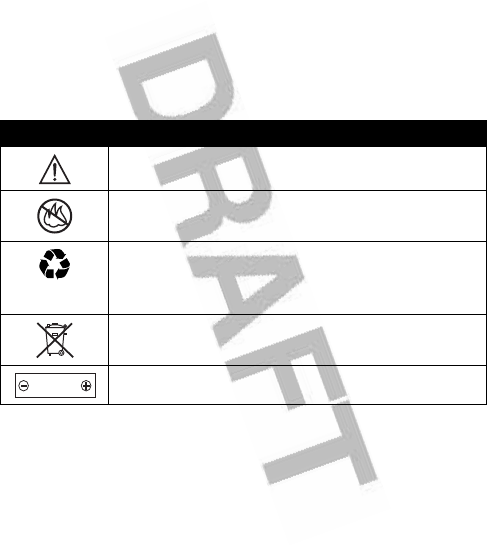
16
Batteries
Batteries can cause property damage and/or bodily injury such as burns if
a conductive material such as jewelry, keys, or beaded chains touch
exposed terminals. The conductive material may complete an electrical
circuit (short circuit) and become quite hot. Exercise care in handling any
charged battery, particularly when placing it inside a pocket, purse, or
other container with metal objects.
Use only Motorola original batteries
and chargers.
Your battery or phone may contain symbols, defined as follows:
Seizures/Blackouts
Some people may be susceptible to epileptic seizures or blackouts when
exposed to flashing lights, such as when watching television or playing
video games. These seizures or blackouts may occur even if a person
never had a previous seizure or blackout.
If you have experienced seizures or blackouts, or if you have a family
history of such occurrences, please consult with your doctor before
playing video games on your phone or enabling a flashing-lights feature
on your phone. (The flashing-light feature is not available on all products.)
Symbol Definition
Important safety information will follow.
Your battery or phone should not be disposed of in a
fire.
Your battery or phone may require recycling in
accordance with local laws. Contact your local
regulatory authorities for more information.
Your battery or phone should not be thrown in the
trash.
Your phone contains an internal lithium ion battery.
LiIon BATT

17
Parents should monitor their children's use of video game or other
features that incorporate flashing lights on the phones. All persons should
discontinue use and consult a doctor if any of the following symptoms
occur: convulsion, eye or muscle twitching, loss of awareness, involuntary
movements, or disorientation.
To limit the likelihood of such symptoms, please take the following safety
precautions:
•
Do not play or use a flashing-lights feature if you are tired or need
sleep.
•
Take a minimum of a 15-minute break hourly.
•
Play in a room in which all lights are on.
•
Play at the farthest distance possible from the screen.
Repetitive Motion Injuries
When you play games on your phone, you may experience occasional
discomfort in your hands, arms, shoulders, neck, or other parts of your
body. Follow these instructions to avoid problems such as tendonitis,
carpal tunnel syndrome, or other musculoskeletal disorders:
•
Take a minimum 15-minute break every hour of game playing.
•
If your hands, wrists, or arms become tired or sore while playing,
stop and rest for several hours before playing again.
•
If you continue to have sore hands, wrists, or arms during or after
play, stop playing and see a doctor.

18
Getting Started
Getting Started
About This Guide
This guide describes the basic features of your
Motorola wireless phone.
Optional Features
This label identifies an optional network, SIM
card, or subscription-dependent feature that
may not be offered by all service providers in all
geographical areas. Contact your service
provider for more information.
Optional Accessories
This label identifies a feature that requires an
optional Motorola Original™ accessory.
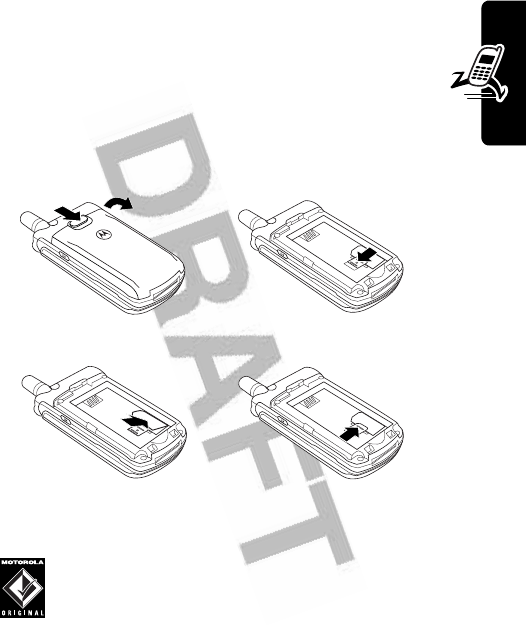
19
Getting Started
Installing the SIM Card
Your SIM (Subscriber Identity Module) card contains
your phone number, service details, and phonebook/
message memory.
Caution:
Do not bend or scratch your SIM card. Avoid
exposing your SIM card to static electricity, water, or dirt.
Installing the Battery
Your phone is designed to use only Motorola
Original batteries and accessories. We
recommend that you store batteries in their
protective cases when not in use.
1. 2.
3. 4.
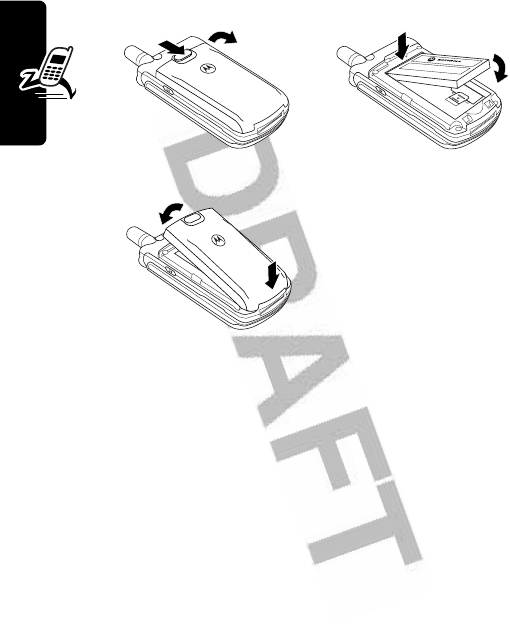
20
Getting Started
Charging the Battery
New batteries are shipped partially charged. Before you
can use your phone, you need to install and charge the
battery as described below. Some batteries perform best
after several full charge/discharge cycles.
1. 2.
3.
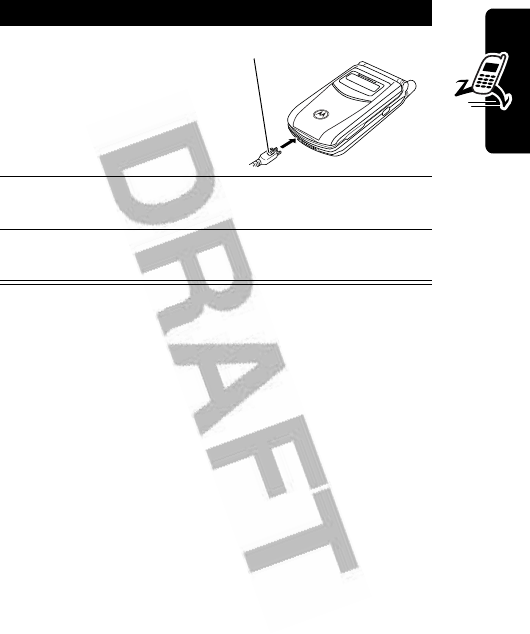
21
Getting Started
Tip:
You can safely leave the travel charger connected to
the phone after charging is complete. This will
not
damage
the battery.
Battery Use
Battery performance depends on many factors, including
your wireless carrier’s network configuration; signal
strength; the temperature at which you operate your
phone; the features and/or settings you select and use;
items attached to the phone’s accessory connector port;
and your voice, data, and other application usage patterns.
Caution:
To prevent injuries or burns, do not allow metal
objects to contact or short-circuit the battery terminals.
To maximize your battery’s performance:
•
Always use Motorola Original batteries and battery
chargers. The phone warranty does not cover damage
Action
1
Plug the travel charger
into your phone with the
release tab facing up.
2
Plug the other end of the travel charger into the
appropriate electrical outlet.
3
When your phone indicates
Charge Complete
, press
the release tab and remove the travel charger.
Release Tab

22
Getting Started
caused from using non-Motorola batteries and/or
battery chargers.
•
New batteries or batteries that have been stored
for a long time may require a longer charge time.
•
Maintain the battery at or near room temperature
when charging.
•
Do not expose batteries to temperatures below -10°C
(14°F) or above 45°C (113°F). Always take your
phone with you when you leave your vehicle.
•
When you do not intend to use a battery for a while,
store it uncharged in a cool, dark, dry place, such as a
refrigerator.
•
Over time, batteries gradually wear down and require
longer charging times. This is normal. If you charge
your battery regularly and notice a decrease in talk
time or an increase in charging time, then it is
probably time to purchase a new battery.
The rechargeable batteries that power this phone
must be disposed of properly and may need to
be recycled. Refer to your battery’s label for
battery type. Contact your local recycling center for proper
disposal methods. Never dispose of batteries in a fire
because they may explode.
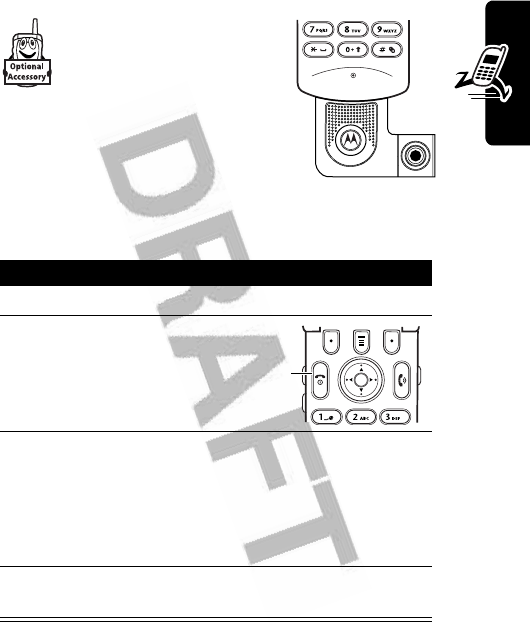
23
Getting Started
Attaching the Camera
Insert the optional
Motorola Original™ Digital
Camera into the accessory
connector port at the
bottom of your phone as shown.
For instructions on how to take and
send photos, see page 33.
Turning Your Phone On
Note:
If your phone displays
Personalize your phone?
, you can
select
YES
(
-
) to change your phone’s wallpaper, screen
saver, and other settings. You can also change these
settings from the home screen by pressing
Action
1
Open your phone
2
Press and hold
P
for 2 seconds to
turn on the phone
3
If necessary, enter your SIM card PIN code and
press
OK
(
+
) to unlock the SIM card
Caution:
If you enter an incorrect PIN code 3
times in a row, your SIM card is disabled and
your phone displays
SIM Blocked
.
4
If necessary, enter your 4-digit unlock code and
press
OK
(
+
) to unlock the phone
Power
key
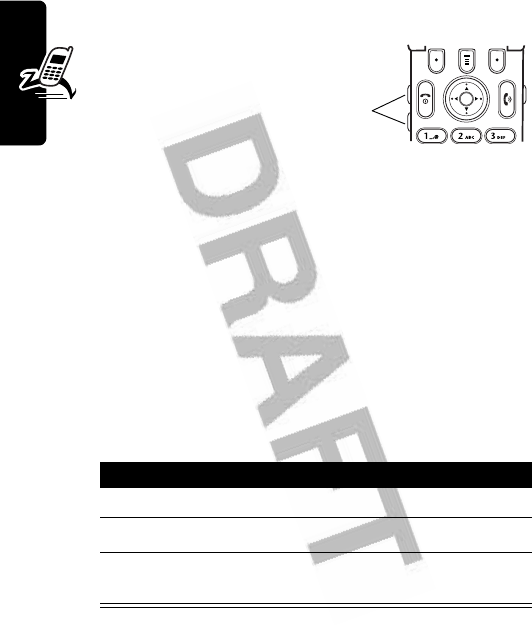
24
Getting Started
M
>
Settings
>
Personalize
. For settings details, see the
chapter that starts on page 123.
Adjusting
Volume
Press the up or down
volume keys to:
•
increase or decrease earpiece volume during a call
•
increase or decrease the ringer volume setting when
the home screen is visible (flip must be open)
Tip:
At the lowest volume setting, press the down
volume key once to switch to vibrate alert. Press it
again to switch to silent alert. Press the up volume key
to cycle back to vibrate alert, then ring alert.
•
turn off an incoming call alert
Making a Call
Tip:
You can also close the phone flip to end the call.
Press To
1
keypad keys dial the phone number
2
N
make the call
3
O
end the call and “hang up” the
phone when you are finished
Volume
keys
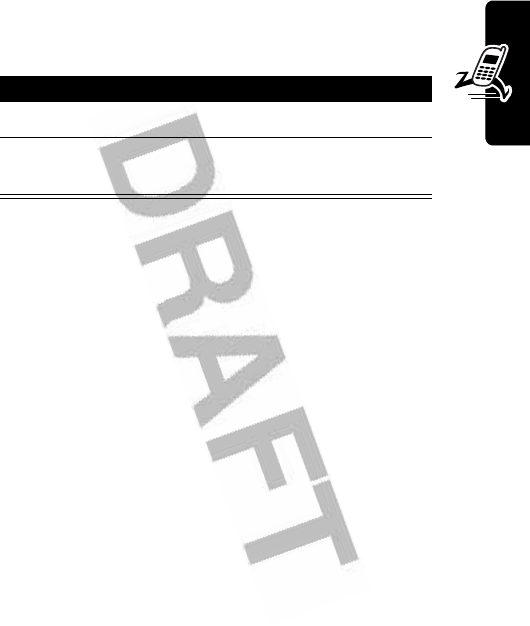
25
Getting Started
Answering a Call
When you receive a call, your phone rings and/or
vibrates and displays an incoming call message.
Tip:
When the phone flip is active, open the phone to
answer the call. To activate the flip, press
M
>
Settings
>
In-Call Setup
>
Answer Options
>
Open to Answer
>
On
.
Viewing Your Phone Number
To view your phone number from the home screen, press
M#
.
While you are on a call, press
M
>
My Tel. Numbers
.
Note:
Your phone number must be stored on your SIM
card to use this feature. To store your phone number on
the SIM card, see page 61. If you do not know your phone
number, contact your service provider.
Press To
1
N
or
ANSWER
(
+
)answer the call
2
O
or close the
phone flip
end the call and “hang up” the
phone when you are finished
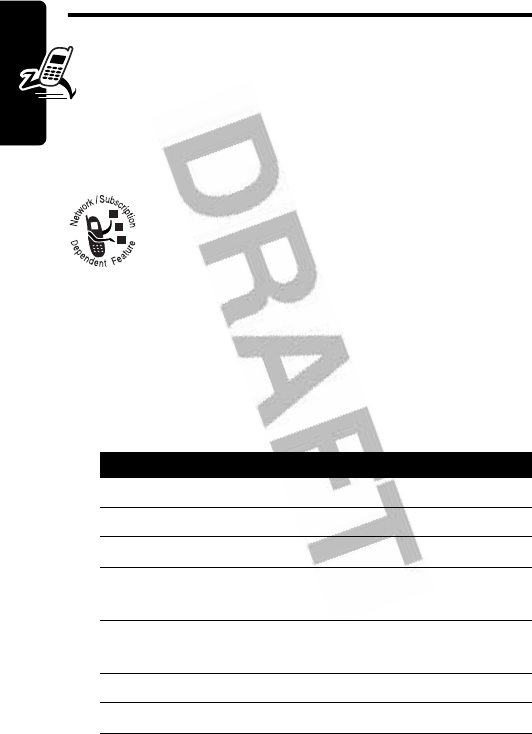
26
Highlight Features
Highlight Features
You can do much more with your phone than make and
receive calls! This section describes some of your
phone’s highlight features.
Sending a Multimedia Message
A Multimedia Messaging Service (MMS)
multimedia message contains one or more
slides with text and embedded media objects
(including photos, pictures, animations, sounds,
and/or voice records). You can send the multimedia
message to other wireless phone users, and to email
addresses.
Find the Feature
M
>
Messages
>
Create Message
>
New MMS
Press To
1
keypad keys enter slide text
2
M
open the menu
3
S
scroll to
Insert
4
SELECT
(
+
) display a list of items you can
insert
5
S
scroll to
Picture
,
Voice Record
,
Sound
,
Quick Note
, or
Contact Info
6
SELECT
(
+
) select the file type
7
S
select the file you want
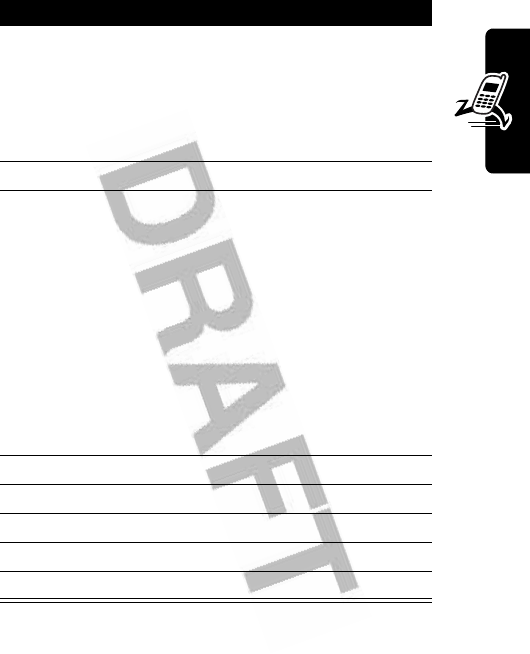
27
Highlight Features
8
SELECT
(
+
) insert the file
Tip: To insert another slide,
select
M
>
Insert
>
New Page
.
Repeat steps 1 to 8 to enter
contents for the new slide
9
OK
(
+
) open the recipient list
10
S
Scroll to
[One Time Entry]
and
press
SELECT
(
+
) to enter a
recipient phone number.
After you enter the number,
press
OK
(
+
) to store it.
or
Scroll to phonebook entries
and press
ADD
(
+
) to select
them. Press
DONE
(
+
) to store
them.
11
S
scroll to
Subject
12
CHANGE
(
-
)select
Subject
13
keypad keys enter the subject
14
OK
(
+
) store the subject
15
SEND
(
+
) send the message
Press To

28
Highlight Features
Receiving a Multimedia
Message
When you receive a multimedia message or
letter, your phone displays the
X
(message
waiting) indicator and a
New Message
notification, and sounds an alert.
Multimedia messages that you receive can contain
different media objects:
•
Photos, pictures, and animations are displayed as you
read the message.
•
A sound file begins playing when its slide is displayed.
Use the volume keys to adjust the volume as the
sound file plays.
Note:
In a multimedia letter, you may have to highlight
an indicator embedded in the text to play a sound file.
•
Attached files are appended to the message. To open
the attachment, highlight the file indicator/filename
and press
VIEW
(
+
) (image file type),
PLAY
(
+
) (sound
file), or
OPEN
(
+
) (vObject or unknown file type).
Sending an Email Message
You can send an email message to 1 or more recipients.
You can manually enter each recipient’s email address, or
select addresses from the phonebook.
Press To
READ
(
+
) open the message
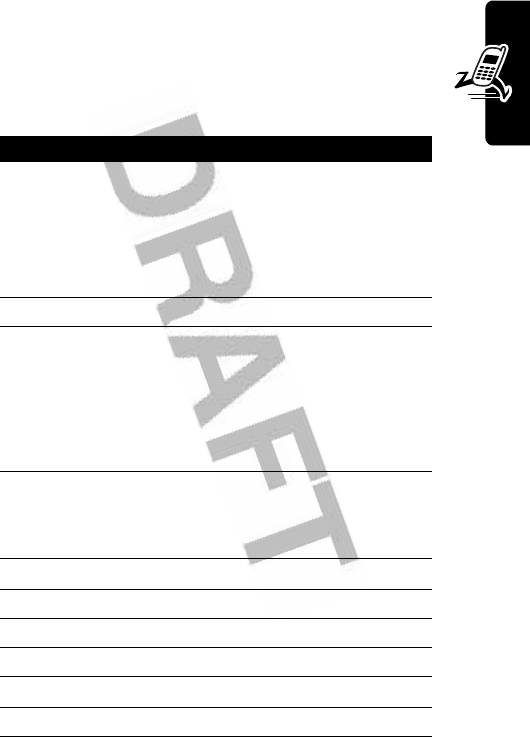
29
Highlight Features
When you manually enter email addresses, you must
insert a comma, semicolon, or colon between each
address.
Find the Feature
M
>
Messages
>
Create Message
>
New Email
Press To
1
keypad keys enter text for the message
Tip:
To insert a quick note,
picture, sound, or voice
record, press
M
>
Insert Options
(see page 30).
2
OK
(
+
) store the message
3
keypad keys
or
PH. BOOK
(
+
)
enter one or more phone
email addresses
select addresses from the
phonebook
4
OK
(
+
) store the addresses
Tip:
You can also store
addresses in
Cc
and
Bcc
5
S
scroll to
Subject
6
CHANGE
(
-
)select
Subject
7
keypad keys enter the subject
8
OK
(
+
) store the subject
9
S
scroll to
Attachments
10
CHANGE
(
-
)select
Attachments
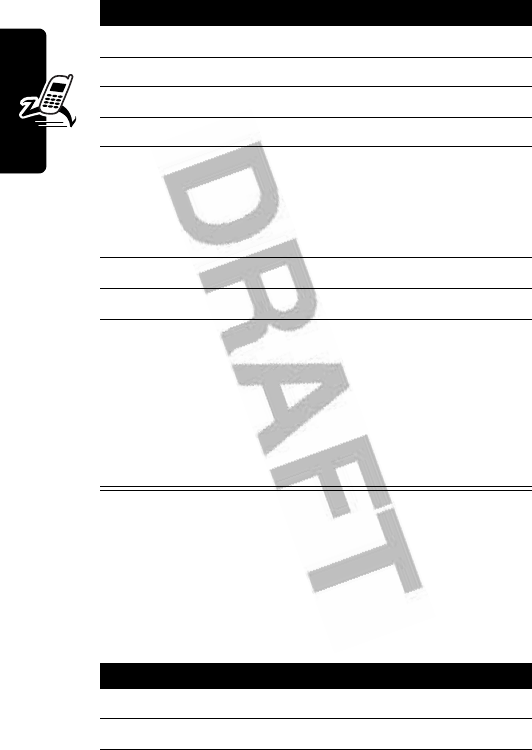
30
Highlight Features
Inserting Items in Email Text
You can insert media elements into the email message as
you type it. Photos, pictures, and animations display in the
message. Sounds are represented by a sound file
indicator.
11
S
scroll to
Picture
or
Sounds
12
SELECT
(
+
) select the file type
13
S
select the file you want
14
SELECT
(
+
) attach the file
15
BACK
(
-
) return to the email form
Tip:
To add more
attachments, select
[New Attachment]
16
S
scroll to
Priority
17
S
(left or right) scroll to
Normal
or
Urgent
18
SEND
(
+
)
or
M
send the message
save the message in the
drafts folder, view message
details, or cancel the
message
Press To
1
M
open the menu
2
S
scroll to
Insert Options
Press To
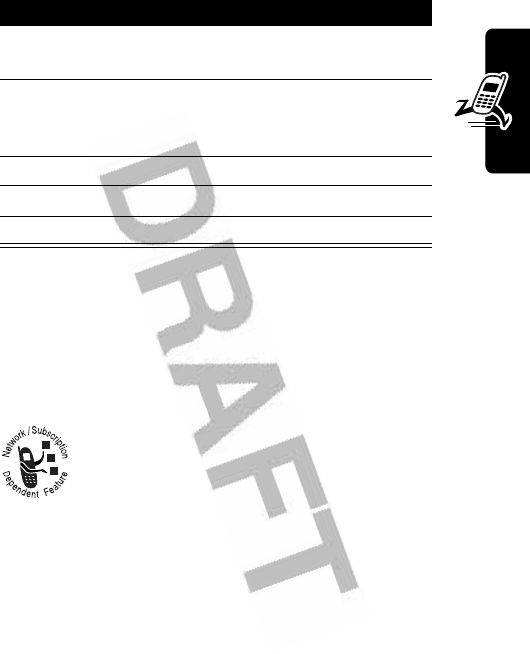
31
Highlight Features
Using Photos and Pictures
You can send your photos to other wireless phone users or
email addresses, assign photos to specific phonebook
entries, and use them as wallpaper or screen saver
images.
Your phone may contain predefined photos,
pictures, and animations. You can download and
store additional images on your phone.
Downloading Pictures
To download a picture with mMode, see page 183. To store
a picture from a message, see page 88.
Managing Pictures
Note:
Predefined images are identified by a
ë
(predefined object) indicator. You cannot rename, delete,
or view details about predefined images.
3
SELECT
(
+
) display a list of items you can
insert
4
S
scroll to
Quick Note
,
Picture
,
Sounds
,
Voice Record
, or
Contact Info
5
SELECT
(
+
) select the file type
6
S
select the file you want
7
SELECT
(
+
) insert the file
Press To
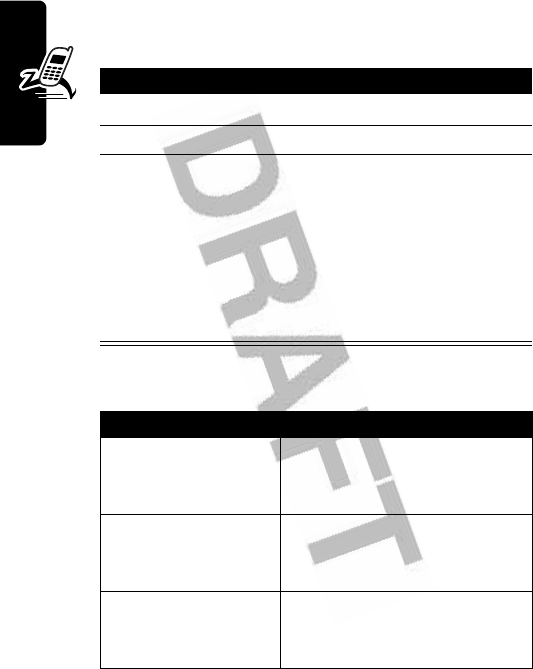
32
Highlight Features
To view a photo, picture, or animation stored on your
phone:
The
Pictures Menu
can include the following options:
Find the Feature
M
>
Multimedia
>
Pictures
Press To
1
S
scroll to the picture
2
VIEW
(
+
) view the picture
3
S
up or down
or
DETAILS
(
+
)
or
M
view the next/previous picture
view picture information
open the
Pictures Menu
to
perform other procedures
Option Description
Send In Message
Insert selected picture or
marked picture(s) in a new
MMS
or
Email
message.
New Photo Alb Msg
Insert selected picture or
marked picture(s) in a new
Photo Album
message.
Apply As
Set the picture as your
phone’s wallpaper or screen
saver image.
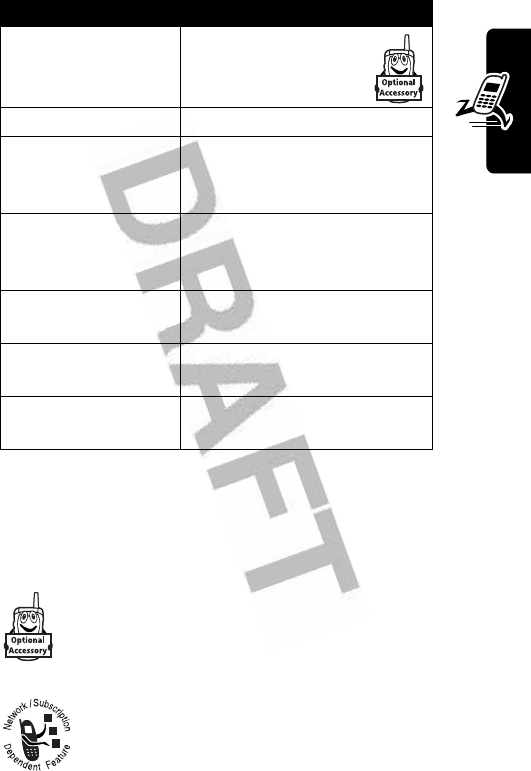
33
Highlight Features
To adjust your phone’s wallpaper and screen saver
images, see page 63 and page 64.
Taking and Sending a Photo
You can take photos with your phone using the
optional Motorola Original™ Digital Camera
accessory, and use them as wallpaper or screen
saver images.
You can also send your camera photos to others
as Multimedia Messaging Service (MMS)
New
Activate the camera
accessory to take a
photo.
Details
View picture information.
Mark/Unmark
or
Mark All/Unmark All
Mark 1 or more pictures that
you want to move, copy,
send, or delete.
Categories
Create a new category, or
view pictures in a selected
category.
Pictures Setup
Open the setup menu to
adjust picture settings.
mMode Downloads
Launch mMode to download
a picture.
View Free Space
View memory space
available for storing pictures.
Option Description
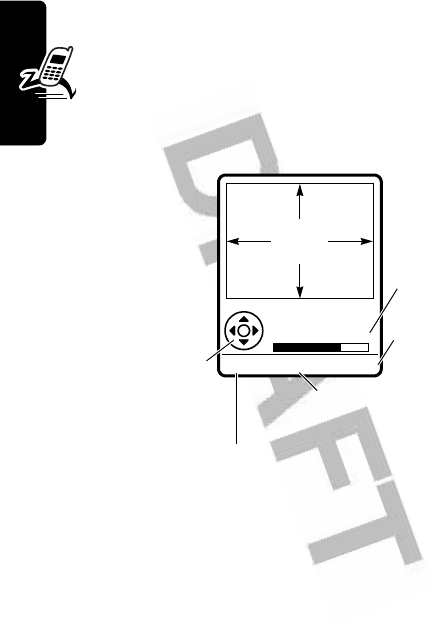
34
Highlight Features
picture messages.
Attach the camera as described on page 23 and follow
these steps:
The active viewfinder image appears on your display.
Find the Feature
M
>
Multimedia
>
Camera
BACK
M
CAPTURE
Photo Viewfinder
Memory Used:72%
Photo storage
memory space
currently in use.
Return to previous screen.
Press
S
left or
right to
decrease or
increase image
brightness. Press
M
to open
Pictures Menu
.
Take a photo.
IMAGE
AREA
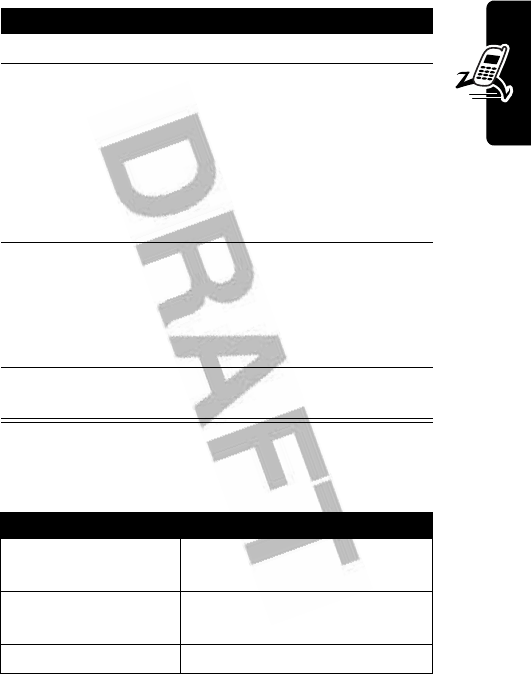
35
Highlight Features
Point the camera lens at the photo subject, then:
When the camera is active, the
Pictures Menu
can include the
following options:
Press To
1
CAPTURE
(
+
) take a photo
2
STORE
(
+
)
or
DISCARD
(
-
)
view storage options
delete the photo and return to
active viewfinder
If you choose to store the
photo, continue to step 3.
3
S
scroll to
Send in Message
,
Send to Photo Alb.
,
Store Only
,
Apply as Wallpaper
,
Apply as Screen Saver
, or
Apply as Phonebook
4
SELECT
(
+
) perform the storage option of
your choice
Option Description
Go To Pictures
View pictures and photos
stored on your phone.
Auto-Timed Capture
Set a timer for the camera to
take a photo.
Delete All
Delete all pictures.
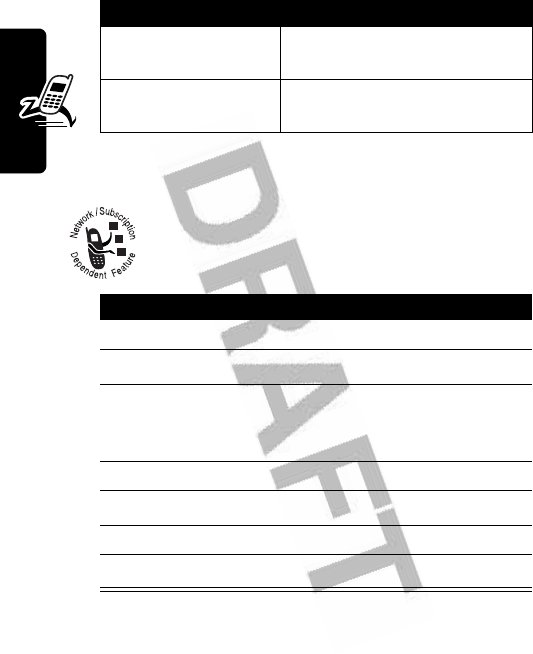
36
Highlight Features
Making a Conference Call
Connect an active call and a call on hold so that
all parties can speak to each other.
Tip:
Repeat steps 3 to 6 to add additional parties to the
conference call.
Synchronizing Data
You can synchronize phonebook and datebook information
between your phone, computer, and PDA with BVRP
Pictures Setup
Open the setup menu to
adjust picture settings.
View Free Space
See how much memory
remains for storing pictures.
Press To
1
keypad keys dial the first party’s number
2
N
call the number
3
HOLD
(
+
)
(if available) or
M
>
Hold
put the call on hold.
4
keypad keys dial the next party’s number
5
N
call the number
6
LINK
(
-
) connect the 2 calls
7
O
end the conference call
Option Description
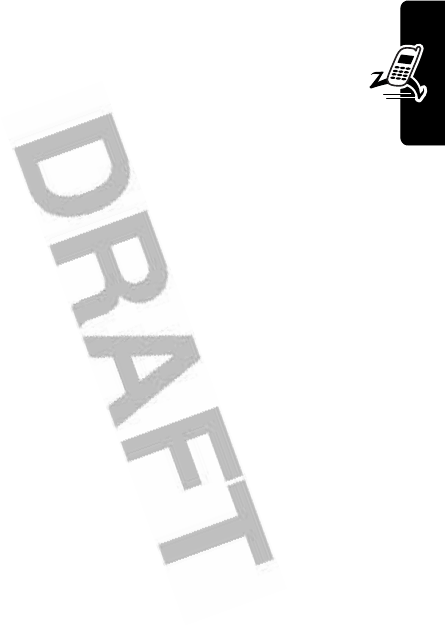
37
Highlight Features
Mobile PhoneTools software, included with your phone.
See the Mobile PhoneTools user’s guide for more
information.
Note:
BVRP Mobile PhoneTools software is designed
to synchronize with basic features of many popular
Personal Information Management (PIM) software and
hardware products.
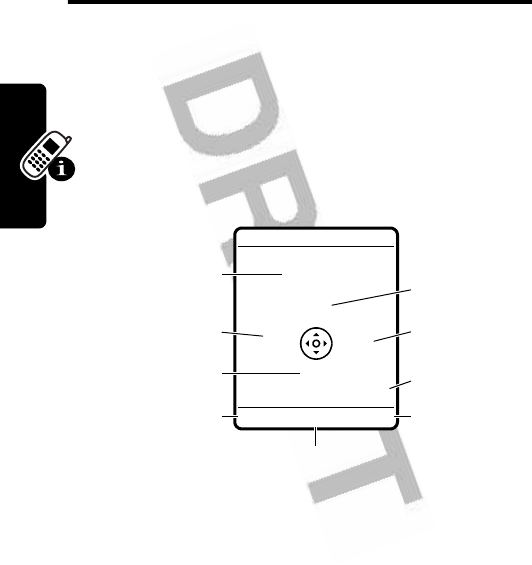
38
Learning to Use Your Phone
Learning to Use Your
Phone
See page 1 for a basic phone diagram.
Using the Display
The home screen is displayed when you are
not
on a
call or using the menu. You must be in the home screen
to dial a phone number.
Press the 5-way navigation key (
S
) left, right, up, or down
to display and select 1 of the menu feature icons in the
home screen. If you select a menu icon by mistake, press
O
to return to the home screen.
STYLES
M
mMode
Service Provider
10/15/04
10:08am
n
Q
w
e
@Ñ(yÉ
Clock
Menu Indicator
Left Soft Key
Label
Date
Right Soft Key
Label
Settings
Phonebook
Games
Messages
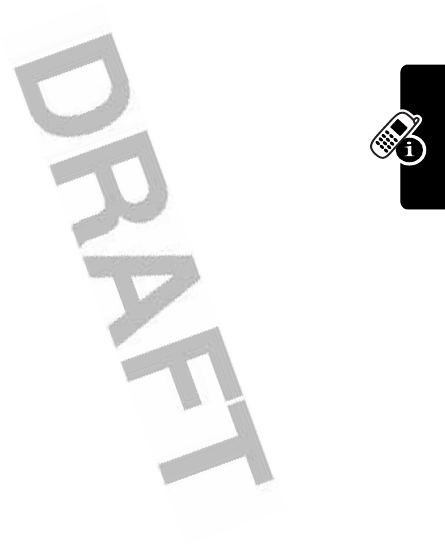
39
Learning to Use Your Phone
Notes:
•
Your service provider may customize the home screen
so that it looks different than the display shown above.
For example, your service provider may hide the
home screen menu icons to allow a better view of the
wallpaper image. You can still select the menu icons
when they are hidden from view. To show or hide the
menu icons, see page 126.
•
Your display may time out to save battery power. If
your display appears blank, press any key to
reactivate it.
The
e
(menu) indicator in the bottom center of the display
indicates you can press the menu key (
M
) to enter the
main menu.
Labels at the bottom corners of the display show the
current soft key functions. Press the left soft key (
-
) or
right soft key (
+
) to perform the function indicated by the
left or right soft key label.
Your phone can display an analog or digital clock in the
home screen (see page 126).
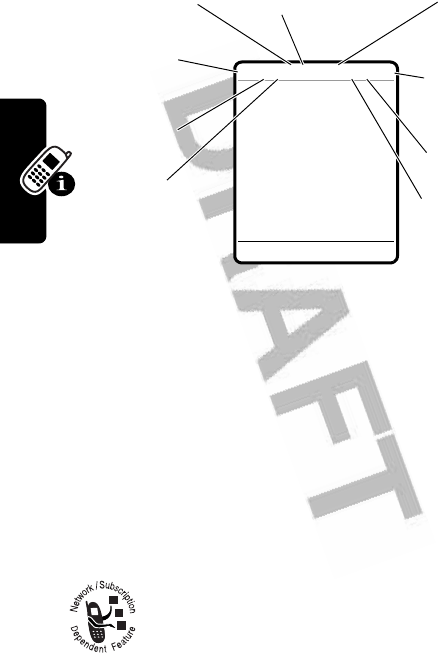
40
Learning to Use Your Phone
The following status indicators can display:
1. Data Transmission Indicator
Shows connection and
data transmission status. Indicators can include:
2. GPRS Indicator
Shows that your phone is
using a high-speed General Packet Radio
4
= secure packet
data transfer
7
= unsecure packet
data transfer
3
= secure
application
connection
6
= unsecure
application
connection
2
= secure Circuit
Switch Data
(CSD) call
5
= unsecure CSD
call
STYLES
M
mMode
Service Provider
10/15/04
10:08am
2.
GPRS
3.
Signal
Strength
6.
Message
7.
Battery
Level
1.
Data
Transmission
4.
Roam
5.
Active
Line
8.
Ring Alert
9.
Location
+49@ Ñr(yÉ
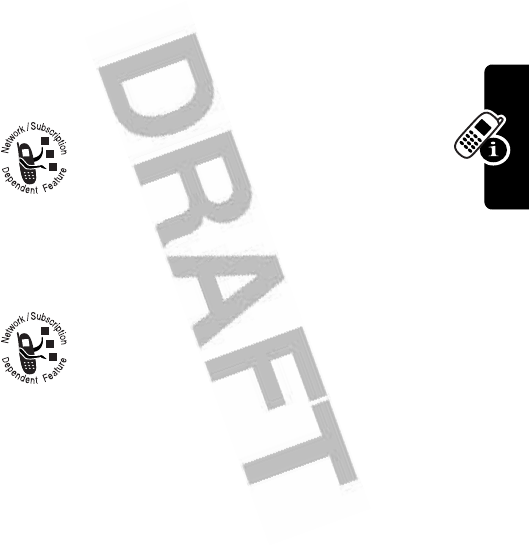
41
Learning to Use Your Phone
Service (GPRS) network connection. GPRS allows faster
data transfer speeds. Other indicators can include:
3. Signal Strength Indicator
Vertical bars show the
strength of the network connection. You cannot make or
receive calls when the
!
(no signal) indicator or
)
(no
transmit) indicator is displayed.
4. Roam Indicator
Shows when your
phone is seeking or using another network
outside your home network. Indicators can
include:
5. Active Line Indicator
Shows
@
or
B
to
indicate the current active phone line. Other
indicators can include:
*
= GPRS PDP
context active
,
=GPRS packet
data available
8
=2.5G home
9
=2.5G roam
:
=2G home
;
=2G roam
A
= line 1 active,
call forward on
C
= line 2 active, call
forward on
E
= alarm activated

42
Learning to Use Your Phone
6. Message Indicator
Displays when you
receive a new message. Indicators can include:
When you enter a multimedia message, a number in
this location indicates the size of the message.
7. Battery Level Indicator
Vertical bars show the
battery charge level. Recharge the battery when
Low Battery
displays and the battery alert sounds.
8. Ring Alert Indicator
Shows the ring alert setting.
9. Location Indicator
Your phone may be able
to send location information to the network
during an emergency call. Indicators show when
your phone is sending location information:
Using the 5-Way
Navigation Key
Use the 5-way navigation key
(
S
) to:
•
scroll up, down, left, or right through the menu system
r
= text message
t
= voicemail
message
s
= voicemail and
text message
t
= answering
machine
y
= loud ring
z
= soft ring
|
=vibrate
}
= vibrate and ring
{
= silent
Ö
= location on
Ñ
= location off
5-way
Navigation
key
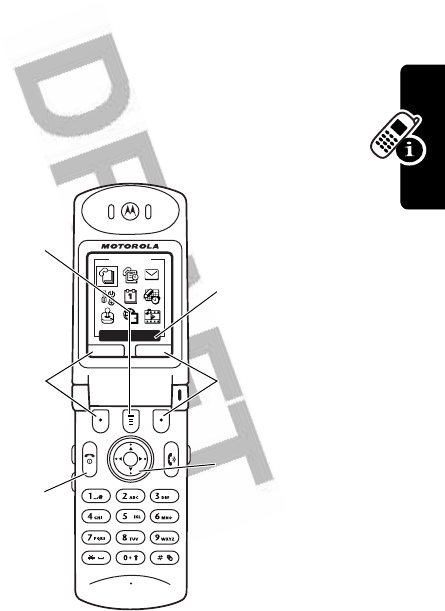
43
Learning to Use Your Phone
•
highlight menu items
•
change feature settings
•
play games
Press the center select button to select a highlighted menu
item. The center select button usually performs the same
function as the right soft key (
+
).
Using Menus
From the home screen, press
M
to enter the main
menu.
EXIT SELECT
Main Menu
Phonebook
Current
selection.
End Key
Exit menu
without making
changes.
Left Soft Key
Perform left
function.
Menu Key
Enter menu
system, or open
a sub-menu.
5-Way
Navigation Key
Scroll
up
,
down
,
left
, or
right
.
Press center
select button to
perform right soft
key function.
Right Soft Key
Perform right
function.
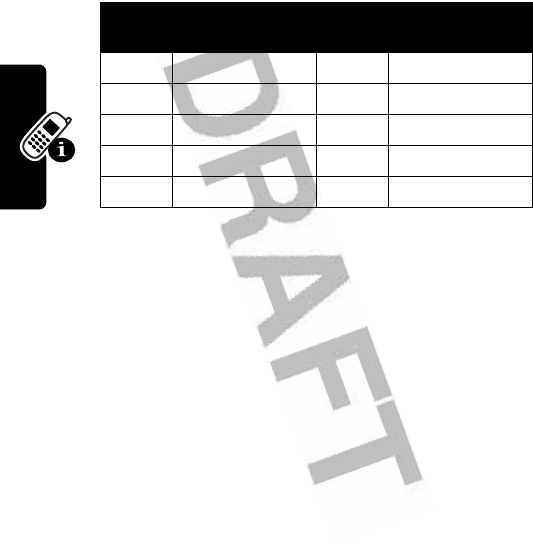
44
Learning to Use Your Phone
Press
S
to scroll to and highlight a menu feature icon in
the main menu. The following icons represent features that
may appear in the main menu, depending on your service
provider and service subscription options.
Selecting a Menu Feature
This guide shows you how to select a menu feature,
starting from the home screen.
This example shows that from the home screen, you must
press
M
, scroll to and select
s
Recent Calls
from the main
menu, then scroll to and select
Dialed Calls
. Press
S
to
scroll, and the left/right soft keys to select the functions
listed in the bottom left and right corners of the display.
Menu
Icon Feature
Menu
Icon Feature
Q
Games & Apps
h
Multimedia
É
Tools
w
Settings
n
Phonebook
á
Web Access
e
Messages
s
Recent Calls
M
Datebook
Find the Feature
M
>
Recent Calls
>
Dialed Calls
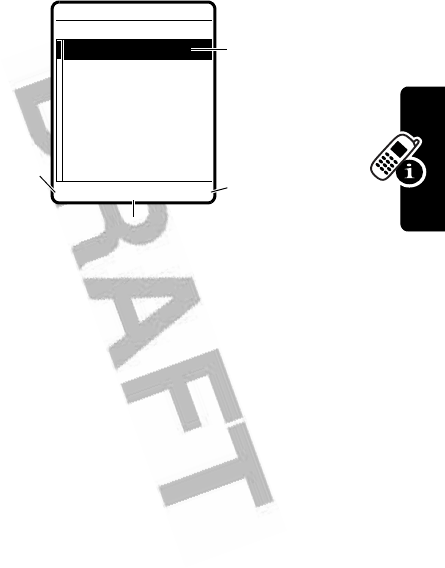
45
Learning to Use Your Phone
Selecting a Feature Option
Some features require you to select an option from a list:
•
Press
S
to scroll up or down to highlight the option
you want.
•
In a numbered list, press a number key to highlight the
option.
•
In an alphabetized list, press a key repeatedly to cycle
through the letters on the key and highlight the closest
matching list option.
•
When an option has a list of possible values, press
S
left or right to scroll through and select a value.
•
When an option has a list of possible numeric values,
press a number key to set the value.
BACK
M
VIEW
Dialed Calls
10) John Smith
9) Lisa Owens
8) Adda Thomas
7) Jack Bradshaw
6) Dave Thompson
5) John Smith
4) John Smith
Press
BACK
(
-
)
to go back to
previous
screen.
Highlighted
Option
Press
M
to open sub-menu.
Press
VIEW
(
+
)
to view details
of highlighted
option.
@(yÉ
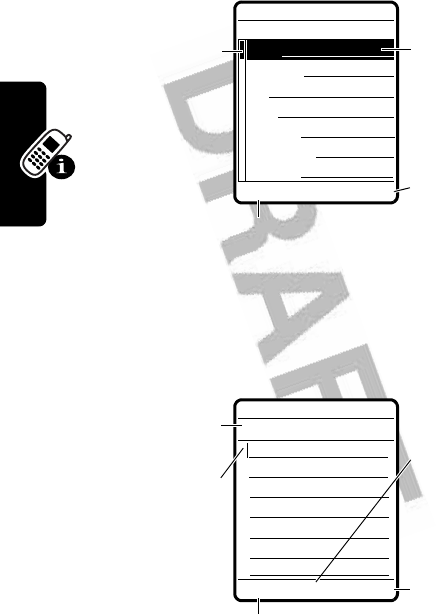
46
Learning to Use Your Phone
Entering Text
Some features require you to enter information.
The message center lets you compose and send text
messages.
CANCEL CHANGE
Entry Details
Name: John Smith
Category: General
No.: 2125551212
Type: Work
Store To: Phone
Voice Name:
Speed No.: 2 #(P)
$
Press
CANCEL
(
-
) to exit without making
changes.
DONE
(
-
) displays when you
enter or edit information.
Press
CHANGE
(
+
) to
enter or edit
information.
Press
S
to
scroll down to
other options.
Highlighted
Option
@(yÉ
CANCEL
M
INSERT
Msg
Press
INSERT
(
+
)
to insert a quick
note, picture, or
sound.
Press
CANCEL
(
-
) to exit without
making changes.
Press
M
to open
sub-menu.
Flashing cursor
indicates
insertion point.
For indicator
information, see
page 47.
@(yÉ
450
Vh
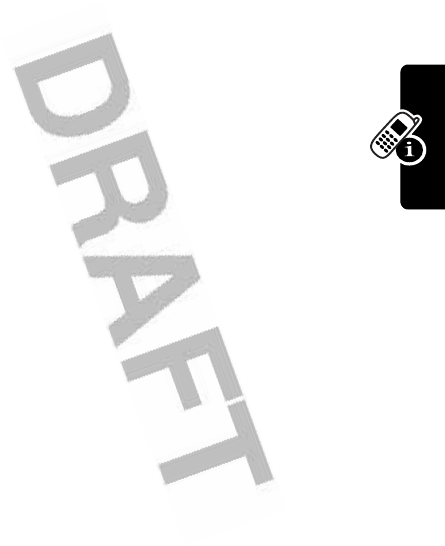
47
Learning to Use Your Phone
Choosing a Text Entry Method
Multiple text entry methods make it easy for you to enter
names, numbers, and messages. The method you select
remains active until you select another method.
Press
#
in any text entry screen to change to 1 of the
following entry methods:
In a text entry screen, an indicator shows the text entry
method:
Numeric
(
W
),
Symbol
(
[
),
Primary
, or
Secondary
:
Primary
The primary text entry method (see
below).
Numeric
(
W
) Enter numbers only (see page 55).
Symbol
(
[
) Enter symbols only (see page 54).
Secondary
The secondary text entry method
(see below).
Primary
Secondary
g
m
Tap, no capital letters
h
q
Tap, capitalize next letter
only
f
l
Tap, all capital letters
j
p
iTAP, no capital letters
k
n
iTAP, capitalize next
letter only
i
o
iTAP, all capital letters
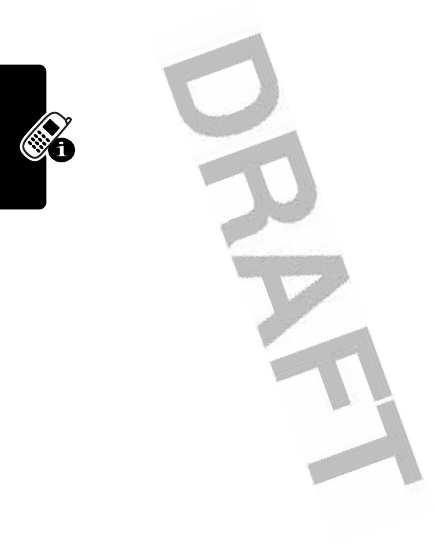
48
Learning to Use Your Phone
Using Capitalization
Press
0
in any text entry screen to change text case.
The following indicators show capitalization status:
Setting Up a Text Entry Method
Press
M
>
Entry Setup
from any text entry screen. Select
Primary Setup
or
Secondary Setup
, and choose:
Using the iTAP™ Method
iTAP™ software provides a predictive text entry method
that lets you enter a word using 1 keypress per letter. This
can be faster than
Tap
method, because your phone
combines the keypresses into common words.
U
= no capital letters
V
= capitalize next
letter only
T
= all capital letters
iTAP
Let the phone predict each word as
you press keys (see page 48).
Tap
Enter letters and numbers by pressing
a key 1 or more times.
Tap Extended
Enter letters, numbers, and symbols
by pressing a key 1 or more times.
None
Hide the
Secondary
setting (only
available for
Secondary Setup
).
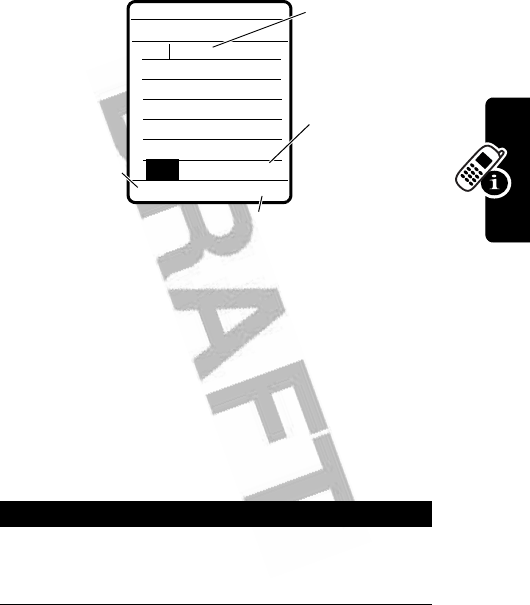
49
Learning to Use Your Phone
For example, if you press
7
7
6
4
, letter
combinations that match your keypresses display:
If you want a different word (such as
Progress
), continue
pressing keypad keys to enter the remaining characters.
Entering Words
In a text entry screen, you can press
#
to switch entry
methods. An indicator tells you which method is active
(see page 42). If
iTAP
method is not available as the
Primary
or
Secondary
entry method, see page 48.
Press To
1
keypad keys
(1 press per
letter)
show possible letter
combinations at the bottom of
the display
DELETE SELECT
Prog ram
,
Prog Proh Spoi
}
Msg
@(yÉ
442
Press
DELETE
(
-
)
to delete last
letter.
Press
S
up to
accept
Program
.
Press
SELECT
(
+
) to lock
highlighted combination.
Press
S
right
to highlight
another
combination.
Press
*
to
enter
Prog
and a
space.
Vn
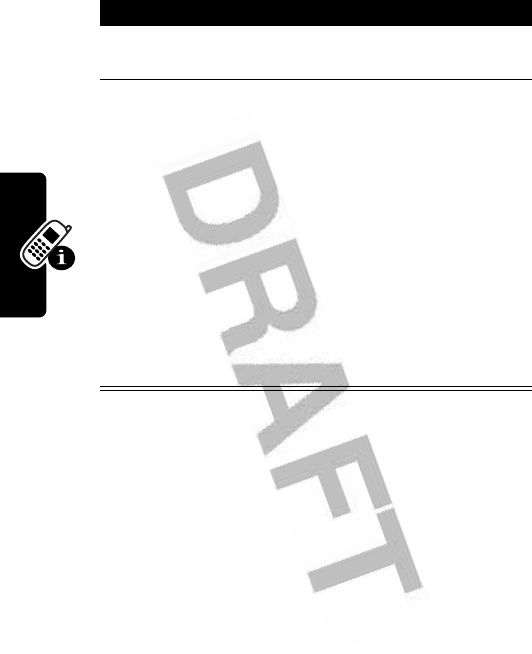
50
Learning to Use Your Phone
If you enter a word your phone does not recognize, the
phone stores it to use as 1 of your word options. When you
fill memory space for unrecognized words, your phone
deletes the oldest words to add new words.
Using the Tap Method
This is the standard method for entering text on your
phone.
Regular
Tap
method cycles through the letters and number
of the key you press.
Tap Extended
method also cycles
2
S
left or right highlight the combination you
want
3
SELECT
(
+
)
or
*
lock a highlighted
combination
You can press keypad keys to
add more letters to the end of
the combination.
enter the highlighted
combination when it spells a
word
A space is automatically
inserted after the word.
Press To
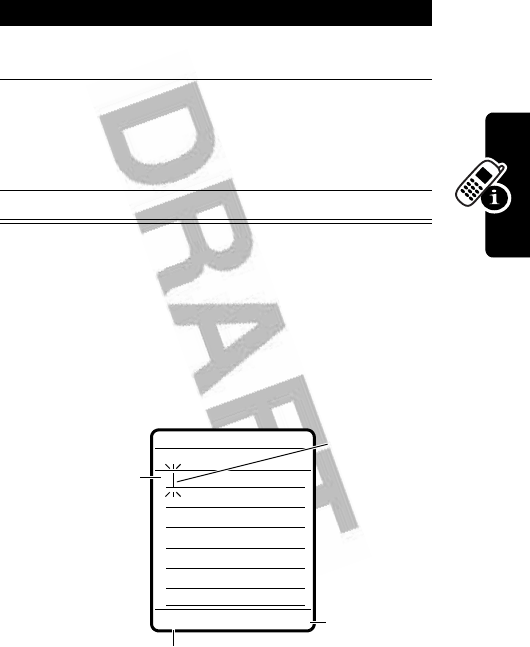
51
Learning to Use Your Phone
through additional symbols as shown in the “Character
Chart” on page 52.
In a text entry screen, you can press
#
to switch entry
methods. An indicator shows which method is active (see
page 42). If
Tap
or
Tap Extended
is not available as the
Primary
or
Secondary
entry method, see page 48.
When you enter text with the
Tap
or
Tap Extended
method, the
soft key functions change.
Press To
1
A keypad key 1
or more times
select a letter, number, or
symbol
2
Keypad keys enter remaining characters
Tip:
Press
S
right to accept
a word completion, or
*
to
insert a space.
3
OK
(
+
)store the text
Vh
DELETE
M
OK
T
Msg
@(yÉ
449
After 2
seconds,
character is
accepted and
cursor moves to
next position.
Press
DELETE
(
-
) to delete character
to left of insertion point.
Character
displays at
insertion point.
Press
OK
(
+
) to
accept and
store text.
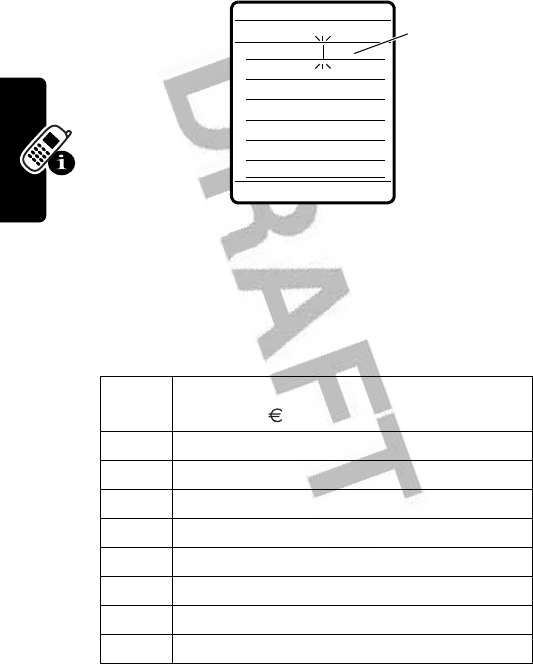
52
Learning to Use Your Phone
When you enter 3 or more characters in a row, your phone
may guess the rest of the word. For example, if you enter
prog
you might see:
If you want a different word (such as
progress
), continue
pressing keypad keys to enter the remaining characters.
Character Chart
Use this chart as a guide for entering characters with the
Tap Extended
method.
1
. ? ! , @ ' - _ : ; ( ) & " ~ 1 0 ¿ ¡ %
£ $ ¥ ¤ + x * / \ [ ] = > < # §
2
a b c 2 á à â ã ç æ
3
d e f 3 é è êë
4
g h i 4 í î ï
5
j k l 5
6
m n o 6 ñ ó ò ô õ œ
7
p q r s 7
8
t u v 8 ú ù ûü
9
w x y z 9
DELETE
M
OK
This is a prog ram
Msg
@(yÉ
433
Press
S
right
to accept
Program
, or
press
*
to
reject it and
enter a space
after
prog
.
Vh
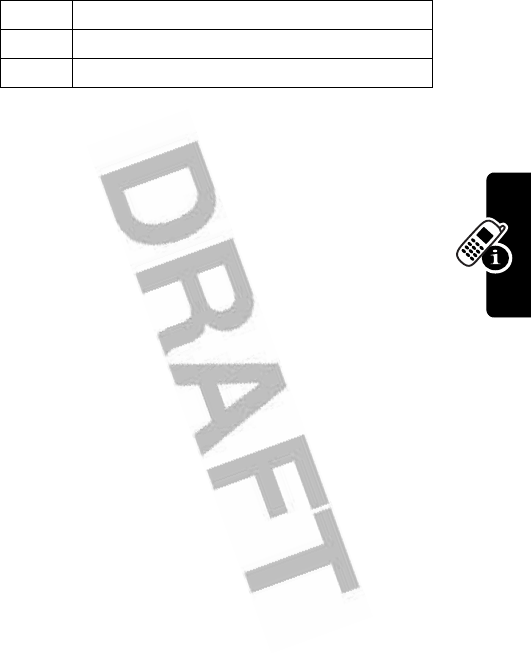
53
Learning to Use Your Phone
Note:
This chart may not reflect the exact character set
available on your phone. In an email address or URL
editor,
1
first shows the common characters for that
editor.
Tap Method Text Entry Rules
•
Press a keypad key repeatedly to cycle through its
characters.
•
Press
S
left or right to move the flashing cursor to
the left or right in a text message.
•
The first character of every sentence is capitalized. If
necessary, press
S
down to force the character to
lowercase before the cursor moves to the next
position.
•
If you enter or edit information and do not want to save
the changes, press
O
to exit without saving.
0
change text case, for capital letters
*
enter a space (hold to enter a return)
#
change text entry method (hold for default)
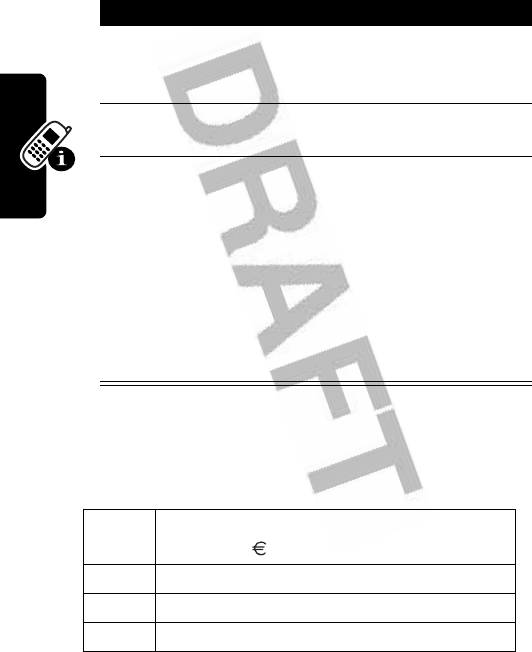
54
Learning to Use Your Phone
Using the Symbol Method
In a text entry screen, press
#
to switch entry methods
until the
[
(symbol) indicator displays.
Symbol Chart
Use this chart as a guide for entering characters with
symbol method.
Press To
1
Keypad keys
(1 press per
symbol)
show possible symbol
combinations at the bottom of
the display
2
S
left or right highlight the combination you
want
3
SELECT
(
+
)
or
*
lock a highlighted
combination
You can press keypad keys to
add more symbols to the end
of the combination.
enter the highlighted symbol
followed by a space
1
. ? ! , @ ' - _ : ; - ( ) & " ~ 1 0 ¿ ¡ %
£ $ ¥ ¤ + x * / \ [ ] = > < # §
2
@ _ \
3
/ : ;
4
" & '
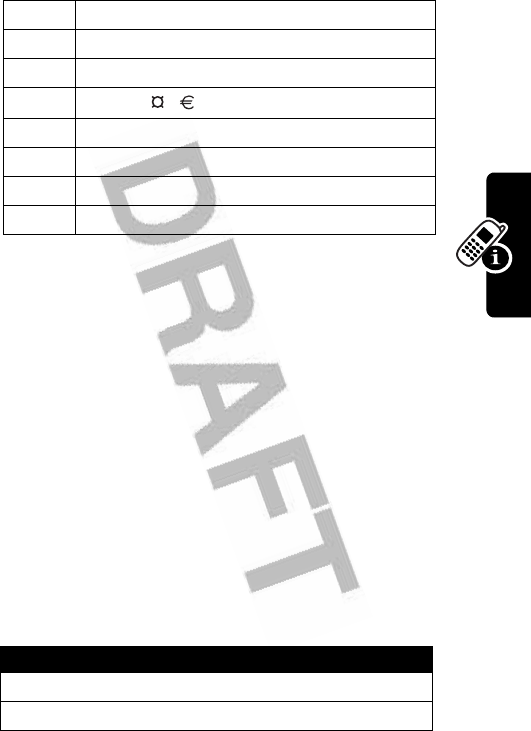
55
Learning to Use Your Phone
Note:
This chart may not reflect the exact character set
available on your phone. In an email address or URL
editor,
1
first shows the common characters for that
editor.
Using the Numeric Method
In a text entry screen, press
#
to switch entry methods
until the
W
(numeric) indicator displays.
Press keypad keys to enter the numbers you want. When
you finish entering numbers, press
#
to switch to another
entry method.
Deleting Letters and Words
Place the cursor to the right of the text you want to delete,
and then:
5
( ) [ ] { }
6
¿ ¡ ~
7
< > =
8
$ £ ¥
9
# % *
0
+ - x * / \ [ ] = > < # §
*
enter a space (hold to enter a return)
#
change text entry method (hold for default)
Action
Press
DELETE
(
-
) to delete 1 letter at a time.
Hold
DELETE
(
-
) to delete the entire message.
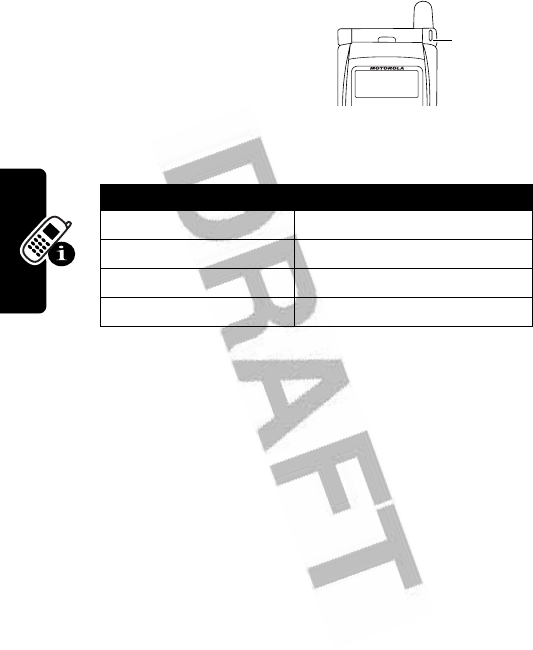
56
Learning to Use Your Phone
Using the Status
Light
The status light shows when
you have an incoming call or
message, or when your phone is roaming (using a
non-home system).
You can turn off the status light to extend battery life and
increase your phone’s standby time, the length of time that
your phone’s battery retains power when the phone is
turned on but is not in use.
To turn the status light on or off:
Using the External Display
When the flip is closed, the external display shows time
and phone status information. It also displays messages to
notify you of incoming calls and other events. See page 40
for descriptions of the status indicators that may appear in
the external display.
Indication State
alternating red/green incoming call
flashing green in service, home system
flashing yellow roaming, non-home system
flashing red no service
Find the Feature
M
>
Settings
>
Initial Setup
>
Status Light
Status
light
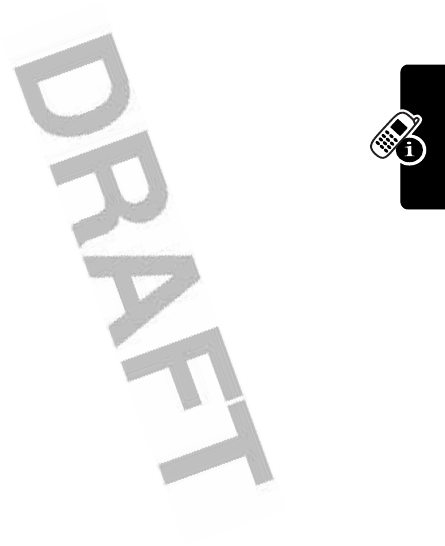
57
Learning to Use Your Phone
Changing a Code, PIN, or
Password
Your phone’s 4-digit unlock code is originally set to 1234,
and the 6-digit security code is originally set to 000000.
We recommend that you change them to prevent others
from accessing your personal information. The unlock
code must contain 4 digits, and the security code must
contain 6 digits.
You can also reset your SIM card PIN code and PIN2
code, if necessary.
To change a code or password:
Locking and Unlocking Your
Phone
You can lock your phone manually or set the phone to lock
automatically whenever you turn it off.
To use a locked phone, you must enter the unlock code. A
locked phone still rings or vibrates for incoming calls or
messages,
but you must unlock it to answer
.
You can make emergency calls on your phone even when
it is locked (see page 68).
Locking Your Phone Manually
Find the Feature
M
>
Settings
>
Security
>
New Passwords
Find the Feature
M
>
Settings
>
Security
>
Phone Lock
>
Lock Now
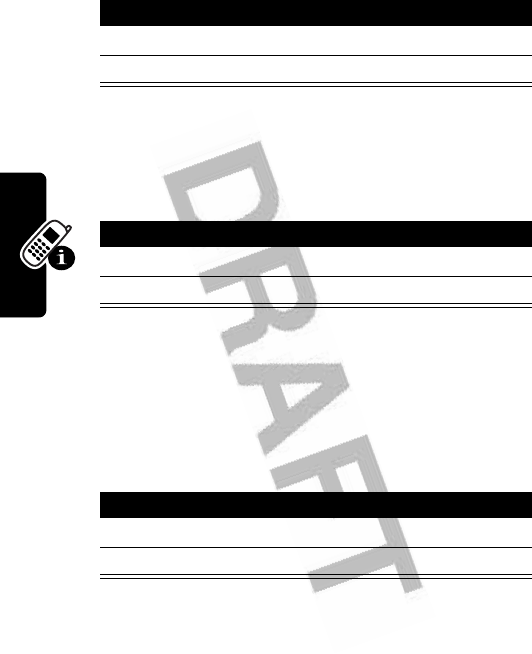
58
Learning to Use Your Phone
Unlocking Your Phone
Tip:
Your phone’s unlock code is originally set to 1234.
At the
Enter Unlock Code
prompt:
Setting Your Phone to Lock Automatically
You can set your phone to lock every time you turn it off:
If You Forget a Code, PIN, or
Password
Note:
Your phone’s 4-digit unlock code is originally set to
1234, and the 6-digit security code is originally set to
000000.
Press To
1
keypad keys enter your unlock code
2
OK
(
+
) lock the phone
Press To
1
keypad keys enter your unlock code
2
OK
(
+
) unlock your phone
Find the Feature
M
>
Settings
>
Security
>
Phone Lock
>
Automatic Lock
>
On
Press To
1
keypad keys enter your unlock code
2
OK
(
+
) activate automatic lock
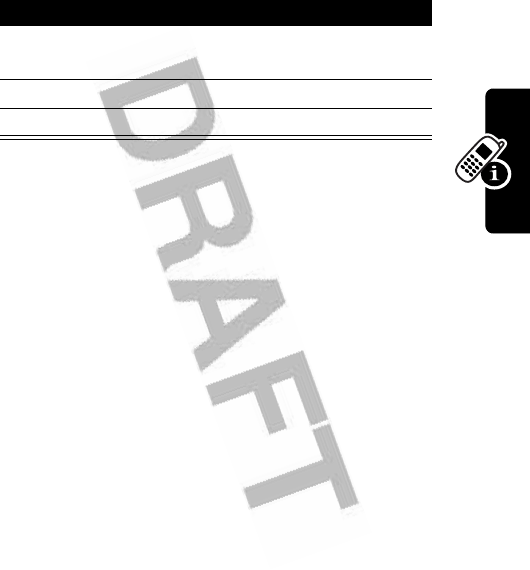
59
Learning to Use Your Phone
If you forget your unlock code, try entering 1234. If that
does not work, do the following at the
Enter Unlock Code
prompt:
If you forget your security code, take your phone to a
Motorola Authorized Service Center to have the code
read. If you forget your SIM card PIN code or PIN2 code,
contact your service provider.
Using the Phonebook
This section briefly describes basic phonebook operations.
For more information about using the phonebook, see
page 104.
Storing a Phone Number
Enter a phone number in the home screen, then press
STORE
(
+
) to create a phonebook entry with that number. Fill
in the other fields to complete the entry.
Select
MORE
to store another number (for example, a work
number) under the same
Name
.
Recording a Voice Name
When creating a phonebook entry, scroll to
Voice Name
and
press
RECORD
(
+
). Press and release the voice key and say
Press To
1
M
display the unlock code
bypass screen
2
keypad keys enter your security code
3
OK
(
+
) submit your security code
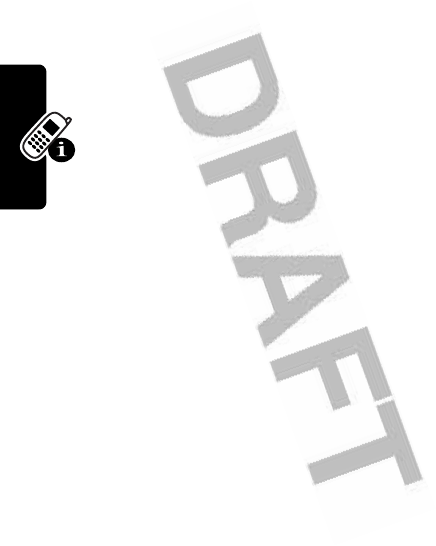
60
Learning to Use Your Phone
the entry’s name (within 2 seconds). When prompted,
press and release the voice key and repeat the name.
Press
DONE
(
-
) to store the voice name.
Note:
This option is not available for entries stored on the
SIM card.
Dialing a Number
Press
M
>
Phonebook
> entry to call.
Voice Dialing a Number
Press and release the voice key, and say the entry’s
name (within 2 seconds).
Sorting Phonebook Entries
Press
M
>
Phonebook
M
>
Setup
>
Sort by
, then select whether
you want to sort the phonebook list by
Name
,
Speed No.
,
Voice Name
, or
Email
.
When sorting by name, you can view
All
numbers or just
the
Primary
number for each name. To set the primary
number for a name, see page 116.
Viewing Entries By Category
Press
M
>
Phonebook
, press
M
>
Categories
, then select
whether you want to view
All
entries, entries in a
predefined category (
Business
,
Personal
,
General
,
VIPs
), or
entries in a category you created.
To set the category for a phonebook entry, see page 105.
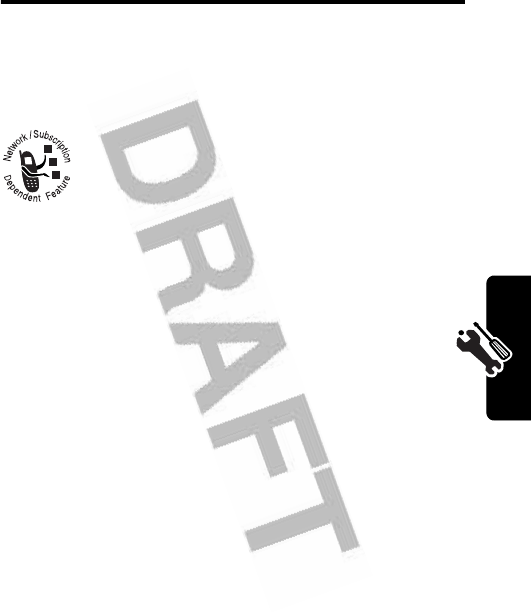
61
Setting Up Your Phone
Setting Up Your Phone
Storing Your Name and Phone
Number
To store or edit your name and phone number
information on your SIM card:
Shortcut:
Press
M#
from the home screen to edit your
name and phone number.
If you do not know your phone number, contact your
service provider.
Setting the Time and Date
You must set the time and date to use the datebook.
Setting an Alert Style
Your phone rings or vibrates to notify you of an incoming
call or other event. This ring or vibration is called an alert.
You can select 1 of 5 different alert styles. The ring alert
indicator in the display shows the current alert style (see
page 42).
Find the Feature
M
>
Settings
>
Phone Status
>
My Tel. Numbers
Find the Feature
M
>
Settings
>
Initial Setup
>
Time and Date
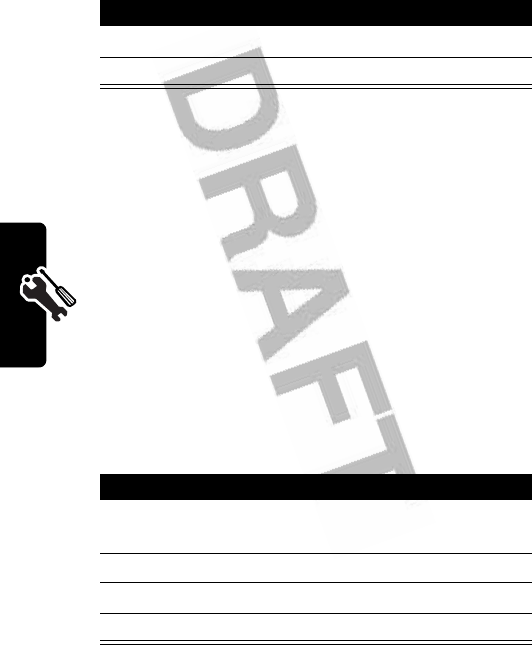
62
Setting Up Your Phone
To set an alert style:
Each alert style contains settings for specific event alerts,
ringer ID, and ringer and keypad volume. To change these
settings, press
M
>
Settings
>
Ring Styles
> Style
Detail
.
Setting Answer Options
You can use additional, alternative methods to answer
an incoming call.
To activate or deactivate an answer option:
Find the Feature
M
>
Settings
>
Ring Styles
>
Style
Press To
1
S
scroll to the alert style
2
SELECT
(
+
) select the alert style
Multi-Key
answer by pressing any key
Open to Answer
answer by opening the flip
Find the Feature
M
>
Settings
>
In-Call Setup
>
Answer Options
Press To
1
S
scroll to
Multi-Key
or
Open to Answer
2
CHANGE
(
+
) select the option
3
S
scroll to
On
or
Off
4
SELECT
(
+
) confirm the setting
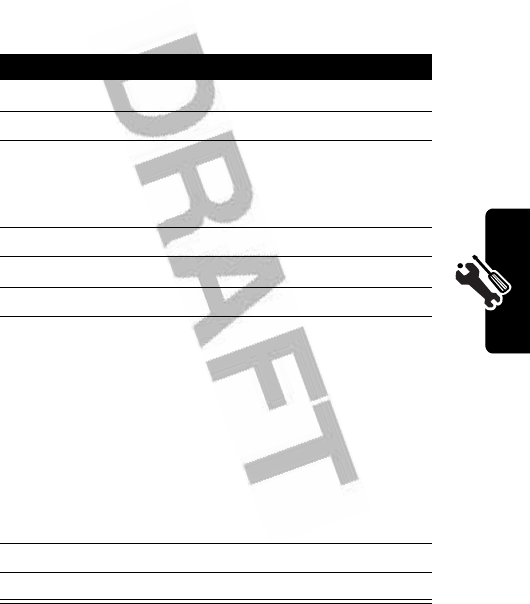
63
Setting Up Your Phone
Setting a Wallpaper Image
You can set a photo, picture, or animation as a wallpaper
(background) image in your phone’s home screen.
Find the Feature
M
>
Settings
>
Personalize
>
Wallpaper
Press To
1
S
scroll to
Picture
2
CHANGE
(
+
) open the picture viewer
3
S
up or down scroll to a picture/animation
Scroll to
(None)
to turn off the
wallpaper image.
4
SELECT
(
+
) select the image
5
S
scroll to
Layout
6
CHANGE
(
+
) adjust the image layout
7
S
scroll to
Center
,
Tile
, or
Fit-to-screen
Center
places the image in the
center of the display.
Tile
fills the display with
adjacent copies of the image.
Fit-to-screen
resizes the image,
if necessary, to fit the display.
8
SELECT
(
+
) confirm the layout setting
9
BACK
(
-
) save wallpaper settings
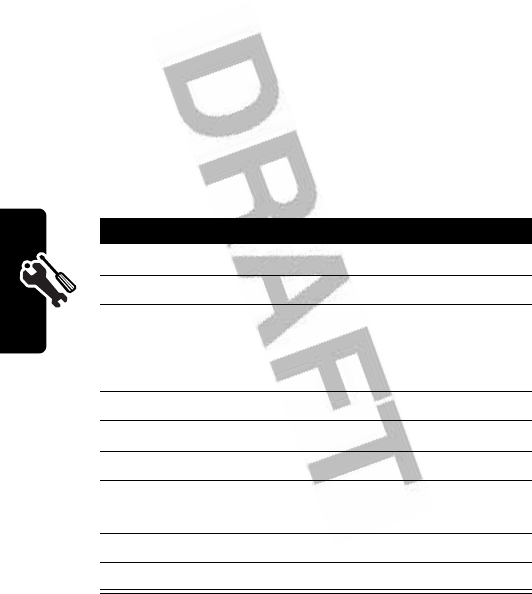
64
Setting Up Your Phone
Setting a Screen Saver Image
You can set a photo, picture, or animation as a screen
saver image.
The screen saver image displays when the flip is open and
no activity is detected for a period of time. The image
shrinks to fill the display, if necessary. An animation
repeats for 1 minute, then the first frame of the animation
displays.
Tip:
Turn off the screen saver to extend battery life.
Find the Feature
M
>
Settings
>
Personalize
>
Screen Saver
Press To
1
S
scroll to
Picture
2
CHANGE
(
+
) open the picture viewer
3
S
up or down scroll to a picture/animation
Scroll to
(None)
to turn off the
screen saver image.
4
SELECT
(
+
) select the image
5
S
scroll to
Delay
6
CHANGE
(
+
) set the delay interval
7
S
scroll to the inactivity interval
that triggers the screen saver
8
SELECT
(
+
) confirm the delay setting
9
BACK
(
-
) save screen saver settings
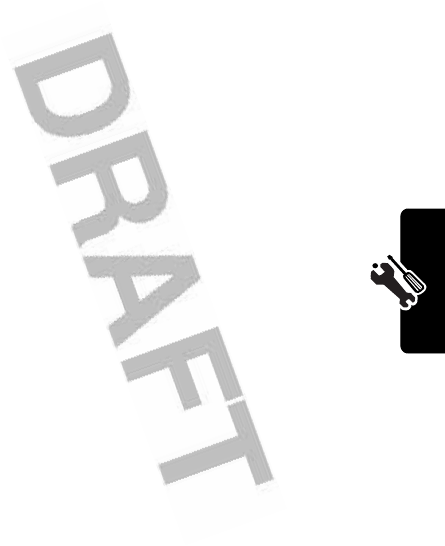
65
Setting Up Your Phone
Setting Display Brightness
Setting Display Color Style
You can select the color palette that your phone uses to
display indicators, highlights, and soft key labels.
Adjusting the Backlight
You can set the amount of time that the display and keypad
backlights remain on, or turn off backlights to extend
battery life.
Conserving Battery Power
Some networks and phones include a battery save setting
to extend battery life. When this feature is activated, your
phone automatically turns off the keypad backlight when it
detects that enough ambient light is available.
Find the Feature
M
>
Settings
>
Initial Setup
>
Brightness
Find the Feature
M
>
Settings
>
Personalize
>
Color Style
Find the Feature
M
>
Settings
>
Initial Setup
>
Backlight
Find the Feature
M
>
Settings
>
Initial Setup
>
Battery Save
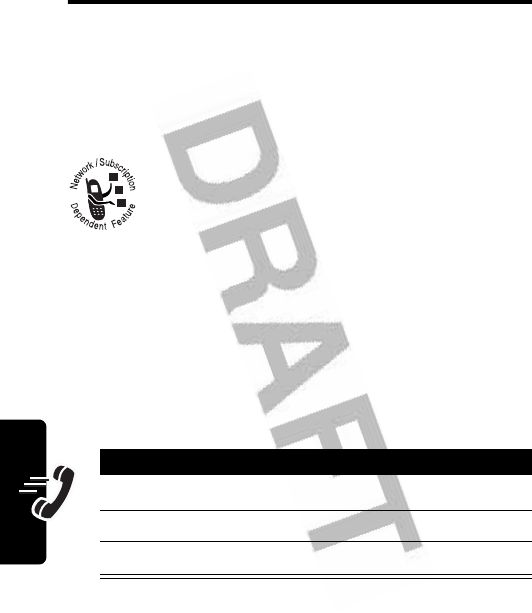
66
Calling Features
Calling Features
For basic instructions on how to make and answer calls,
see page 24.
Changing the Active Line
Change the active phone line to make and
receive calls from your other phone number.
Note:
This feature is available only for
dual-line-enabled SIM cards.
The active line indicator in the display shows the current
active phone line (see page 41).
Redialing a Number
Find the Feature
M
>
Settings
>
Phone Status
>
Active Line
Press To
1
N
view the dialed calls list
2
S
scroll to the entry you want to call
3
N
redial the number

67
Calling Features
Using Caller ID
Incoming Calls
Calling line identification (caller ID) displays the
phone number for incoming calls in your phone’s
external and internal displays.
The phone displays the caller’s name (and
picture, if available) when the name is stored in your
phonebook, or
Incoming Call
when caller ID information is not
available.
You can also set your phone to play a distinctive ringer ID
for specific entries stored in your phonebook. For more
information, see page 104.
Outgoing Calls
You can show or hide your phone number as an
ID for the next call that you make.
Shortcut:
While dialing (with digits visible in the
display):
Find the Feature
M
>
Settings
>
In-Call Setup
>
My Caller ID
Press To
M
>
Hide ID/Show ID
hide or show your caller ID for
the next call
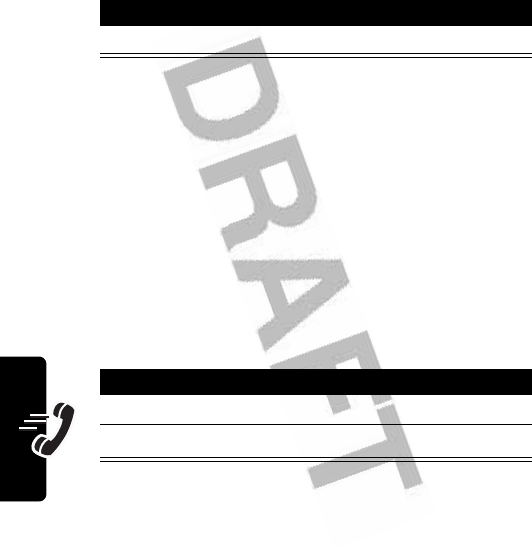
68
Calling Features
Turning Off a Call Alert
You can turn off your phone’s incoming call alert before
answering the call.
Calling an Emergency Number
Your service provider programs 1 or more emergency
phone numbers, such as 911, that you can call under any
circumstances, even when your phone is locked or the SIM
card is not inserted.
Note:
Emergency numbers vary by country. Your phone’s
preprogrammed emergency number(s) may not work in all
locations, and sometimes an emergency call cannot be
placed due to network, environmental, or interference
issues.
Dialing International Numbers
Press and hold
0
to insert the local international access
code (
+
) for the country from which you are calling.
Press To
either volume key turn off the alert
Press To
1
keypad keys dial the emergency number
2
N
call the emergency number
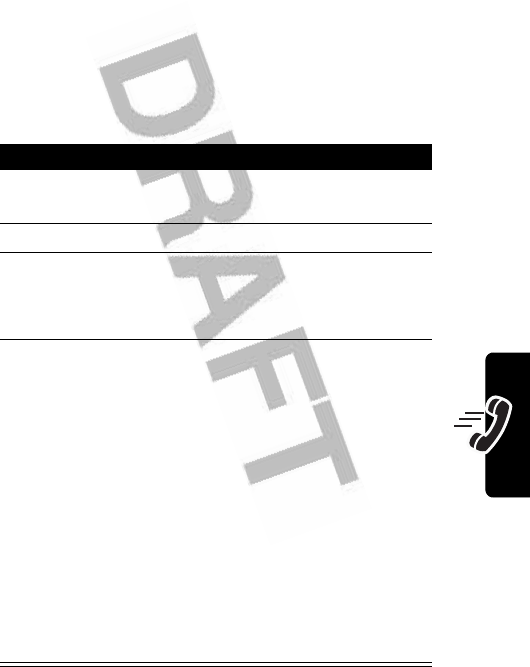
69
Calling Features
Viewing Recent Calls
Your phone keeps lists of the calls you recently received
and dialed, even if the calls did not connect. The lists are
sorted from newest to oldest entries. The oldest entries
are deleted as new entries are added.
Shortcut:
Press
N
from the home screen to view the
dialed calls list.
Find the Feature
M
>
Recent Calls
Press To
1
S
scroll to
Received Calls
or
Dialed Calls
2
SELECT
(
+
) select the list
3
S
scroll to an entry
Note:
<
means the call
connected.
4
N
or
VIEW
(
+
)
or
M
call the entry’s number
Tip:
Press and hold
N
for
2 seconds to send the
number as DTMF tones
during a call.
view entry details
open the
Last Calls Menu
to
perform various operations
on the entry
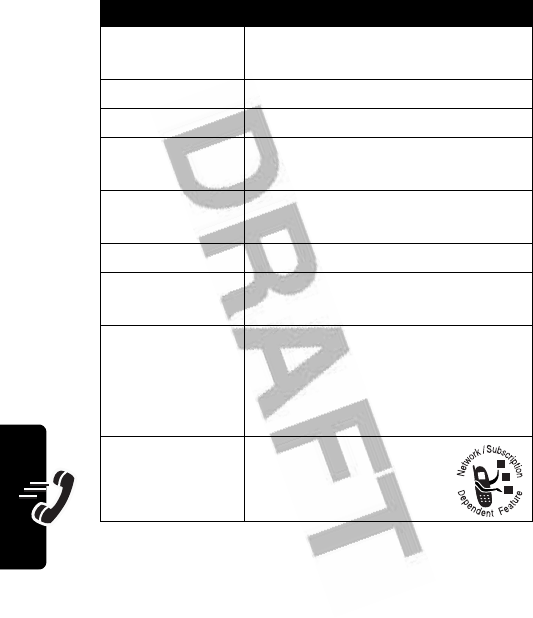
70
Calling Features
The
Last Calls Menu
can include the following options:
Returning an Unanswered Call
Your phone keeps a record of your unanswered calls, and
displays:
•
the
T
(missed call) indicator
Option Description
Store
Create a phonebook entry with
the number in the
No.
field.
Delete
Delete the entry.
Delete All
Delete all entries in the list.
Hide ID
/
Show ID
Hide or show your caller ID for the
next call.
Send Message
Open a new text message with
the number in the
To
field.
Add Digits
Add digits after the number.
Attach Number
Attach a number from the
phonebook or recent calls lists.
Send Tones
Send the number to the network
as DTMF tones.
Note:
This option displays only
during a call.
Talk then Fax
Talk and then send a
fax in the same call
(see page 154).
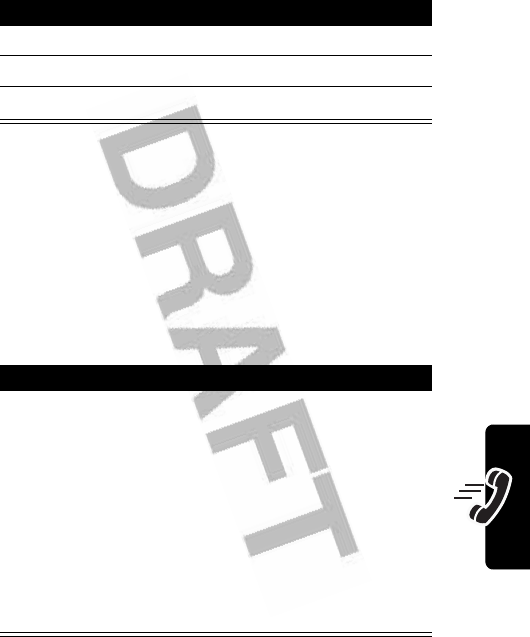
71
Calling Features
•
XMissedCalls
, where
X
is the number of missed calls
Using the Notepad
The most recent set of digits entered on the keypad are
stored in your phone’s notepad memory. This can be a
phone number that you called, or a number that you
entered but did not call. To retrieve the number stored in
the notepad:
Press To
1
VIEW
(
+
) see the received calls list
2
S
select a call to return
3
N
make the call
Find the Feature
M
>
Recent Calls
>
Notepad
Press To
N
or
M
or
STORE
(
+
)
call the number
open the
Dialing Menu
to attach
a number or insert a special
character
create a phonebook entry
with the number in the
No.
field
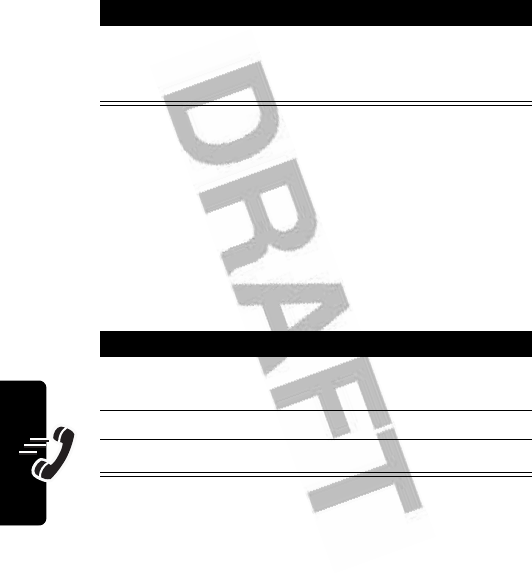
72
Calling Features
Attaching a Number
While dialing (with digits visible in the display):
Calling With Speed Dial
Each entry you store in your phonebook is assigned a
unique speed dial number.
Tip:
To see an entry’s speed dial number, press
M
>
Phonebook
, scroll to the entry, press
VIEW
(
+
).
To speed dial a phonebook entry:
Calling With 1-Touch Dial
To call phonebook entries 1 through 9, press and hold the
single-digit speed dial number for 1 second.
Tip:
You must specify which phone number list you want to
use with this feature: phone memory phonebook, or SIM
card phonebook (see page 121).
Press To
M
>
Attach Number
attach a number from the
phonebook or recent calls
lists
Press To
1
keypad keys enter the speed dial number
for the entry you want to call
2
#
submit the number
3
N
call the entry
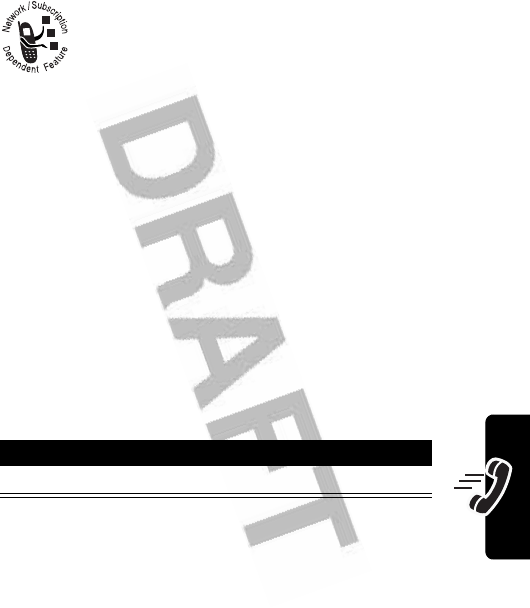
73
Calling Features
Using Voicemail
Voicemail messages that you receive are stored
on the network. To listen to your messages, you
must call your voicemail phone number.
Note:
Your service provider may include
additional information about using this feature.
Listening to Voicemail Messages
The phone calls your voicemail phone number. If no
voicemail number is stored, your phone prompts you to
store a number.
Receiving a Voicemail Message
When you receive a voicemail message, your phone
displays the
&
(voicemail message) indicator and a
New VoiceMail
notification.
The phone calls your voicemail phone number. If no
voicemail number is stored, your phone prompts you to
store a number.
Find the Feature
M
>
Messages
>
VoiceMail
Press To
CALL
(
+
) listen to the message
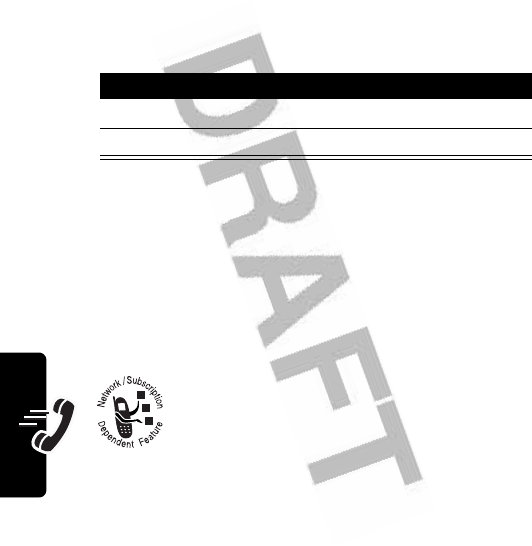
74
Calling Features
Storing Your Voicemail Number
If necessary, use the following procedure to store your
voicemail phone number on your phone. Usually, your
service provider has already done this for you.
Note:
You cannot store pause, wait, or n characters in this
number. If you want to store a voicemail number with these
characters, create a phonebook entry for it. Then, you can
use the entry to call your voicemail. For more about these
characters, see page 109.
Using Call Waiting
When you are on a call, an alert tone sounds
to indicate that you have received a second
call.
Find the Feature
M
>
Messages
M
>
VoiceMail Setup
Press To
1
keypad keys enter your voicemail number
2
OK
(
+
) store the number
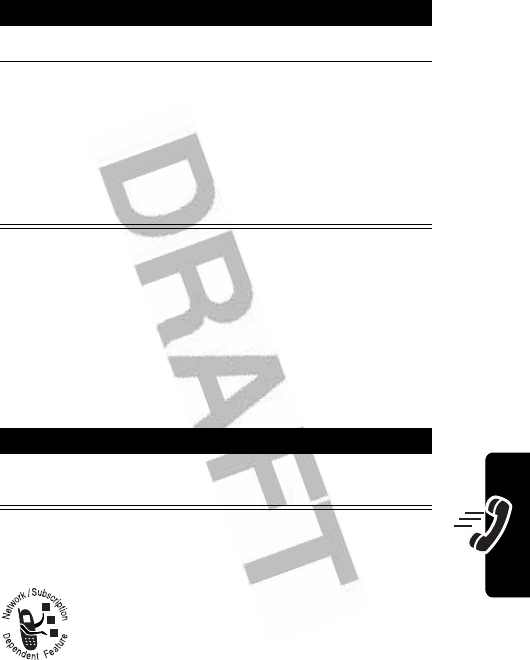
75
Calling Features
You must turn on call waiting to use the feature. To turn call
waiting on or off:
Putting a Call On Hold
Transferring a Call
You can announce that you are transferring an
active call to another party, or you can directly
transfer the call.
Announce the Call Transfer
Press To
1
N
answer the new call
2
SWITCH
(
+
)
or
LINK
(
-
)
or
M
>
EndCallOnHold
switch between calls
connect the 2 calls
end the call on hold
Find the Feature
M
>
Settings
>
In-Call Setup
>
Call Waiting
Press To
HOLD
(
+
) (if available) or
M
>
Hold
put the call on hold
Find the Feature
M
>
Hold
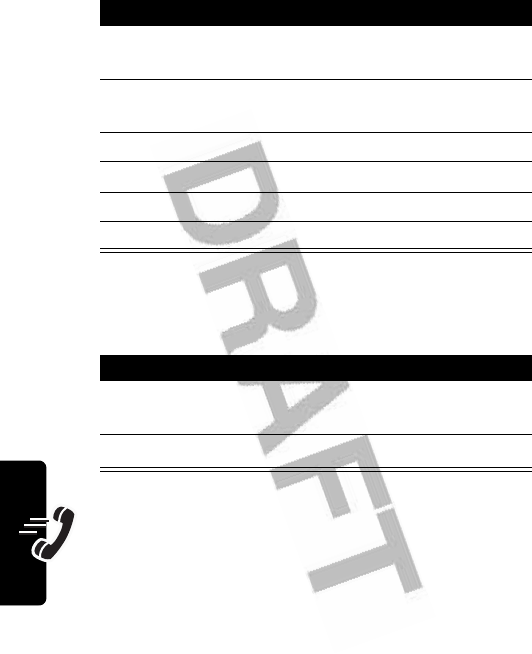
76
Calling Features
Do Not Announce the Call Transfer
Press To
1
keypad keys dial the number where you
are transferring the call
2
N
call the number and speak to
the person who answers
3
M
open the menu
4
S
scroll to
Transfer
5
SELECT
(
+
) select
Transfer
6
OK
(
+
) confirm the transfer
Find the Feature
M
>
Transfer
Press To
1
keypad keys dial the number where you
are transferring the call
2
N
transfer the call
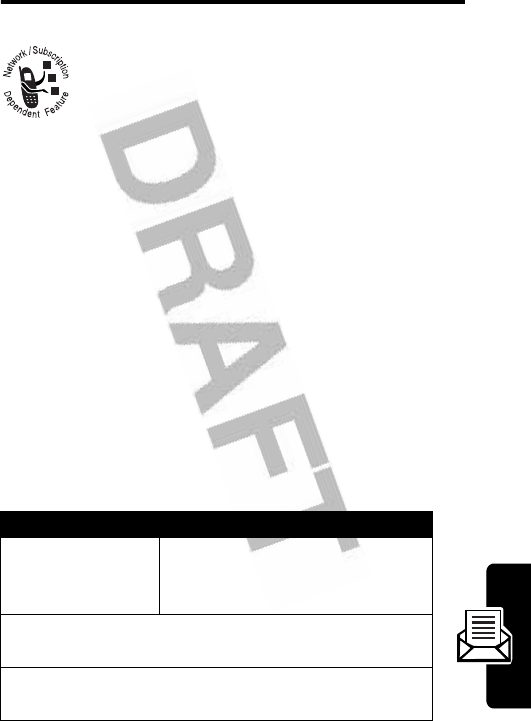
77
Messages
Messages
You can send and receive messages containing
a variety of media objects, including text,
photos, pictures, animations, sounds, and voice
records.
Setting Up the Message Inbox
You must set up your message inbox
before
you can send
and receive messages.
Note:
Usually, your service provider has already set up the
message inbox for you.
To set up the message inbox, you must configure the
following settings. Actual field names and values may vary
depending on the technologies available to your service
provider. Some settings may not be available for all phone
models.
Find the Feature
M
>
Messages
M
>
Message Setup
Option Description
MMS Message Setup
Set up the following Multimedia
Messaging Service (MMS)
features:
•
Hide Fields
: Specify which fields are hidden when
composing a multimedia message or letter.
•
Autosignature
: Create a signature you can append to
outgoing multimedia messages and letters.
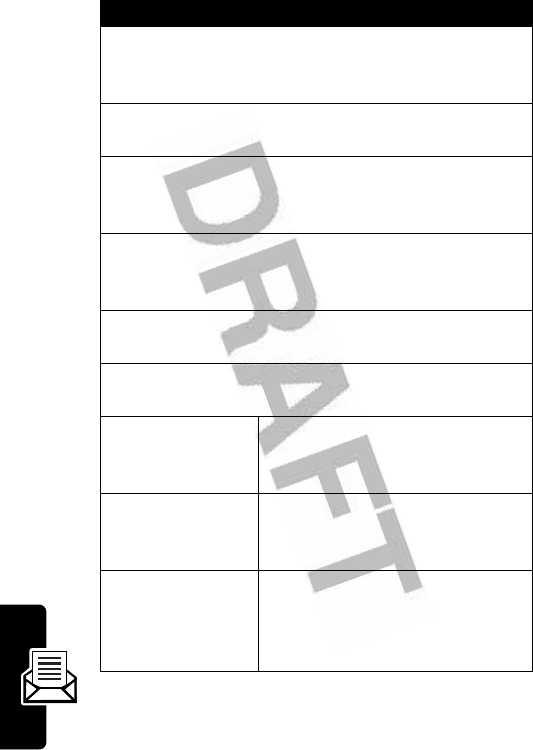
78
Messages
•
Download
: Download messages automatically,
download only selected messages (see page 85), or
download only when on your home network.
•
Filter
: Reject incoming multimedia messages and
letters from specific senders.
•
Expire After
: Number of days your network should
attempt to send undelivered multimedia messages
and letters.
•
Reply Type
: Standard type of reply to send to a
received MMS message—(SMS) short text
message, multimedia message, or multimedia letter.
•
Size Limit
: Maximum size of incoming multimedia
message to be downloaded to your phone.
•
Server Info
: Select the server you want to use
(information may be viewable only).
Inbox View
Display sender or subject
information with a multimedia
message or letter.
Srvce Center No
Number of the service center
that handles your outgoing text
messages.
Auto Cleanup
Specify the number of days you
want to keep messages in the
inbox, or number of messages
you want to keep.
Option Description
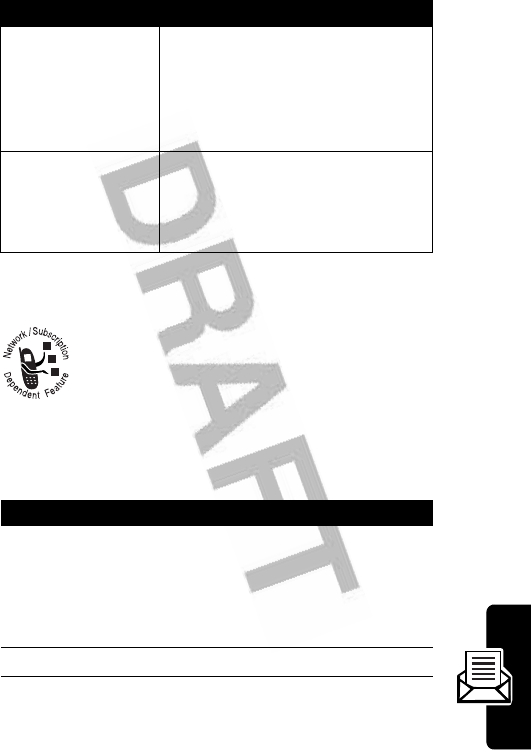
79
Messages
Sending a Text Message
You can send an SMS text message to other
wireless phone users, and to email addresses.
Email Gateway
Port number for the email
gateway that handles your
outgoing email messages
(required to send a text
message to an email address).
SMS Alert
Activate or deactivate reminders
and alerts for Short Message
Service (SMS) text messages
that you receive during a call.
Find the Feature
M
>
Messages
>
Create Message
>
New Short Msg
Press To
1
keypad keys
or
INSERT
(
+
)
enter the text message
select and insert a quick note
(see following section)
2
OK
(
+
) store the message
Option Description
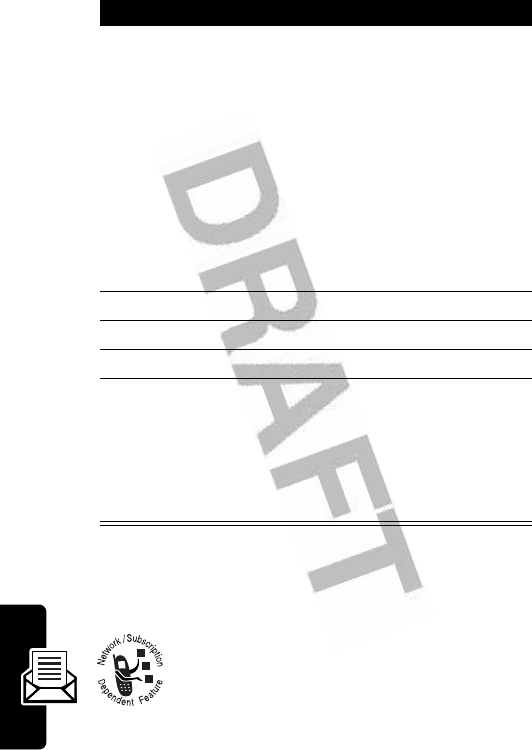
80
Messages
Sending a Quick Note Text
Message
Quick notes are prewritten text messages
that you can send quickly (for example,
On my way
). You can also create new quick
notes.
3
S
Scroll to
[One Time Entry]
and
press
SELECT
(
+
) to enter a
recipient phone number.
After you enter the number,
press
OK
(
+
) to store it.
or
Scroll to phonebook entries
and press
ADD
(
+
) to select
them. Press
DONE
(
+
) to store
them.
4
CHANGE
(
-
) select
Subject
5
keypad keys enter the subject
6
OK
(
+
) store the subject
7
SEND
(
+
)
or
M
send the message
open the message menu to
cancel the message or save it
in the drafts folder
Find the Feature
M
>
Messages
>
Quick Notes
Press To
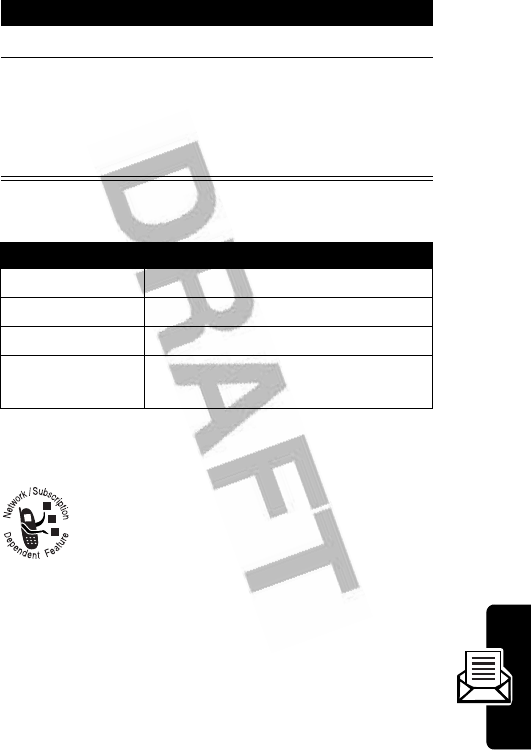
81
Messages
The
Quick Note Menu
can include the following options:
Sending a Multimedia Message
An MMS multimedia message contains one or
more slides with text and embedded media
objects, synchronized in a single presentation.
You can send the message to other wireless
phone users, and to email addresses.
Tip:
The layout of all slides is determined by the layout of
the first slide to contain both text and a picture. Place
the cursor in the first half of the slide text to insert a
Press To
1
S
scroll to the quick note
2
READ
(
+
)
or
M
read the quick note
open the
Quick Note Menu
to
perform other procedures
Option Description
New
Create a new quick note.
Edit
Edit the quick note.
Delete
Delete the quick note.
Send
Open a new message with the
quick note in the
Msg
field.
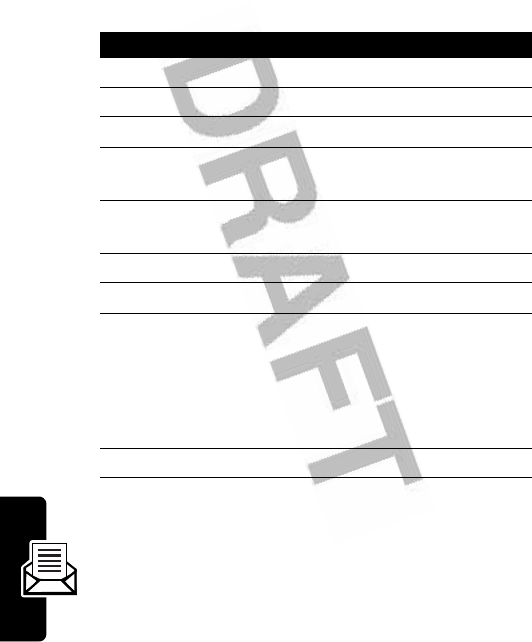
82
Messages
picture above the text. Place the cursor in the second half
of the slide text to insert a picture below the text.
Find the Feature
M
>
Messages
>
Create Message
>
New MMS
Press To
1
keypad keys enter slide text
2
M
open the menu
3
S
scroll to
Insert
4
SELECT
(
+
) display a list of items you can
insert
5
S
scroll to
Picture
,
Voice Record
,
Sound
,
Quick Note
, or
Contact Info
6
SELECT
(
+
) select the file type
7
S
select the file you want
8
SELECT
(
+
) insert the file
Tip: To insert another slide,
select
M
>
Insert
>
New Page
.
Repeat steps 1 to 8 to enter
contents for the new slide
9
OK
(
+
) open the recipient list
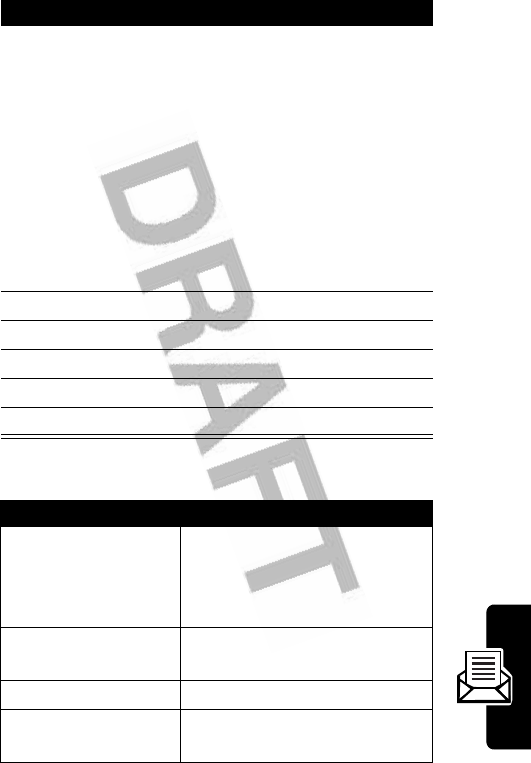
83
Messages
The
MMS Menu
can include the following options:
10
S
Scroll to
[One Time Entry]
and
press
SELECT
(
+
) to enter a
recipient phone number.
After you enter the number,
press
OK
(
+
) to store it.
or
Scroll to phonebook entries
and press
ADD
(
+
) to select
them. Press
DONE
(
+
) to store
them.
11
S
scroll to
Subject
12
CHANGE
(
-
)select
Subject
13
keypad keys enter the subject
14
OK
(
+
) store the subject
15
SEND
(
+
) send the message
Option Description
Insert
Insert 1 of the following items:
Picture
,
Voice Record
,
Sound
,
New Page
,
Contact Info
, or
Quick Note
.
Delete Audio
Delete the sound file attached
to the current slide.
Delete Page
Delete the current slide.
Preview
Play the multimedia
message.
Press To
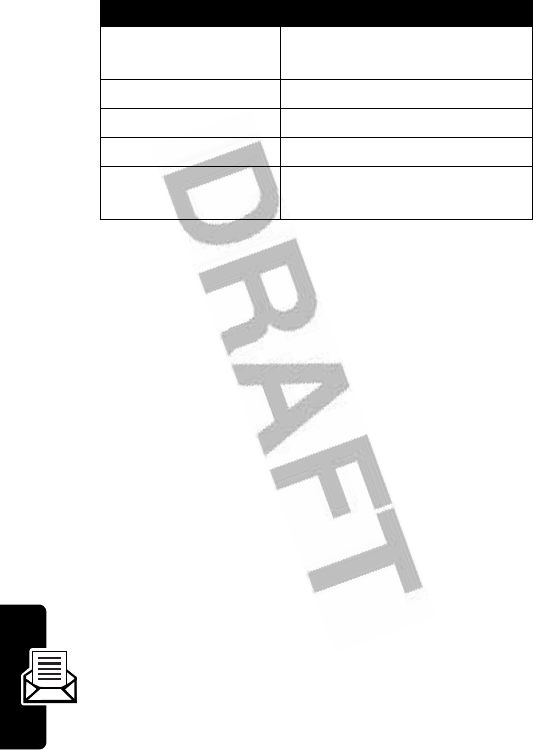
84
Messages
Viewing the Status of Sent
Messages
Messages that you send are stored in the outbox.
Messages in the outbox are sorted from newest to oldest.
Tips For Sending Messages
•
Press
M
to select a text entry method when you enter
message text (see page 47).
•
When you manually enter phone numbers and/or
email addresses in the
To
field, you must insert a
space between each entry. Press
S
to the right to
insert a space between each phone number or email
address.
Set Page Timing
Set the number of seconds
each slide is displayed.
Next Page
Advance to next slide.
Previous Page
Go back to previous slide.
Entry Mode
Select the text entry method.
Entry Setup
Set primary and secondary
text entry methods.
Find the Feature
M
>
Messages
>
Outbox
Option Description
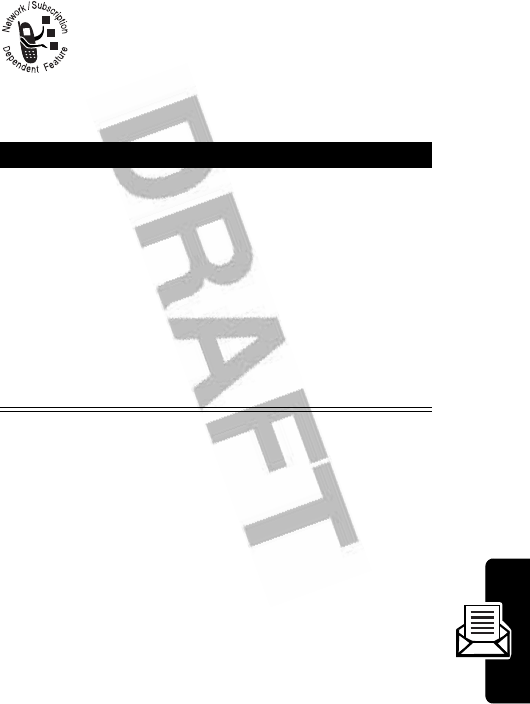
85
Messages
Receiving a Message
When you receive a message, your phone
displays the
X
(message waiting) indicator and
a
New Message
notification, and sounds an alert.
Note:
DETAILS
appears for MMS messages if
Download
is set to
Defer
(see page 77)
If reminders are turned on, your phone sends a reminder
at regular intervals until you close the new message
notification, read the message, or turn off your phone.
When your phone displays
Memory is Full!
, you must delete
some existing messages from your inbox, outbox, or drafts
folder to receive new messages.
Multimedia messages that you receive can contain
different media objects:
•
Photos, pictures, and animations are displayed as
you read the message.
Press To
READ
(
+
) open the message
or
DETAILS
(
+
) open message details (or a
list of messages if there are
more than one)
When you are viewing
message details, press
DOWNLD
(
+
) to download and
read the message.

86
Messages
•
A sound file begins playing when its slide is displayed.
Use the volume keys to adjust the volume as the
sound file plays.
Note:
In a multimedia letter, you may have to highlight
an indicator embedded in the text to play a sound file.
•
Attached files are appended to the message. To open
the attachment, highlight the file indicator/filename
and press
VIEW
(
+
) (image file type),
PLAY
(
+
) (sound
file), or
OPEN
(
+
) (vObject or unknown file type).
Reading, Locking, or Deleting a
Message
Messages in the message inbox are sorted from newest to
oldest. The following indicators show message status:
The oldest messages are deleted automatically as
specified by the inbox
Cleanup
setting. If you want to save a
message, you should lock it to prevent it from being
deleted during cleanup.
Y
= unread
ñ
= unread (with attachment)
n
=read
î
= read (with attachment)
f
= read and
locked
ó
= read and locked (with
attachment)
Find the Feature
M
>
Messages
>
Message Inbox
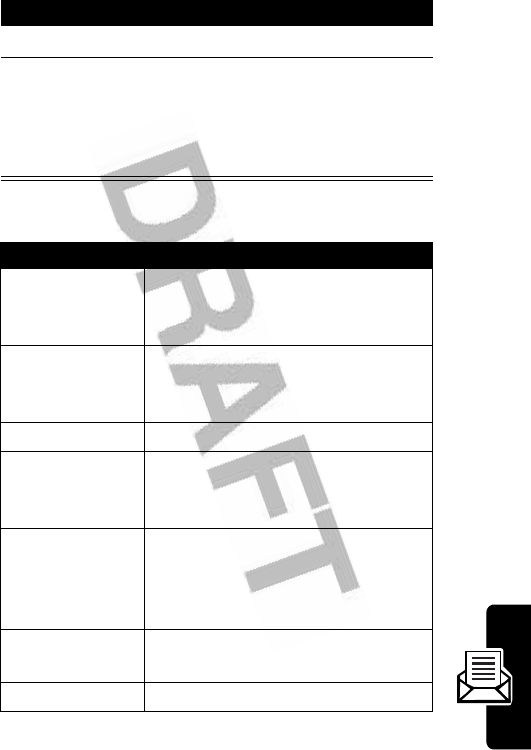
87
Messages
The
Message Menu
can include the following options:
Press To
1
S
scroll to the message
2
READ
(
+
)
or
M
open the message
open the
Message Menu
to perform
other procedures
Option Description
Call Back
Call the number in the message
header or embedded in the
message.
Go To
Launch mMode and go to a Web
address (URL) embedded in the
message.
Replay
Replay a multimedia message.
Reply
Open a new message, with the
sender’s number or email address
in the
To
field.
Reply To All
Open a new message, with the
sender’s number/address in the
To
field, and all other recipients listed
in the
Cc
field.
Forward
Open a copy of the message, with
an empty
To
field.
Lock
or
Unlock
Lock or unlock the message.
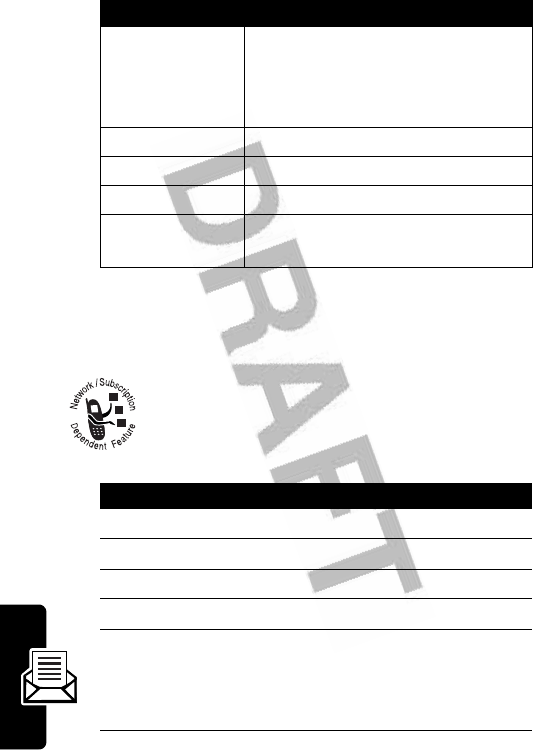
88
Messages
Storing an Object From a
Message
To store a media object contained in a
multimedia message or letter, go to the slide
that contains the object, or highlight the object in
the letter, and then:
Store
Display a list of storable items,
including inserted and attached
files, and the sender’s number or
email address.
Delete
Delete the message.
Delete All
Delete all inbox messages.
Create Message
Open a new message.
Setup
Open the message inbox setup
menu.
Press To
1
M
open the
Message Menu
2
S
scroll to
Store
3
SELECT
(
+
) display a list of storable items
4
S
scroll to
File
5
SELECT
(
+
) display the name of the
object(s) in the current slide,
or the name of the highlighted
object in the letter
Option Description
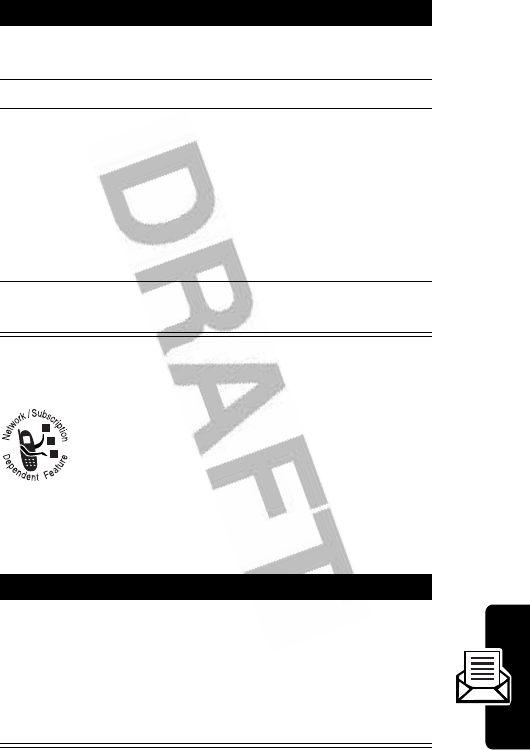
89
Messages
Reading Browser Messages
Your network’s Web server can send you
browser messages that you can read in mMode.
When you receive a browser message, your
phone displays the
X
(message waiting)
indicator and a
New Browser Message
notification, and sounds
an alert.
6
S
highlight the object filename,
if necessary
7
STORE
(
+
) view storage options
8
S
scroll to
Store Only
,
Apply as Wallpaper
,
Apply as Screen Saver
,
Apply as Ring Tone
, or
Apply as Power Up Animation
(only
options appropriate to the file
type are listed)
9
SELECT
(
+
) perform the storage option of
your choice
Press To
GO TO
(
+
)
or
EXIT
(
-
)
launch mMode and view the
message
close the new message
notification
Press To

90
Messages
To view your browser messages at any time:
Find the Feature
M
>
Messages
>
Browser Msgs
Press To
1
S
scroll to a message
2
SELECT
(
+
) open the message

91
Email
Email
You can send and receive email messages with
your wireless phone.
Setting Up the Email Inbox
You must set up your email inbox
before
you can send and
receive email messages.
Note:
Usually, your service provider has already set up the
email inbox for you.
To set up the email inbox, you must configure the following
settings. Actual field names and values may vary
depending on the technologies available to your service
Find the Feature
M
>
Messages
M
>
Email Msg Setup
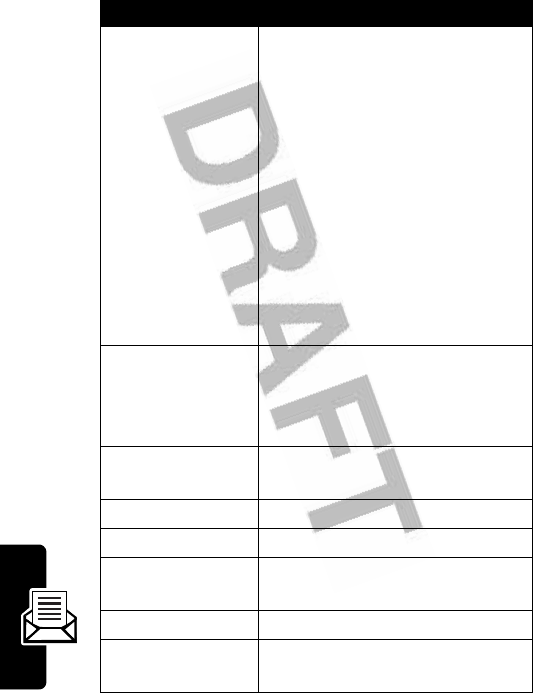
92
Email
provider. Some settings may not be available for all phone
models.
Setting Description
ISP settings
Connection type
: Select
CSD
or
GPRS
.
Dial-Up Number
: Phone number for
a CSD connection.
APN address
: Access point name
for a GPRS connection.
User name
: User name for
specified connection.
Password
: Password for specified
connection.
DNS IP
: Address of DNS server for
specified connection.
Email provider
Select your email provider, or
select
Custom
to manually enter
Protocol
,
Sending host
,
Sending port
,
Receiving host
, and
Receiving port
.
Protocol
Select protocol to communicate
with receiving host:
POP3
or
IMAP4
.
User ID
Your user ID.
Password
Your user password.
Sending host
IP address or host name that
handles your outgoing email.
Sending port
Port number for sending host.
Receiving host
IP address or host name that
handles your incoming email.
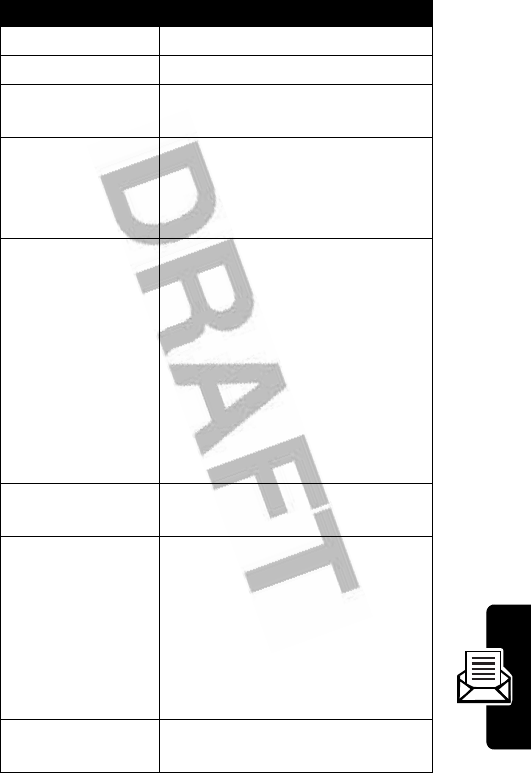
93
Email
Receiving port
Port number for receiving host.
Return address
Your email address.
Name
Name to be inserted before the
return address, if desired.
Cleanup
Number of days you want to
keep messages in the inbox, or
number of messages you want
to keep.
Save on server
Select
Yes
to save copies of your
email messages on the remote
server. (For POP3, prevents
message deletion on remote
server after message is
downloaded to your phone. For
IMAP4, prevents message
deletion on remote server after
message is deleted on your
phone.)
Notification
Select
On
to be notified when you
receive a new email message.
Check new msgs
Interval at which your phone
automatically receives new
email messages in the
background mode.
Select
No
if you want to only
manually
Send/Receive Mail
(see
page 100).
Hide fields
Hide fields (
cc
and/or
bcc
) when
composing an email message.
Setting Description
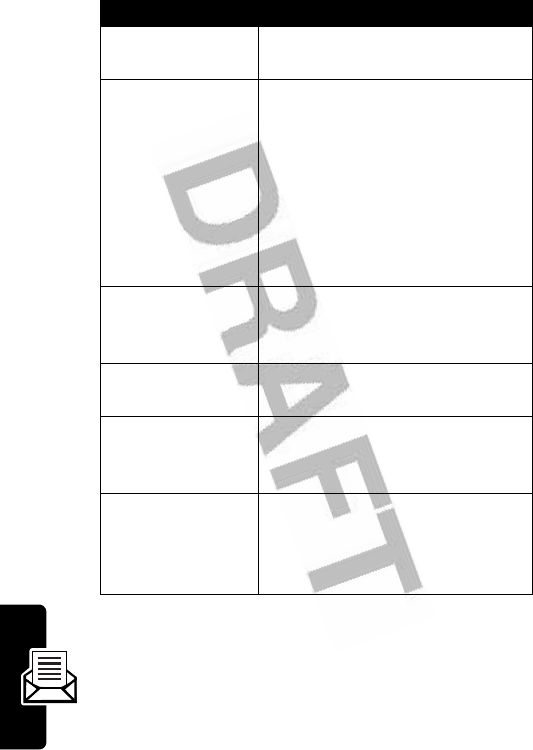
94
Email
Sending an Email Message
You can send an email message to 1 or more
recipients. You can manually enter each recipient’s
email address, or select addresses from the
phonebook.
Auto signature
Signature to be appended to
your outgoing email messages.
Security
Use SSL for sending
: Select
Yes
to
setup SSL connection with
sending host.
Warnings in Background
: Select to
proceed or break connection if
SSL warning displays when
receiving messages in
background.
Size restriction
Maximum size of an email
message to be downloaded to
your phone.
Unread only
Select
Yes
to receive unread
messages only (IMAP4 only).
ReceiveDateRange
Filter to receive messages from
specified time period (IMAP4
only).
Attachments
Filter to receive only attached
files of specified type (
Graphic
or
Music
) or not to receive attached
files (IMAP4 only).
Setting Description
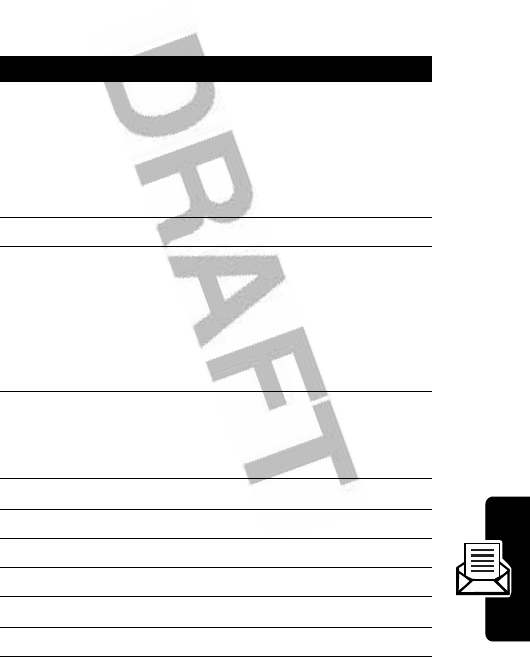
95
Email
When you manually enter email addresses, you must
insert a comma, semicolon, or colon between each
address.
Find the Feature
M
>
Messages
>
Create Message
>
New Email
Press To
1
keypad keys enter text for the message
Tip:
To insert a quick note,
picture, sound, or voice
record, press
M
>
Insert Options
(see page 96).
2
OK
(
+
) store the message
3
keypad keys
or
PH. BOOK
(
+
)
enter one or more phone
email addresses
select addresses from the
phonebook
4
OK
(
+
) store the addresses
Tip:
You can also store
addresses in
Cc
and
Bcc
5
S
scroll to
Subject
6
CHANGE
(
-
)select
Subject
7
keypad keys enter the subject
8
OK
(
+
) store the subject
9
S
scroll to
Attachments
10
CHANGE
(
-
)select
Attachments
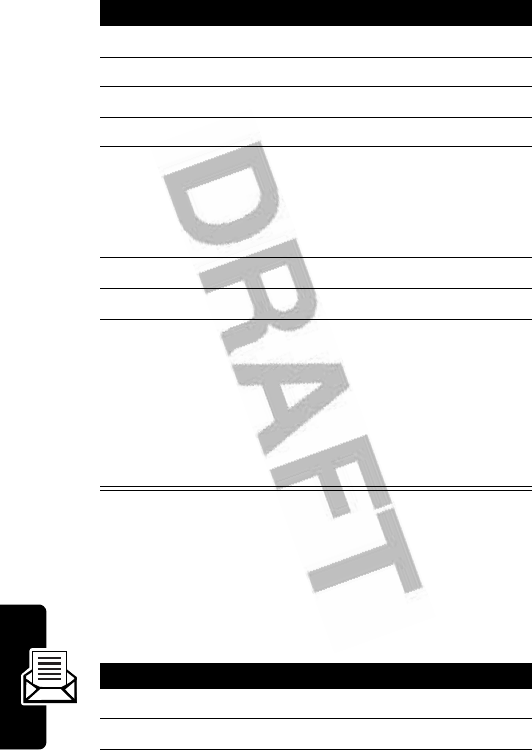
96
Email
Inserting Items in Email Text
You can insert media elements into the email message as
you type it. Photos, pictures, and animations display in the
message. Sounds are represented by a sound file
indicator.
11
S
scroll to
Picture
or
Sounds
12
SELECT
(
+
) select the file type
13
S
select the file you want
14
SELECT
(
+
) attach the file
15
BACK
(
-
) return to the email form
Tip:
To add more
attachments, select
[New Attachment]
16
S
scroll to
Priority
17
S
(left or right) scroll to
Normal
or
Urgent
18
SEND
(
+
)
or
M
send the message
save the message in the
drafts folder, view message
details, or cancel the
message
Press To
1
M
open the menu
2
S
scroll to
Insert Options
Press To
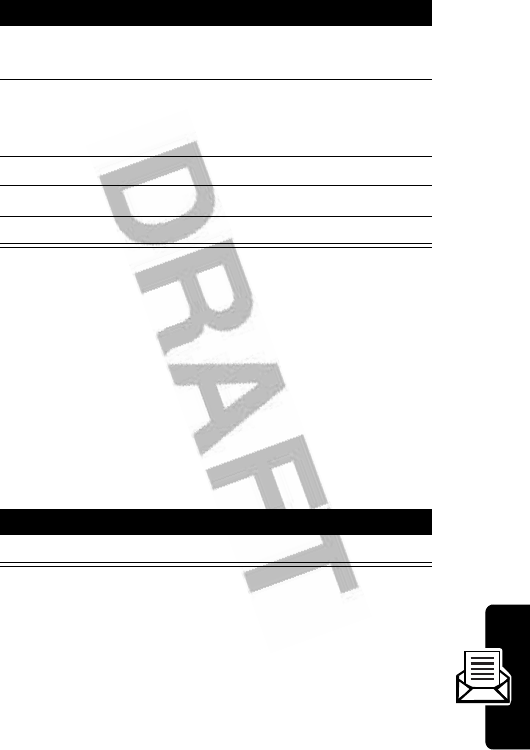
97
Email
Receiving an Email Message
Email messages that you receive are stored on your
service provider’s email server until you download them to
your phone.
If your phone is set up to check periodically for new email
messages, your phone displays the
X
(message waiting)
indicator and a
New Message
notification, and sounds an alert
when you receive an email message.
If reminders are turned on, your phone sends a reminder
at regular intervals until you close the new message
notification, read the message, or turn off your phone.
When your phone displays
Memory is Full!
, you must
delete some existing messages from your inbox,
outbox, or drafts folder to receive new messages.
3
SELECT
(
+
) display a list of items you can
insert
4
S
scroll to
Quick Note
,
Picture
,
Sounds
,
Voice Record
, or
Contact Info
5
SELECT
(
+
) select the file type
6
S
select the file you want
7
SELECT
(
+
) insert the file
Press To
READ
(
+
) open the message
Press To

98
Email
Tip:
New email messages are completely downloaded to
your phone. With the IMAP4 protocol, if message size is
greater than the
Size restriction
setting, the email message
header is downloaded instead. While downloading a series
of messages, you can press
END
(
+
) to end the connection
with the email server when downloading of currently
transferred message is complete. Press
END
(
+
) a second
time to end the connection immediately.
Reading, Locking, or Deleting
an Email Message
Messages in the email inbox are sorted from newest to
oldest. The following indicators show message status:
The oldest messages are deleted automatically as
specified by the inbox
Cleanup
setting. If you want to save a
message, you should lock it to prevent it from being
deleted during cleanup.
Note:
If you create personal folders, the email inbox
lists folders first. Messages are located inside the
folders.
Y
= unread
ñ
= unread (with attachment)
d
= unread and
urgent
ï
= unread and urgent (with
attachment)
n
=read
î
= read (with attachment)
f
= read and
locked
ó
= read and locked (with
attachment
Find the Feature
M
>
Messages
>
Email Msgs
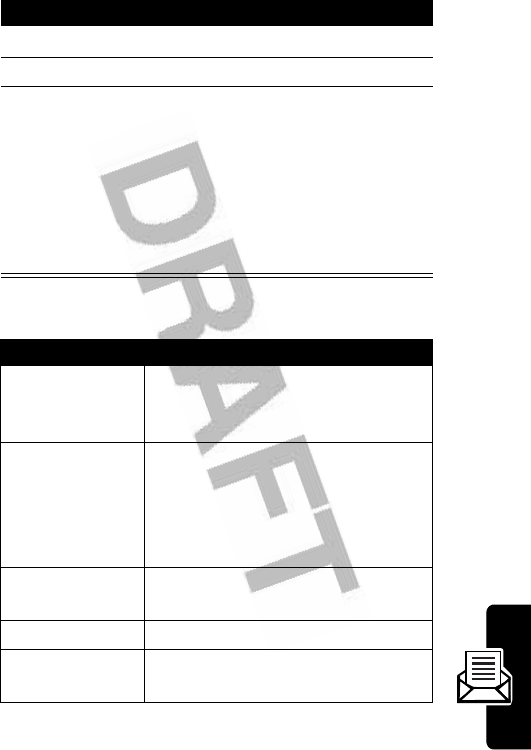
99
Email
The
Email Msg Menu
can include the following options:
Press To
1
S
scroll to the message
2
READ
(
+
) open the message
3
BACK
(
-
)
or
REPLY
(
+
)
or
M
close the message
compose and send a reply
open the
Email Msg Menu
to
perform other procedures
Option Description
Reply
Open a new email message, with
the sender’s email address in the
To
field.
Reply All
Open a new email message, with
all of the original recipients’ email
addresses in the appropriate
fields (
To
,
cc
). The
bcc
field is not
copied.
Forward
Open a copy of the email
message, with an empty
To
field.
Lock
or
Unlock
Lock or unlock the message.
Move To
Move the message to a personal
folder.
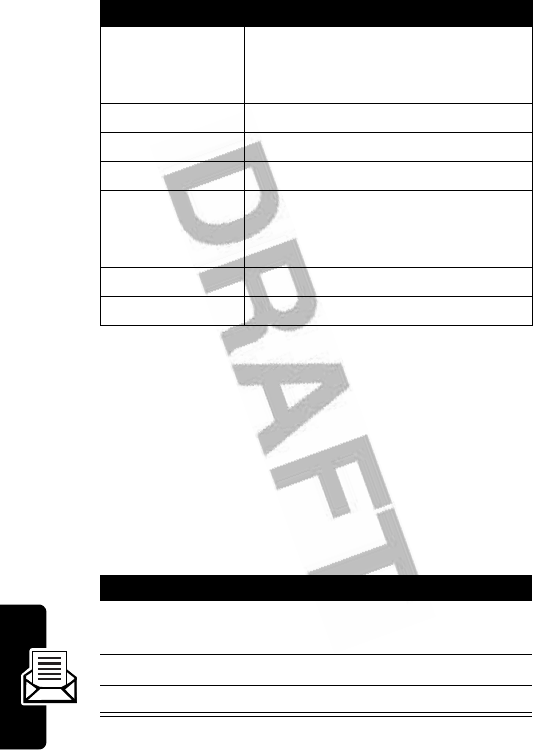
100
Email
Manually Sending and
Receiving Email
If your phone is not set up to check periodically for new
email messages, you must manually connect to your email
service provider to send and receive email.
Store
Display a list of items that can be
stored, including the sender’s
number or email address.
Delete
Delete the message.
Delete All
Delete all email inbox messages.
Create Email
Open a new email message.
Send/Receive Mail
Connect to your email service
provider to send and receive new
email.
Folder
Create or modify personal folders.
Email Msg Setup
Open the email inbox setup menu.
Find the Feature
M
>
Messages
M
>
Send/Receive Mail
Press To
1
YES
(
+
) connect to your email service
when you see
Connect Now?
2
S
scroll to the message
3
READ
(
+
) open the message
Option Description
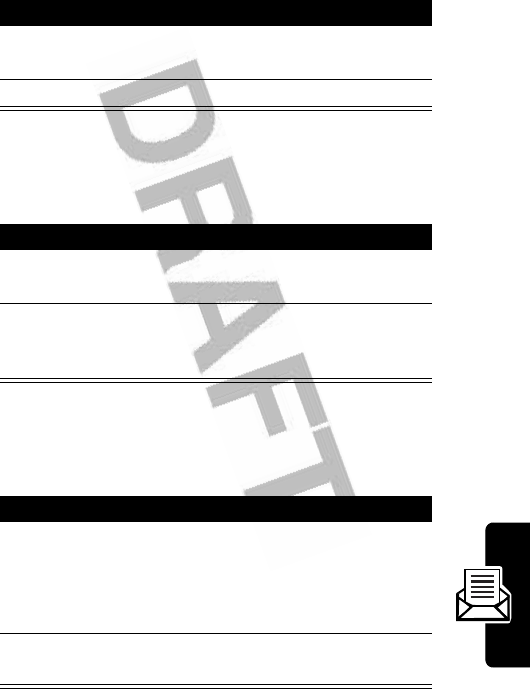
101
Email
Calling a Phone Number in an
Email Message
Sending Email to an Embedded
Email Address
Going to a Web Address in an
Email Message
Press To
1
S
highlight the phone number in
the message
2
CALL
(
+
) call the number
Press To
1
S
highlight the address in the
message
2
MAIL TO
(
+
) open a new email message,
with the email address in the
To
field
Press To
1
S
highlight the Web address
(URL) in the email message
Note:
The URL must be
underlined in the message.
2
GO TO
(
+
) launch mMode and go to the
URL
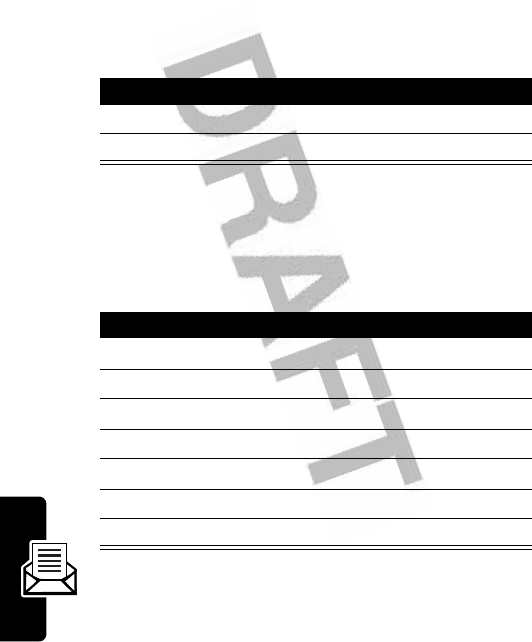
102
Email
Creating Personal Folders
You can create up to 5 personal folders to help organize
your email. The email inbox lists the inbox folder first,
followed by your personal folders in alphabetical order.
Moving Email to a Personal
Folder
Renaming a Personal Folder
Find the Feature
M
>
Messages
>
Email Msgs
M
>
Folder
>
Create
Press To
1
keypad keys enter the folder name
2
OK
(
+
) save the folder
Find the Feature
M
>
Messages
>
Email Msgs
Press To
1
S
scroll to the email message
2
M
open the
Email Msg Menu
3
S
scroll to
Move to
4
SELECT
(
+
) view the personal folders list
5
S
scroll to the folder
6
SELECT
(
+
) select the folder
7
YES
(
-
) move the email message
Find the Feature
M
>
Messages
>
Email Msgs
M
>
Folder
>
Rename
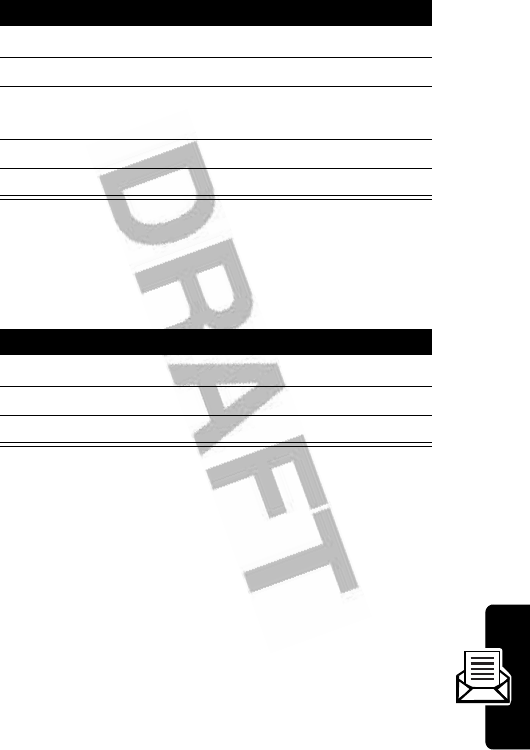
103
Email
Deleting a Personal Folder
Press To
1
S
scroll to the folder
2
SELECT
(
+
) select the folder
3
YES
(
+
) confirm that you want to
rename the folder
4
keypad keys enter the new folder name
5
OK
(
+
) save the folder
Find the Feature
M
>
Messages
>
Email Msgs
M
>
Folder
>
Delete
Press To
1
S
scroll to the folder
2
SELECT
(
+
) select the folder
3
YES
(
-
) delete the folder
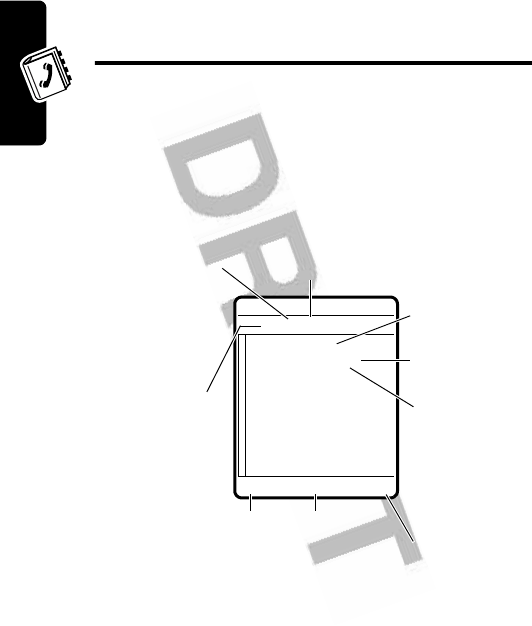
104
Setting Up Your Phonebook
Setting Up Your
Phonebook
You can store a list of names and phone numbers or
email addresses in your phone’s electronic phonebook.
To see the names in your phonebook, press
M
>
Phonebook
from the home screen. Scroll to a name and press
VIEW
(
+
)
to view the following details for the phonebook entry.
Note:
Entries stored on the SIM card do not have
Category
,
Type
,
Voice Name
,
Ringer ID
, or
Picture
information.
BACK
M
EDIT
*
Carlo Emrys
212-555-1212
Speed No.15# (P)
Category:General
Ringer ID:Continental
Picture:None
(P)
indicates
entry stored in
phone memory,
(S)
indicates
SIM memory.
Type indicator
shows number
type:
$
= work
U
= home
S
= main
h
= mobile
Z
= fax
p
= pager
[
= email
Entry Name
Return to
list.
Speed Dial
Number
Voice Name
indicator
indicates a
recorded voice
name.
Phone Number
or Email
Address
Press
M
to open
Phonebook
Menu
.
Edit entry.
$
(yÉ
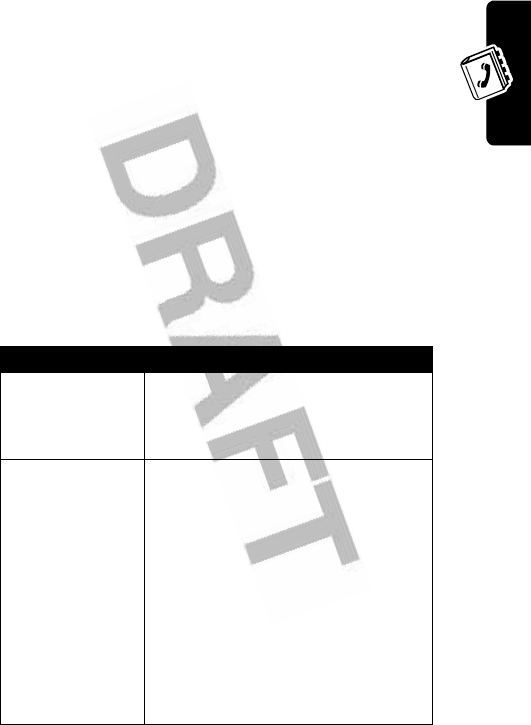
105
Setting Up Your Phonebook
Creating a Phonebook Entry
To store a phone number or email address in the
phonebook:
Shortcut:
Enter a phone number in the home screen, then
press
STORE
(
+
) to create a phonebook entry with the
number in the
No.
field.
You can store an entry on your phone or on the SIM card.
A phone number or email address is required for a
phonebook entry. All other information is optional. You can
enter the following information for a phonebook entry.
Find the Feature
M
>
Phonebook
M
>
New
>
Phone Number
or
Email Address
Option Description
Name
Specify the entry name.
Tip:
Press
M
to select a text entry
method. See page 46.
Category
Set the category to which the
entry belongs (
Business
,
Personal
,
General
, or
VIP
).
You can set the phonebook to
display all entries, or display only
entries in a specified category
(see page 116).
Note:
The
Category
option is not
available for entries stored on the
SIM card.
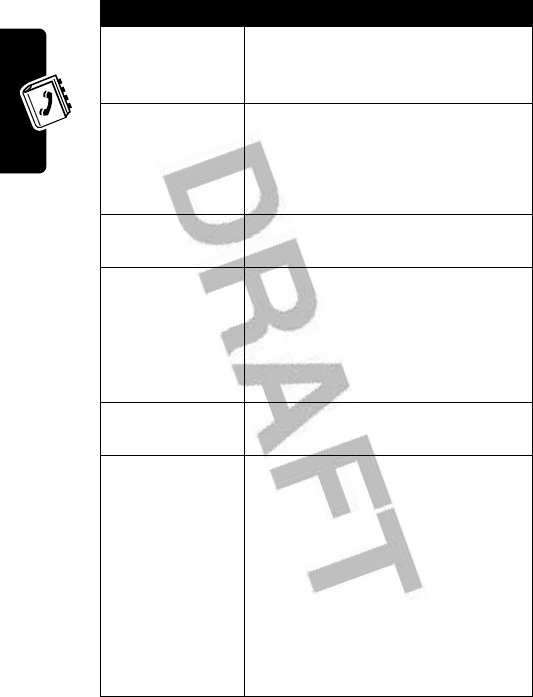
106
Setting Up Your Phonebook
No.
or
Email
Specify the entry’s phone number
or email address (maximum 32
characters).
Type
Set the entry type.
Note:
The
Type
option is not
available for email entries, or for
entries stored on the SIM card.
Store To
Set the entry’s physical storage
location (
Phone
or
SIM
).
Voice Name
Record a voice name for the
entry.
Note:
The
Voice Name
option is not
available for entries stored on the
SIM card.
Speed No.
Change the default speed dial
number for the entry, if desired.
Ringer ID
Set a distinctive ringer alert for the
entry.
Your phone sounds the ringer
alert when you receive a call from
this phone number. To activate
ringer IDs, see page 123.
Note:
The
Ringer ID
option is not
available for entries stored on the
SIM card.
Option Description
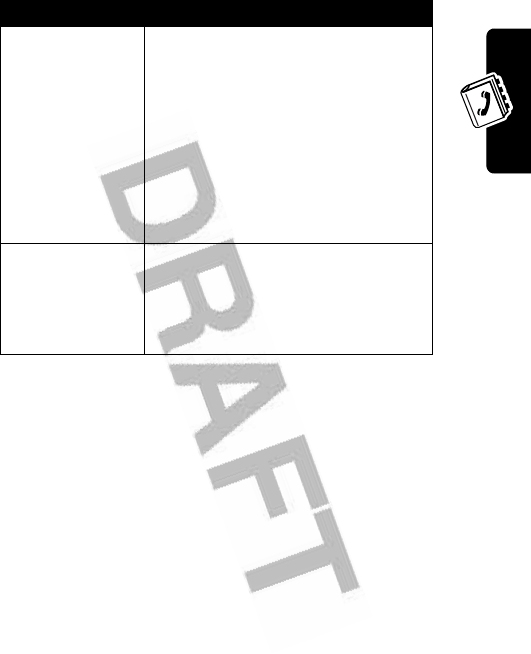
107
Setting Up Your Phonebook
When you are finished entering information, press
DONE
(
-
)
to store the entry.
Creating a Group Mailing List
You can create a group mailing list consisting of multiple
phone numbers and email addresses previously stored in
the phonebook. Mailing lists make it easy for you to send a
text message to multiple recipients simultaneously.
Picture
Assign a picture caller ID photo or
picture to the entry.
Your phone displays the picture
when you receive a call from this
phone number.
Note:
The
Picture
option is not
available for entries stored on the
SIM card.
MORE
Create another entry under the
same
Name
.
You must use a different
Type
identifier for each number.
Find the Feature
M
>
Phonebook
M
>
New
>
Mailing List
Option Description
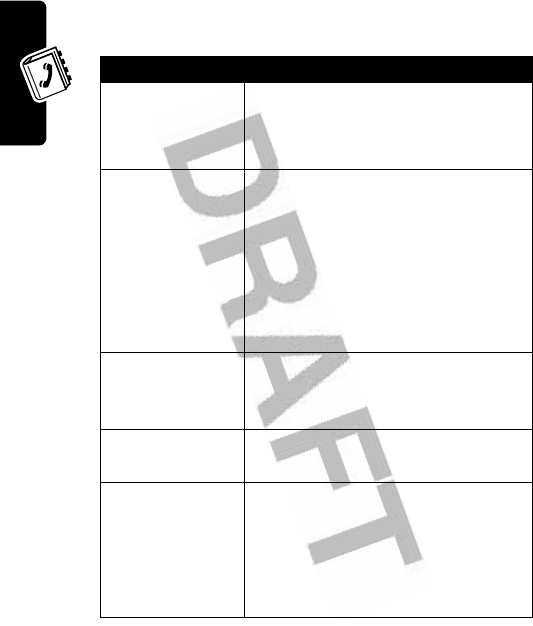
108
Setting Up Your Phonebook
A name is required for a mailing list entry. The mailing list
must contain at least 1 member. You can enter the
following information for a mailing list entry.
When you are finished entering information, press
DONE
(
-
)
to store the mailing list as a phonebook entry.
Option Description
Name
Specify the mailing list name.
Tip:
Press
M
to select a text entry
method. See page 46.
Category
Set the category to which the list
belongs (
Business
,
Personal
,
General
,
or
VIP
).
You can set the phonebook to
display all entries, or display only
entries in a specified category
(see page 116).
Members
Open the list of phonebook entries
that you can add or remove from
the mailing list.
Voice Name
Record a voice name for the
mailing list.
Speed No.
Change the default speed dial
number for the mailing list, if
desired.
Note:
Mailing lists cannot be
stored on the SIM card.
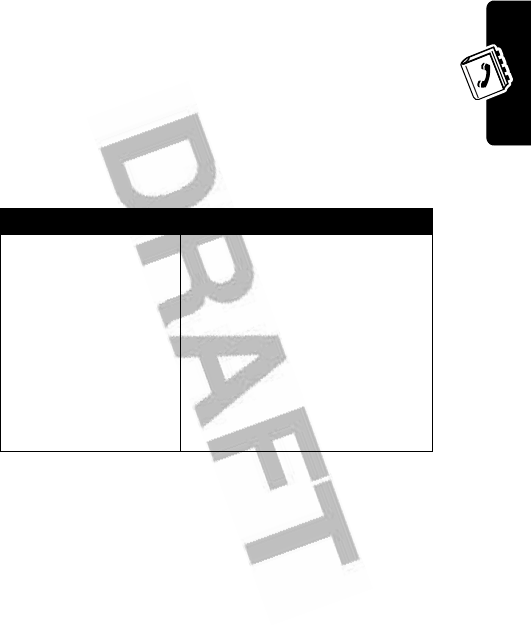
109
Setting Up Your Phonebook
Storing a PIN Code With a
Phone Number
You can store a PIN code with the phone number for
calls that require additional digits (for example, to make
a calling card call, or to retrieve voicemail or answering
machine messages). Insert 1 or more of the following
characters in the dialing sequence to ensure that the
number dials and connects properly:
Press To
M
>
Insert Pause
insert a
p
(pause) character
Your phone dials the
preceding digits, waits for the
call to connect, then dials the
remaining digit(s).
Note:
If your network does
not recognize the first pause
character, try two (
pp
).

110
Setting Up Your Phonebook
Notes:
•
You can store a maximum of 32 digits for a phonebook
entry stored on the phone. The maximum number
may vary for entries stored on the SIM card. Each
character counts as 1 digit.
•
You cannot store a number that contains a
w
or
n
character on the SIM card.
Recording a Voice Name For a
Phonebook Entry
You can record a voice name for a new or existing
phonebook entry. A voice name lets you call the
phonebook entry using voice dial.
M
>
Insert Wait
insert a
w
(wait) character
Your phone dials the
preceding digits, waits for the
call to connect, then prompts
you for confirmation before it
dials the remaining digit(s).
M
>
Insert 'n'
insert an
n
(number)
character
Your phone prompts you for a
number before dialing the
call. The number you enter is
inserted into the dialing
sequence in place of the
n
character.
Press To
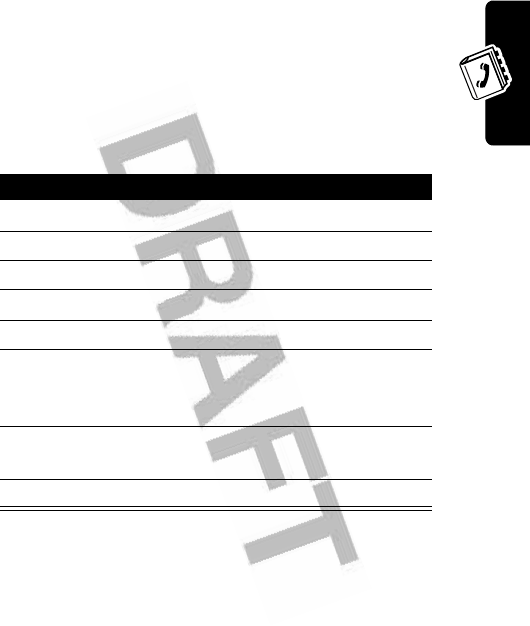
111
Setting Up Your Phonebook
Note:
You cannot record a voice name for an entry stored
on the SIM card.
Tip:
Make your recording in a quiet location. Hold the
phone about 4 inches (10 centimeters) from your
mouth, and speak directly into the phone in a normal
tone.
Dialing a Phonebook Entry
Use 1 of the following procedures to call a number (or send
a text message to an email address or mailing list) stored
in your phonebook.
Phonebook List
Find the Feature
M
>
Phonebook
Action
1
Press
S
to scroll to the entry.
2
Press
VIEW
(
+
) to view entry details.
3
Press
EDIT
(
+
) to edit the entry.
4
Press
S
to scroll to
Voice Name
.
5
Press
RECORD
(
+
) to begin recording.
6
Press and release the voice key and say the
entry’s name (within 2 seconds) to record the
voice name.
7
When prompted, press and release the voice key
and repeat the name.
8
Press
DONE
(
-
) to store the voice name.
Find the Feature
M
>
Phonebook
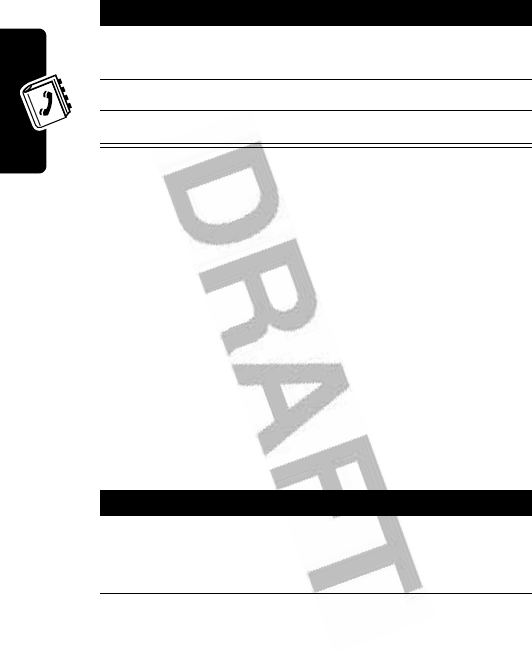
112
Setting Up Your Phonebook
Voice Dial
Press and release the voice key and say the entry’s voice
name (within 2 seconds).
Storing Longer Numbers
A phonebook number can contain a maximum of 32 digits
and characters. You can create multiple phonebook entries
to store a dialing sequence that exceeds the 32-character
limit. Then you can send the entries in sequence to dial the
number.
To store a dialing sequence longer than 32 characters:
Press To
1
keypad key letter jump to entries that begin
with that letter (optional)
2
S
scroll to the entry
3
N
make the call
Action
1
Create a phonebook entry to store the first part
of the dialing sequence (for example, the number
for your long-distance service provider).
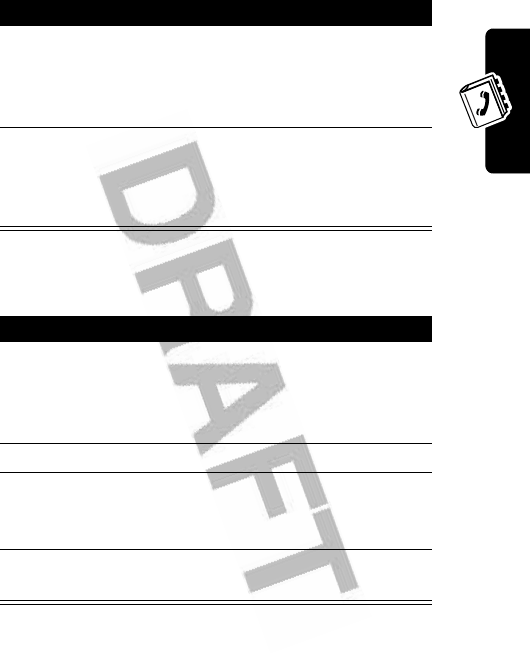
113
Setting Up Your Phonebook
To dial a dialing sequence stored as multiple phonebook
entries:
Editing a Phonebook Entry
2
Create a second phonebook entry to store the
next part of the dialing sequence (for example,
the country code and phone number for an
international call).
3
Repeat step 2 as necessary to store the entire
dialing sequence. (For example, create a third
phonebook entry to store your calling card
number and PIN number.)
Action
1
Dial the first phonebook entry. Perform any
pause or wait tasks, if necessary, to complete
the dialing sequence. Your phone returns to the
home screen.
2
Press
M
>
Phonebook
to reopen the phonebook.
3
Highlight the second phonebook entry, then
press
M
>
Send Tones
to send the next portion of
the dialing sequence.
4
Repeat steps 2 and 3 as necessary to send the
entire dialing sequence.
Find the Feature
M
>
Phonebook
Action
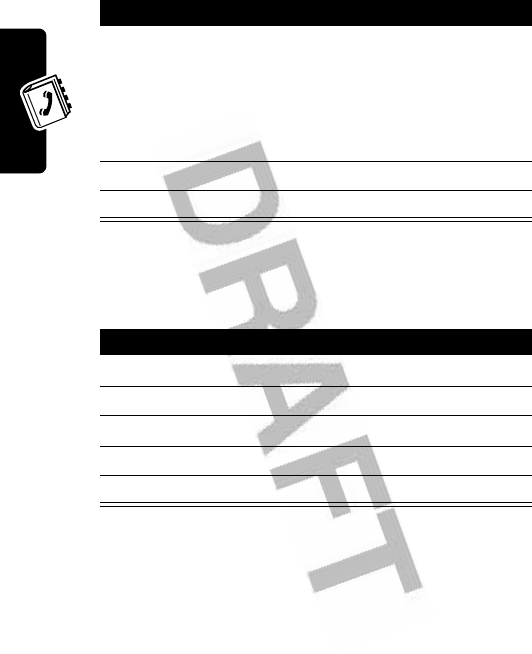
114
Setting Up Your Phonebook
Deleting a Phonebook Entry
Sorting the Phonebook List
You can sort your phonebook list by name (the standard),
speed dial number, voice name, or email address.
Note:
The voice name sort is identical to the name sort,
except that the entries with voice name tags display first.
Press To
1
S
scroll to the entry
Tip:
Press
M
to open the
Phonebook Menu
to perform
various procedures on the
entry.
2
VIEW
(
+
) view entry details
3
EDIT
(
+
) edit the entry
Find the Feature
M
>
Phonebook
Press To
1
S
scroll to the entry
2
M
open the
Phonebook Menu
3
S
scroll to
Delete
4
SELECT
(
+
) select
Delete
5
YES
(
-
) confirm the deletion
Find the Feature
M
>
Phonebook
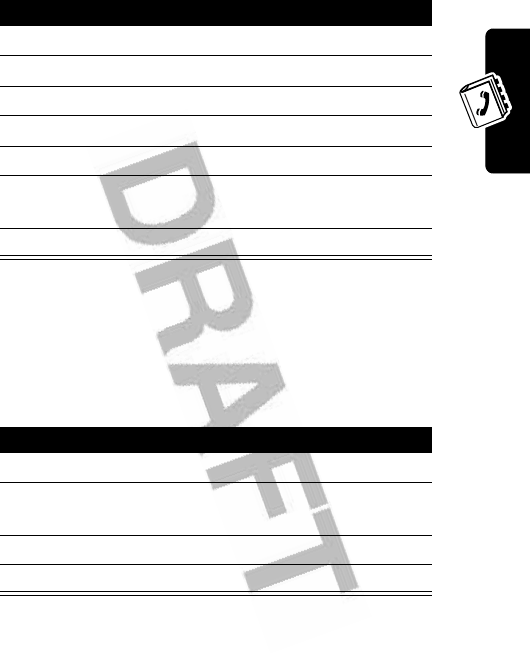
115
Setting Up Your Phonebook
If you select
Speed No.
,
Voice Name
, or
Email
, the procedure is
complete.
If you select
Name
, you must specify whether you want to
view all numbers or just the primary number for each
name:
To set an entry’s primary phone number, see the following
procedure.
Tip:
When the phonebook list displays primary numbers
only, you can scroll to a name and press
S
left or right to
view other numbers associated with the name.
Press To
1
M
open the
Phonebook Menu
2
S
scroll to
Setup
3
SELECT
(
+
)select
Setup
4
S
scroll to
Sort by
5
CHANGE
(
+
)select
Sort by
6
S
scroll to
Name
,
Speed No.
,
Voice Name
, or
Email
7
SELECT
(
+
) select the sort order
Press To
8
CHANGE
(
+
) change view preference
9
S
scroll to
Primary Contacts
or
All Contacts
10
SELECT
(
+
) select the view preference
11
DONE
(
-
) set the view preference
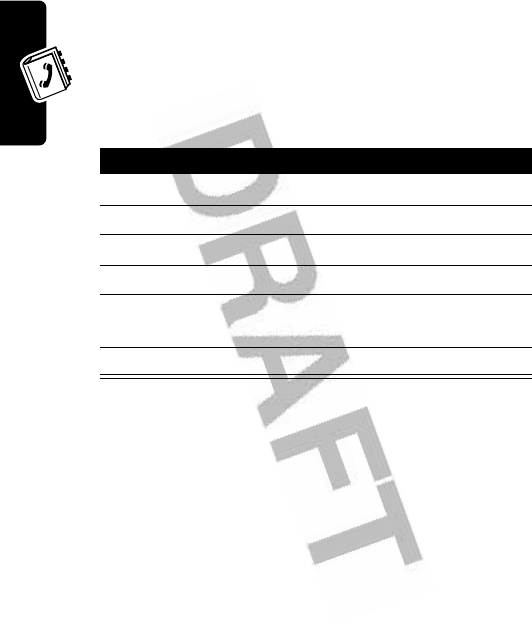
116
Setting Up Your Phonebook
Setting the Primary Number for
a Phonebook Entry
When you enter multiple phone numbers for the same
name, you can specify the primary number.
Depending on how the phonebook list is sorted, the
primary number is listed first, or is the only number that
displays for a phonebook entry.
Using Phonebook Category
Views
Setting the Phonebook Category View
You can view all entries in the phonebook list, or view only
the entries in the category you specify..
Find the Feature
M
>
Phonebook
Press To
1
S
scroll to the entry
2
M
open the
Phonebook Menu
3
S
scroll to
Set Primary
4
SELECT
(
+
) select
Set Primary
5
S
scroll to the number you want
to set as the primary number
6
SELECT
(
+
) set the primary number
Find the Feature
M
>
Phonebook
M
>
Categories

117
Setting Up Your Phonebook
Note:
The phonebook category view is reset to
All
each
time you turn the phone on.
Creating a New Category
Your phone includes several predefined phonebook
categories. You can create additional categories, and
customize the way your phone notifies you of incoming
calls from entries in different categories.
A name is required for the category. All other information is
optional. You can enter the following information for a
category.
Press To
1
S
scroll to
All
,
Business
,
Personal
,
General
,
VIPs
, or another
category that you created
2
SELECT
(
+
) select the category view
3
DONE
(
-
) set the category view
Find the Feature
M
>
Phonebook
M
>
Categories
M
>
New
Option Description
Name
Enter the category name.
Tip:
Press
M
to select a text entry
method (see page 47).
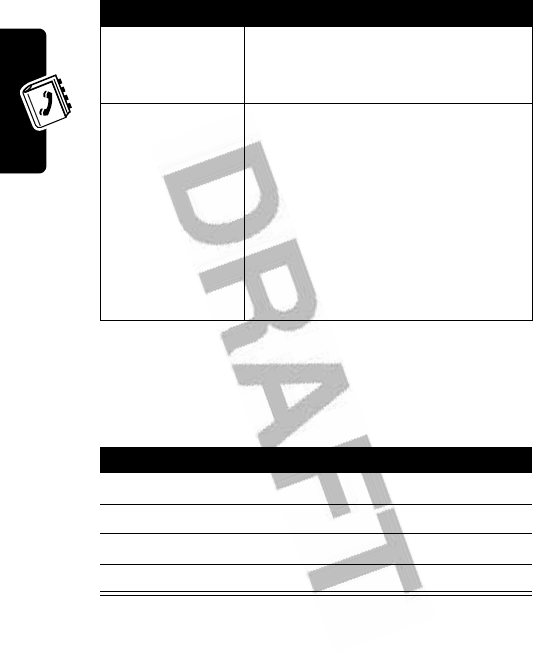
118
Setting Up Your Phonebook
Editing a Category
Edit the category information as described in the previous
section.
Notes:
•
You cannot edit the
All
category.
•
You cannot edit the name of the
General
category.
Members
Open the list of phonebook entries
that you can add or remove from
the category.
Ringer ID
Set a distinctive ringer alert for the
category.
Your phone uses the alert to notify
you when you receive a call from
an entry in this category. To
activate ringer IDs, see page 123.
Note:
A ringer ID for an individual
entry overrides the category alert.
Find the Feature
M
>
Phonebook
M
>
Categories
Press To
1
S
scroll to the category
2
M
open the
Category Details
menu
3
S
scroll to
Edit
4
SELECT
(
+
) edit the category
Option Description
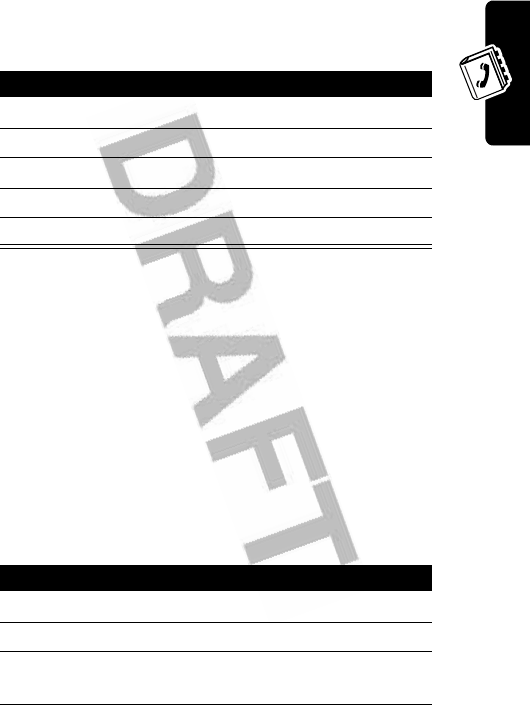
119
Setting Up Your Phonebook
Deleting a Category
Notes:
•
You cannot delete the
All
or
General
categories.
•
When you delete a category, all entries in the category
revert to
General
.
Reordering Categories
You can reorder the items in the category list.
Find the Feature
M
>
Phonebook
M
>
Categories
Press To
1
S
scroll to the category
2
M
open the
Category Details
menu
3
S
scroll to
Delete
4
SELECT
(
+
) delete the category
5
YES
(
-
) confirm the deletion
Find the Feature
M
>
Phonebook
M
>
Categories
M
>
Reorder List
Press To
1
S
scroll to a category
2
GRAB
(
+
) grab the category
3
S
move the category to a new
location in the list
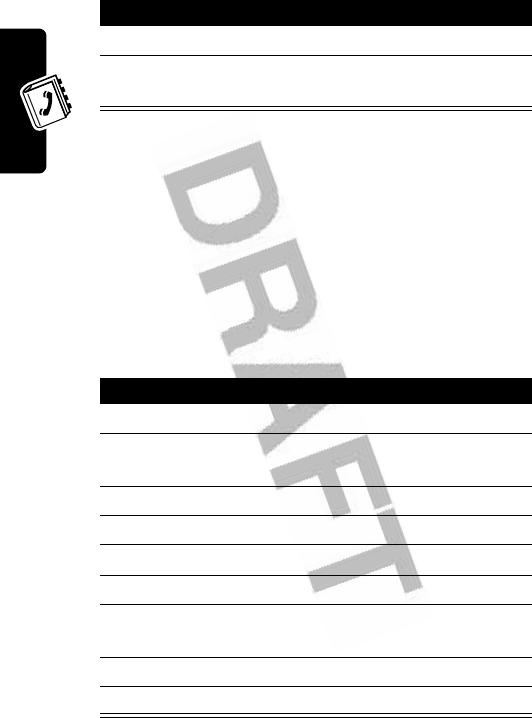
120
Setting Up Your Phonebook
Note:
You cannot move the
All
category.
All
always
remains the first entry in the category view list.
Copying Entries Between the
Phone and SIM Card
Note:
This does
not
delete the original entries.
4
INSERT
(
+
) insert the category
5
DONE
(
-
) store the reordered category
list
Find the Feature
M
>
Phonebook
M
>
Copy Entries
Press To
1
CHANGE
(
+
) select
Entries
2
S
scroll to entries you want to
copy
3
ADD
(
+
) add a highlighted entry
4
DONE
(
-
) store the selected entries
5
S
scroll to
To
6
CHANGE
(
+
) select
To
7
S
scroll to
Phone Memory
or
SIM Card
8
SELECT
(
+
) select the destination
9
DONE
(
-
) copy the entries
Press To
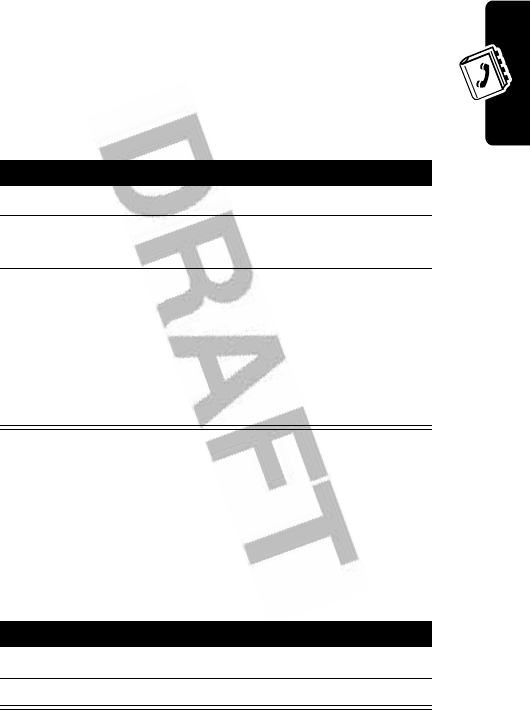
121
Setting Up Your Phonebook
Checking Phonebook Capacity
You can see how much memory space remains for
storing phonebook and datebook entries on the phone,
and how many more phonebook entries you can store
on the SIM card.
Setting 1-Touch Dial Preference
You can set 1-touch dial to call the entries in your phone
memory phonebook or the SIM card phonebook.
Find the Feature
M
>
Phonebook
Press To
1
M
open the
Phonebook Menu
2
S
scroll to
Phone Capacity
or
SIM Capacity
3
SELECT
(
+
)select
Phone Capacity
or
SIM Capacity
Your phone displays the
phone memory meter, or the
number of SIM card
phonebook entries available.
Find the Feature
M
>
Settings
>
Initial Setup
>
1-Touch Dial
Press To
1
S
scroll to the list you want
2
SELECT
(
+
) select the list

122
Setting Up Your Phonebook
Synchronizing Phonebook
Entries
You can synchronize phonebook entries
between your phone and computer or
hand-held device with BVRP Mobile
PhoneTools software, included with your
phone. See the Mobile PhoneTools user’s guide for more
information.
Note:
Mobile PhoneTools software is designed to
synchronize with basic features of many popular Personal
Information Management (PIM) software and hardware
products.
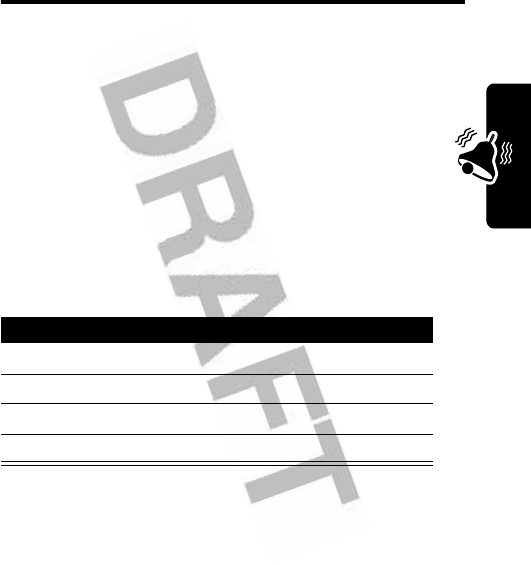
123
Personalizing Your Phone
Personalizing Your
Phone
Personalizing an Alert Style
You can change the alerts that notify you of the following
events: incoming calls, text messages, voicemail
messages, data calls, fax calls, alarms, and reminders.
Any changes you make are applied to the current alert
style.
Note:
Style represents the current alert style.
Activating Ringer IDs
When ringer IDs are turned on, your phone uses distinctive
ring tones to notify you of incoming calls or messages from
specific entries in your phonebook.
Find the Feature
M
>
Settings
>
Ring Styles
>Style
Detail
Press To
1
S
scroll to the event
2
CHANGE
(
+
) select the event
3
S
scroll to the alert you want
4
SELECT
(
+
) select the alert
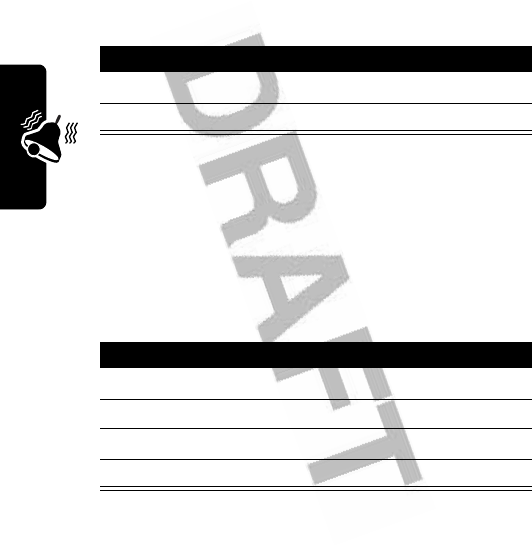
124
Personalizing Your Phone
Note:
To assign a ringer ID to a new or existing phonebook
entry, see page 105.
Note:
Style represents the current alert style.
Setting Ringer or Keypad
Volume
Note:
Style represents the current alert style.
Find the Feature
M
>
Settings
>
Ring Styles
>Style
Detail
>
Ringer IDs
Press To
1
S
scroll to
On
or
Off
2
SELECT
(
+
) select the option
Find the Feature
M
>
Settings
>
Ring Styles
>Style
Detail
Press To
1
S
scroll to
Ring Volume
or
Key Volume
2
SELECT
(
+
) select the option
3
S
left or right scroll to the desired volume
4
OK
(
+
) store the setting
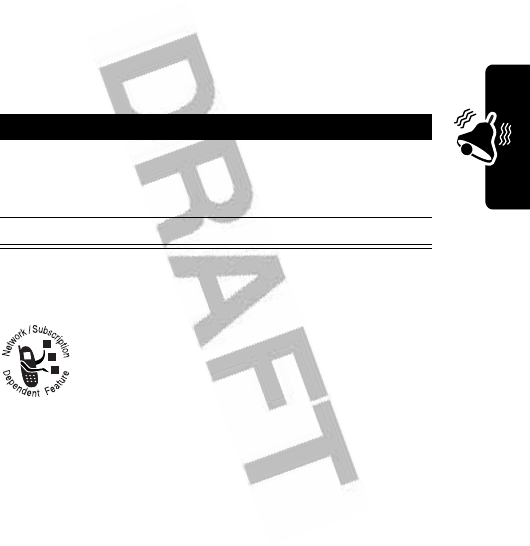
125
Personalizing Your Phone
Setting Reminders
A reminder is an alert that rings or vibrates at regular
intervals to notify you about a message that you have
received.
Note:
Style represents the current alert style.
Setting a Personal Greeting
To set a personal greeting that displays when
you turn on your phone:
Setting Display Text
Text that is displayed in the home screen can be left
justified or centered.
Find the Feature
M
>
Settings
>
Ring Styles
>Style
Detail
>
Reminders
Press To
1
S
scroll to
Beep
or
Vibrate
to set
the reminder alert type, or
Off
to turn off all reminders
2
SELECT
(
+
) select the reminder alert
Find the Feature
M
>
Settings
>
Personalize
>
Greeting
Find the Feature
M
>
Settings
>
Personalize
>
Home Screen
>
Layout
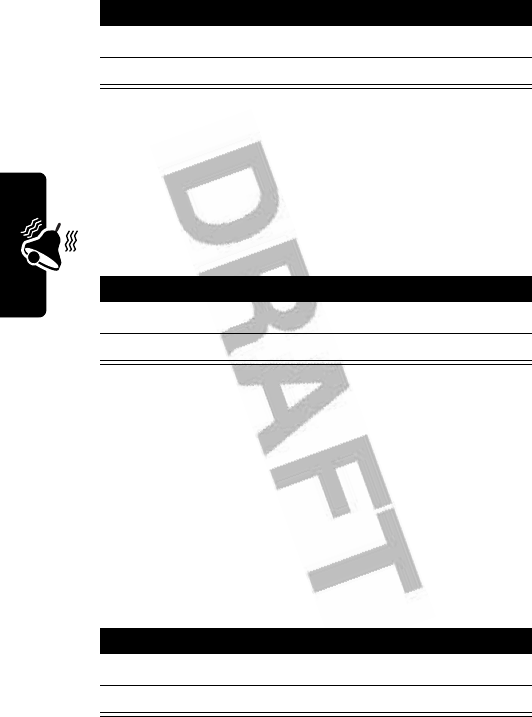
126
Personalizing Your Phone
Selecting the Clock View
You can display an analog clock or a digital time readout in
the home screen.
Showing or Hiding Menu Icons
You can show or hide the menu feature icons that display
in the home screen. When you select
Hide
, the menu icons
are hidden but remain active in the home screen, and you
can press
S
to select them as usual.
Press To
1
S
scroll to
Left Justified
or
Centered
2
SELECT
(
+
) select the text layout
Find the Feature
M
>
Settings
>
Personalize
>
Home Screen
>
Clock
Press To
1
S
scroll to
Analog
or
Digital
2
SELECT
(
+
) select the clock view
Find the Feature
M
>
Settings
>
Personalize
>
Home Screen
>
Home Keys
>
Icons
Press To
1
S
scroll to
Show
or
Hide
2
SELECT
(
+
) select the option
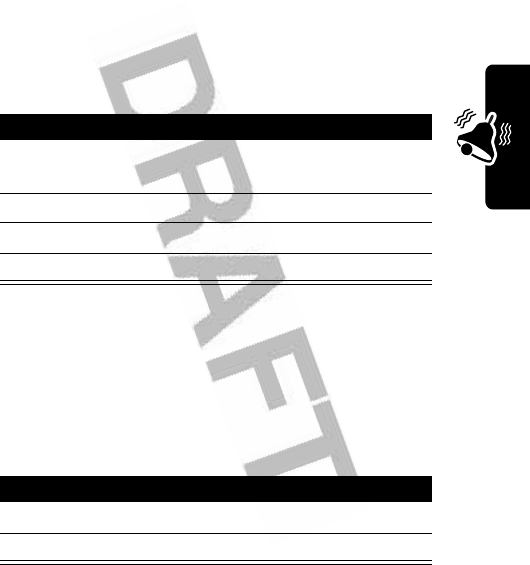
127
Personalizing Your Phone
Personalizing Soft Keys and
Menu Icons
You can change the menu feature icons and soft key labels
(left
-
and right
+
) that display in the home screen, to
access different main menu items from the home screen.
Setting the Menu View
You can set your phone to display the main menu as
graphic icons (the default setting) or as a text-based list.
Find the Feature
M
>
Settings
>
Personalize
>
Home Screen
>
Home Keys
Press To
1
S
scroll to
Up
,
Down
,
Left
,
Right
,
Left Soft Key
, or
RightSoftKey
2
CHANGE
(
+
) select the icon or soft key
3
S
scroll to a menu feature
4
SELECT
(
+
) confirm the menu feature
Find the Feature
M
>
Settings
>
Personalize
>
Main Menu
>
View
Press To
1
S
scroll to
Icons
or
List
2
SELECT
(
+
) select the menu view
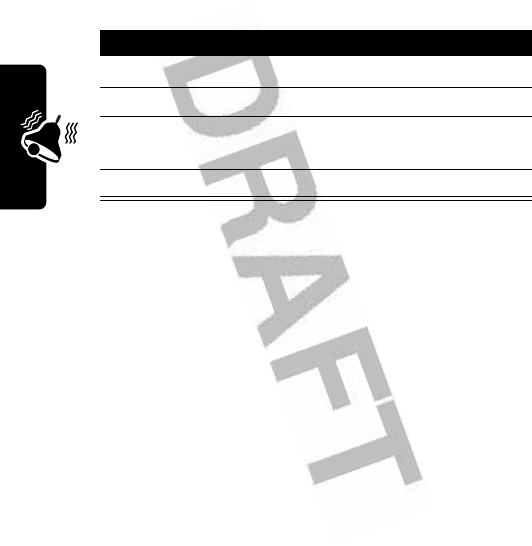
128
Personalizing Your Phone
Personalizing the Menu
You can reorder the items in your phone’s main menu.
Setting the Menu Language
Set the language in which menu features and options are
displayed.
Setting Menu Scroll Behavior
Set the highlight bar to stop or wrap around when you
reach the top or bottom of a menu list.
Find the Feature
M
>
Settings
>
Personalize
>
Main Menu
>
Reorder
Press To
1
S
scroll to a menu item
2
GRAB
(
+
) grab the menu item
3
S
move the item to a new
location in the menu
4
INSERT
(
+
) insert the menu item
Find the Feature
M
>
Settings
>
Initial Setup
>
Language
Find the Feature
M
>
Settings
>
Initial Setup
>
Scroll
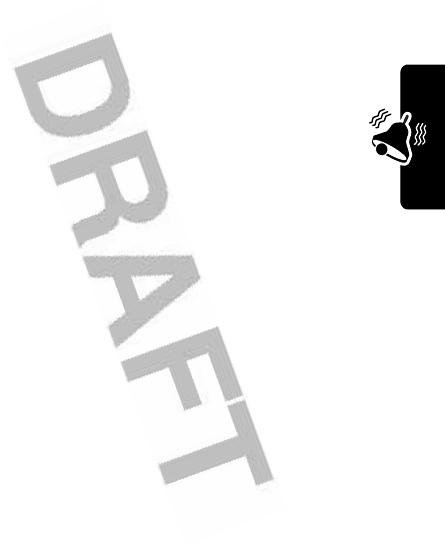
129
Personalizing Your Phone
Resetting All Options
Reset all options back to their original factory settings,
except
for the unlock code, security code, and lifetime
timer.
Clearing All Stored
Information
Reset all options back to their original factory settings,
except
for the unlock code, security code, and lifetime
timer, erase all downloaded pictures, animations and
sound files, and clear all user settings and entries,
except
for information stored on the SIM card.
Caution:
Master clear
erases all user-downloaded
content and user-entered information
stored in your
phone’s memory, including phonebook and datebook
entries. After you erase the information, you cannot
recover it. Master clear does
not
delete any information
stored on the SIM card.
Creating and Using Shortcuts
Your phone includes several standard shortcuts. You can
create additional custom shortcuts to frequently used
menu items.
Find the Feature
M
>
Settings
>
Initial Setup
>
Master Reset
Find the Feature
M
>
Settings
>
Initial Setup
>
Master Clear
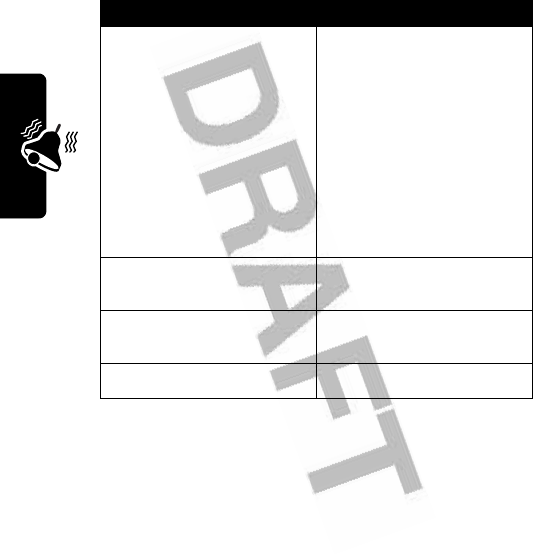
130
Personalizing Your Phone
Standard Shortcuts
The following shortcuts are preprogrammed on your
phone. You cannot edit or delete these shortcuts.
Creating a Shortcut
You can create a keypad shortcut
and
an optional voice
shortcut to a menu item. A voice shortcut takes you
directly to the menu item when you say the shortcut name.
Task Shortcut
Change your phone’s
ringer alert setting.
Open the flip, then press
the down volume key (at
lowest volume setting) to
switch to vibrate call
alert. Press again to
switch to silent call alert.
Press the up volume key
to cycle back to vibrate
alert, then ring alert.
Display your phone
number.
From the home screen,
press
M#
.
Go to the dialed calls list. From the home screen,
press
N
.
Exit the menu system. Press
O
.
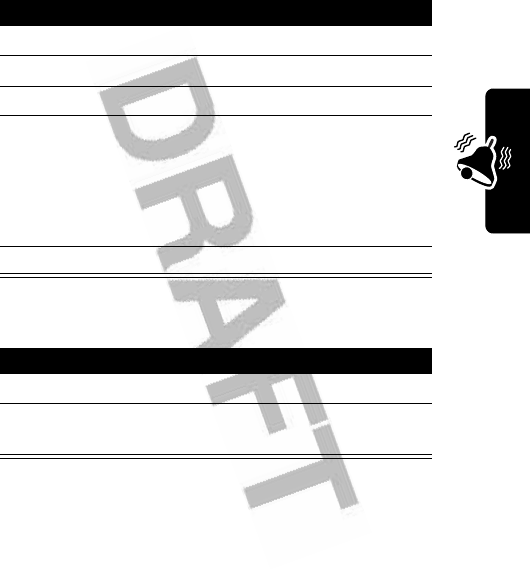
131
Personalizing Your Phone
Tip:
Make your recording in a quiet location. Hold the
phone about 4 inches (10 centimeters) from your mouth,
and speak directly into the phone in a normal tone.
Using a Keypad Shortcut
Selecting a Shortcut from the List
Action
1
Press
M
to enter the menu system.
2
Press
S
to scroll to the menu item.
3
Press and hold
M
to open the shortcut editor.
4
Press
YES
(
-
) to view shortcut options.
Name
is the name for the shortcut.
Key
is the keypad shortcut number
Voice
lets you assign a foice name to the shortcut.
5
Press
DONE
(
-
) to store the shortcut.
Press To
1
M
open the main menu
2
a number key go to the menu item with
that shortcut number
Find the Feature
M
>
Office Tools
>
Shortcuts
>shortcut name
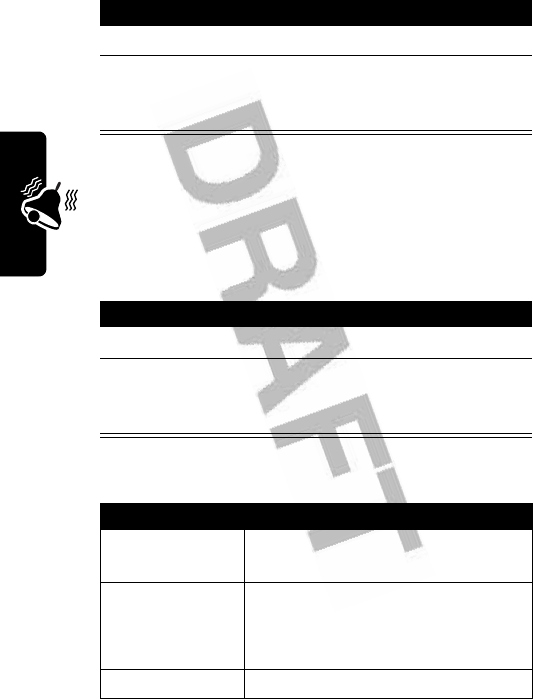
132
Personalizing Your Phone
Using a Voice Shortcut
Editing or Deleting a Shortcut
The shortcut list is sorted by key. If you change a
shortcut’s key, you change its place in the list.
The
Shortcut Menu
can include the following options:
Action
1
Press
M
to open the menu.
2
Press and release the voice key and say the
shortcut’s name (within 2 seconds) to go to the
menu item with that shortcut name.
Find the Feature
M
>
Office Tools
>
Shortcuts
Press To
1
S
scroll to the shortcut
2
M
open the
Shortcut Menu
to
perform various procedures
on the shortcut
Option Description
New
Read instructions on how to
create a new shortcut.
Edit
Edit the shortcut.
Tip:
Use this option to delete the
associated voice shortcut.
Reorder List
Change the shortcut list order.
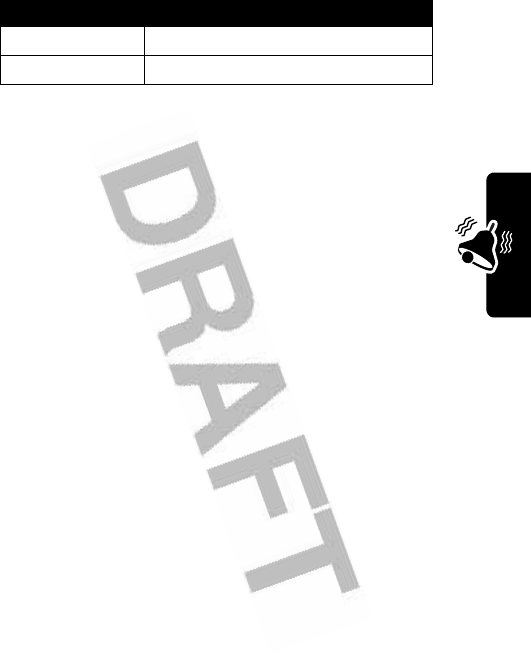
133
Personalizing Your Phone
Delete
Delete the shortcut.
Delete All
Delete all shortcuts.
Option Description
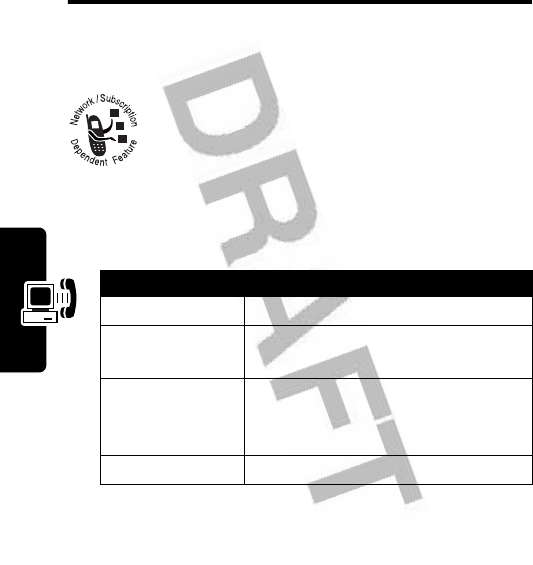
134
Getting More Out Of Your Phone
Getting More Out Of
Your Phone
Forwarding Calls
You can forward your phone’s incoming voice,
fax, and/or data calls directly to another phone
number.
Setting Up or Canceling Call Forwarding
The forwarding options for voice, fax, or data calls are:
Option Description
All Calls
Forward all calls.
If Unavailable
Forward calls if your phone is
unavailable.
Detailed
Set different forwarding numbers
if you are out of range, unable to
answer, or busy (voice calls only).
Off
Do not forward calls.
Find the Feature
M
>
Settings
>
Call Forward
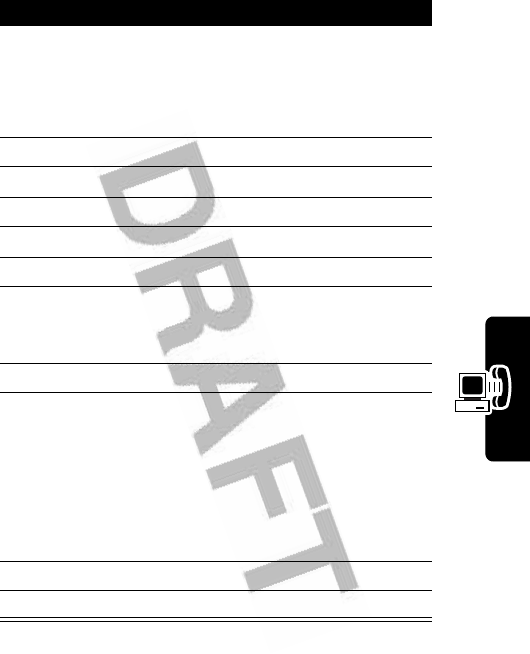
135
Getting More Out Of Your Phone
Note:
Repeat this procedure to enter forwarding
information for other call types.
Press To
1
S
scroll to the type of calls you
want to forward
Scroll to
Cancel All
to cancel all
call forwarding.
2
SELECT
(
+
) view call forwarding details
3
S
scroll to
Forward
4
CHANGE
(
+
)select
Forward
5
S
scroll to a forwarding option
6
SELECT
(
+
) store the option
7
S
scroll to
To
(for
Detailed
forwarding, scroll to
If Busy
,
If No Answer
, or
If Unreachable
)
8
CHANGE
(
+
)select
To
9
keypad keys
or
BROWSE
(
+
)
enter the forwarding phone
number
select a number from the
phonebook or recent calls
lists
10
OK
(
+
) store the number
11
DONE
(
-
) save call forwarding settings
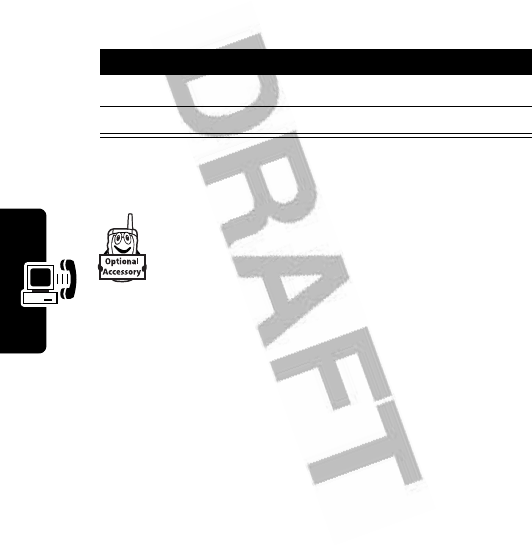
136
Getting More Out Of Your Phone
Checking Call Forwarding Status
Your network may store call forwarding status for you. To
confirm the network call forwarding settings:
TTY Operation
You can use an optional TTY device with your
phone to send and receive calls. You must plug
the TTY device into the phone’s headset jack
and set the phone to operate in 1 of 3 TTY
modes.
Notes:
•
Use a TSB-121 compliant cable (provided by the TTY
manufacturer) to connect the TTY device to your
phone.
•
Set the phone volume to level 4 (middle setting) for
proper operation. If you experience a high number of
incorrect characters, adjust the volume as necessary
to minimize the error rate.
•
For optimal performance, your phone should be at
least 12 inches (30 centimeters) away from the TTY
device. Placing the phone too close to the TTY device
may cause high error rates.
Find the Feature
M
>
Settings
>
Call Forward
>
Forward Status
Press To
1
S
scroll to
Voice
,
Fax
, or
Data
2
View
(
+
) confirm the network setting
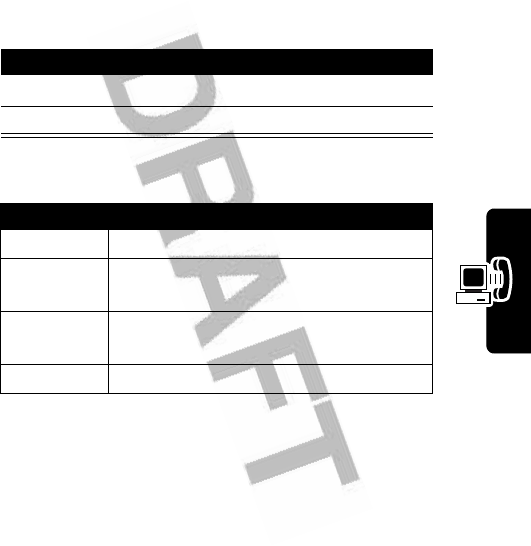
137
Getting More Out Of Your Phone
Setting TTY Mode
When you set your phone to a TTY mode, it operates in
that mode whenever the TTY device is connected.
The
TTY Setup
menu can include the following options:
When your phone is in a TTY mode, the international
TTY symbol and the mode setting display during an
active TTY call.
Returning to Voice Mode
To return to normal voice mode, select
Voice
from the
TTY Setup
menu.
Find the Feature
M
>
Settings
>
Initial Setup
>
TTY Setup
Press To
1
S
scroll to the TTY mode
2
SELECT
(
+
) select the TTY mode
Option Description
TTY
Transmit and receive TTY characters.
VCO
Receive TTY characters but transmit
by speaking into the microphone.
HCO
Transmit TTY characters but receive
by listening to the earpiece.
Voice
Return to normal voice mode.
ù
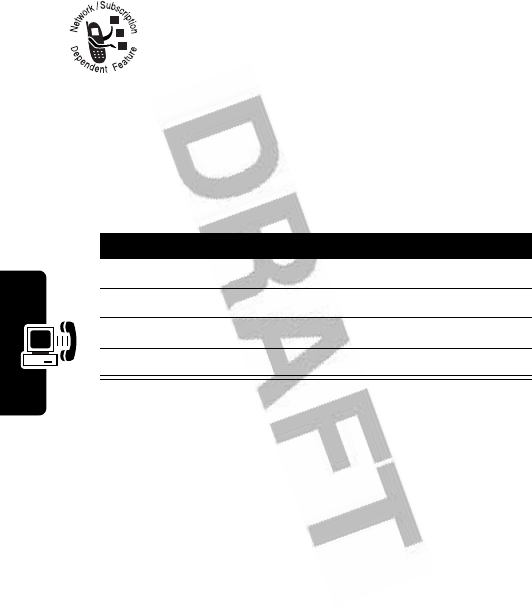
138
Getting More Out Of Your Phone
Using Fixed Dialing
When you turn on fixed dialing, you can only call
numbers stored in the fixed dial list. Use this
feature to limit outgoing calls to a predefined list
of numbers, country codes, area codes, or other
prefixes.
Turning Fixed Dialing On or Off
Using the Fixed Dial List
You must turn on fixed dialing to open the fixed dial list.
You create and edit fixed dial entries just like phonebook
entries. Fixed dial entries are stored on your SIM card, and
do not have
Type
,
Voice Name
, or
Ringer ID
information.
Find the Feature
M
>
Settings
>
Security
>
Fixed Dial
Press To
1
keypad keys enter your SIM PIN2 code
2
OK
(
+
) open the fixed dial menu
3
S
scroll to
On
or
Off
4
SELECT
(
+
) select the option
Find the Feature
M
>
Office Tools
>
Dialing Services
>
Fixed Dial
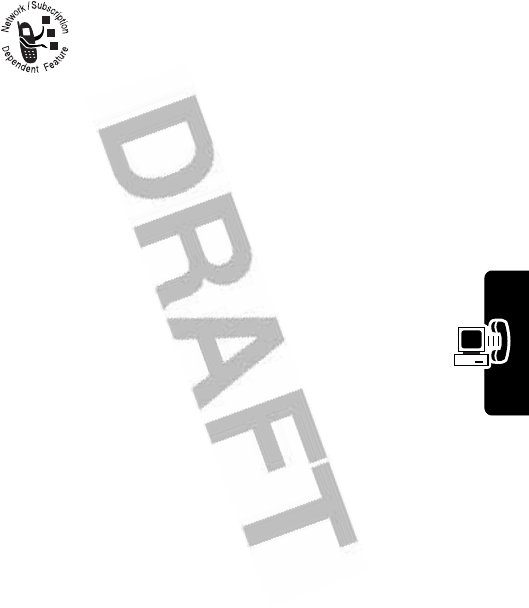
139
Getting More Out Of Your Phone
Using Service Dialing
Dial preprogrammed numbers stored on your
SIM card. Your service provider may program
your SIM card with numbers for services such
as taxi companies, restaurants, and hospitals.
Using DTMF Tones
You can send numbers to the network as Dual Tone
Multi-Frequency (DTMF) tones during a call. Use DTMF
tones to communicate with automated systems that
require you to submit a PIN code or credit card number.
Activating DTMF Tones
You can set DTMF tones to
Long
,
Short
, or
Off
:
Short
sends a short fixed-duration tone for each keypress.
Long
sends each tone for as long as you press the key.
Short DTMF tones work with most automated systems.
Some systems (such as home answering machines) may
require long tones for proper activation.
Find the Feature
M
>
Office Tools
>
Dialing Services
>
Service Dial
Find the Feature
M
>
Settings
>
Initial Setup
>
DTMF
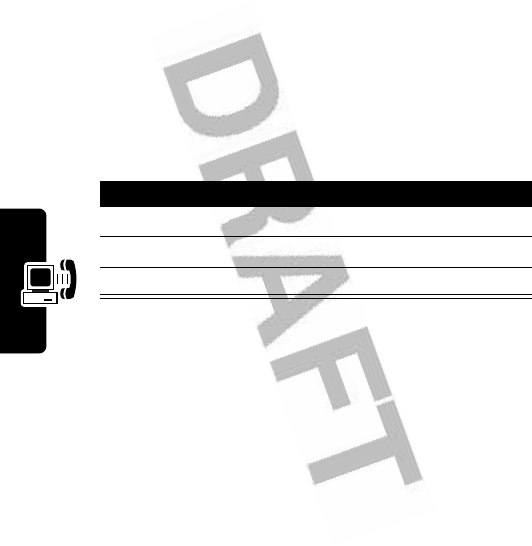
140
Getting More Out Of Your Phone
Sending DTMF Tones
Using the Keypad
Press the number keys to send the numbers as DTMF
tones during a call.
Note:
When sending long tones, you may have to enter a
single short keypress first to put the phone in DTMF mode.
Sending Stored Numbers
During a call, highlight a number in the phonebook or
recent calls lists, then:
Monitoring Phone Use
View and Reset Call Timers
Network connection time
is the elapsed time from the
moment you connect to your service provider's network to
the moment you end the call by pressing
O
. This time
includes busy signals and ringing.
The amount of network connection time you track on
your resettable timer may not equal the amount of time
for which you are billed by your service provider. For
billing information, please contact your service
provider directly.
Press To
1
M
open the sub-menu
2
S
scroll to
Send Tones
3
SELECT
(
+
) send number as DTMF tones
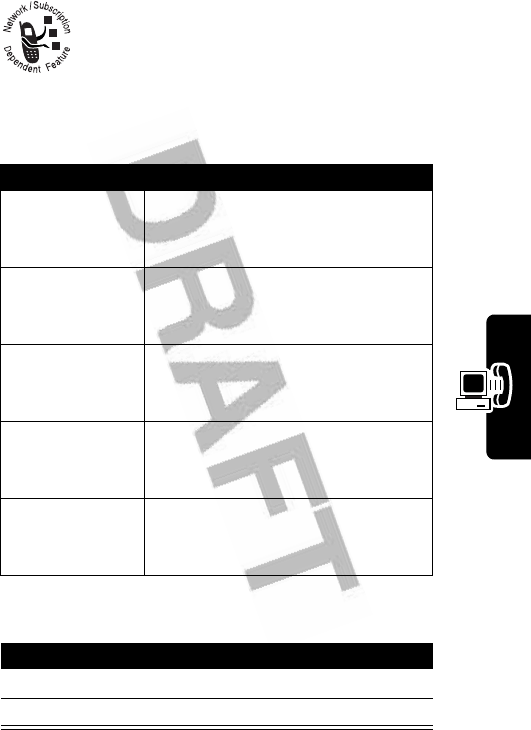
141
Getting More Out Of Your Phone
To view a call timer:
Select 1 of the following options:
To reset the call timer:
Find the Feature
M
>
Recent Calls
>
Call Times
Option Description
Last Call
Approximate time spent on the
last dialed or received call. You
cannot reset this timer.
Dialed Calls
Approximate total time spent on
dialed calls since the last time you
reset this timer.
Received Calls
Approximate total time spent on
calls received since the last time
you reset this timer.
All Calls
Approximate total time spent on
dialed and received calls since the
last time you reset this timer.
Lifetime
Approximate total time spent on
all calls on this phone. You cannot
reset this timer.
Press To
1
RESET
(
+
) reset the time (if available)
2
YES
(
-
) confirm the reset
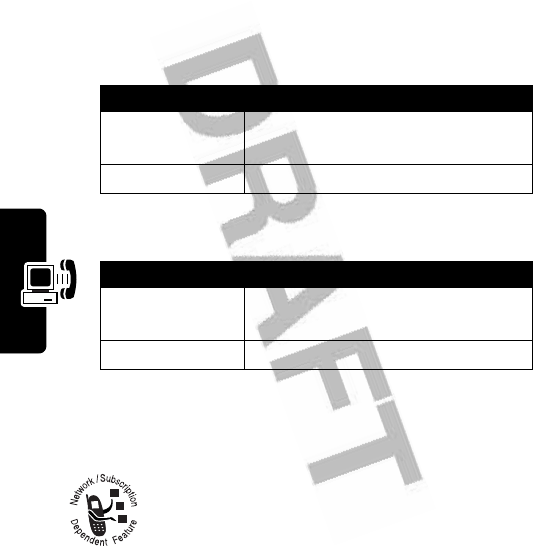
142
Getting More Out Of Your Phone
Using a Timer During a Call
You can set a timer to beep at selected intervals during a
call, and display different types of information during a call.
Select 1 of the following
Beep
options:
Select one of the following
Display
options:
Viewing and Resetting GPRS Packet Data
Timers and Data Volume Meters
Your phone may use a high-speed General
Packet Radio Service (GPRS) network
connection to transfer data during a data or fax
call. This type of procedure, where an external
device uses your phone to upload or download data, is
referred to as an external data session.
Find the Feature
M
>
Settings
>
In-Call Setup
>
In-Call Timer
Option Description
60 Seconds
Beep at 1-minute intervals during
a call.
Off
No in-call beep.
Option Description
Time
Display the approximate elapsed
time for the current call.
Off
No in-call timer display.
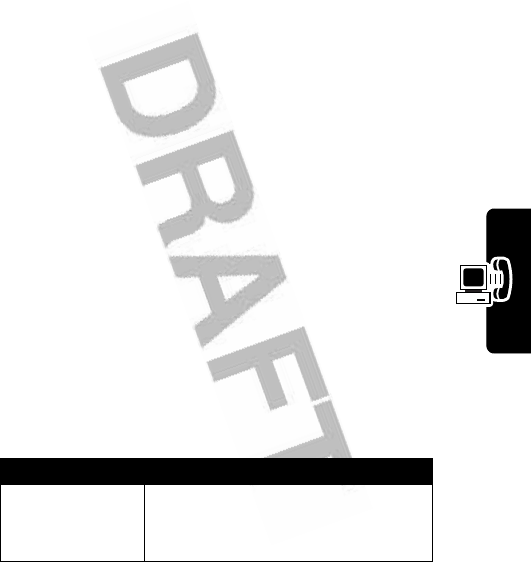
143
Getting More Out Of Your Phone
mMode also may use a GPRS connection to upload and
download data from the Internet. This is an example of an
internal data session.
Your phone tracks, in 1-minute increments, the
approximate time spent and approximate volume of data
transferred during these data sessions.
The amount of data session time and data transfer
volume you track on your resettable data timers and
data volume meters may not equal the amount of data
session time or data transfer volume for which you are
billed by your service provider. For billing information,
please contact your service provider directly.
Data Timers
You can view the approximate time spent on the last
data session, view the approximate total time spent on
all data sessions, and reset the
All Data Sessions
timers.
To view timers for the last data session:
Select 1 of the following options:
Find the Feature
M
>
Recent Calls
>
Data Times
>
Recent Data Session
Option Description
External Data
Session
Approximate time spent on the
last external data session. You
cannot reset this timer.
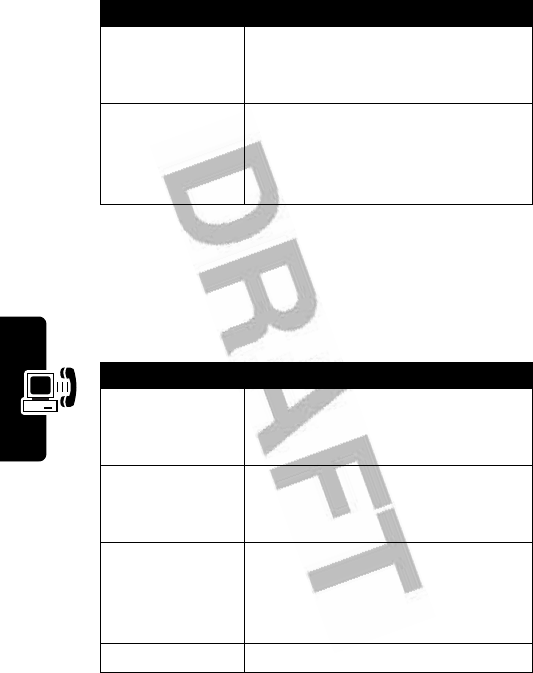
144
Getting More Out Of Your Phone
To view or reset cumulative timers for all data sessions:
Select 1 of the following options:
Internal Data
Session
Approximate time spent on the
last internal data session. You
cannot reset this timer.
Total Time
Approximate total time spent on
the last external and internal data
sessions. You cannot reset this
timer.
Find the Feature
M
>
Recent Calls
>
Data Times
>
All Data Sessions
Option Description
External Data
Session
Approximate total time spent on
all external data sessions since
the last time you reset this timer.
Internal Data
Session
Approximate total time spent on
all internal data sessions since the
last time you reset this timer.
Total Time
Approximate total time spent on
all external and internal data
sessions since the last time you
reset this timer.
Reset All
Reset all data sessions timers.
Option Description
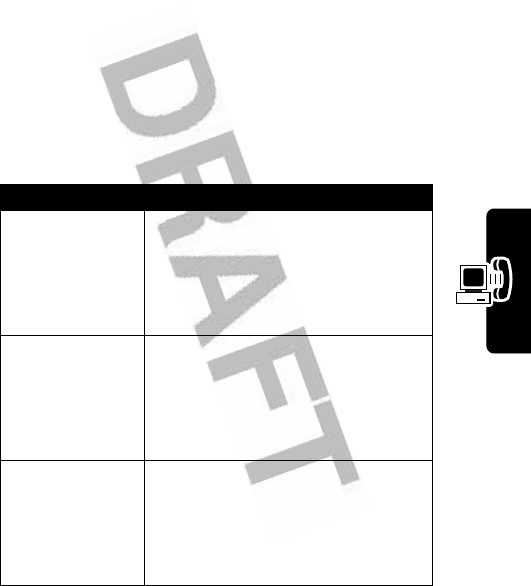
145
Getting More Out Of Your Phone
Data Volume Meters
You can view the volume of data transferred during the
most recent data session, view the total amount of data
transferred for all data sessions, and reset the
All Data Sessions
volume meters.
To view volume meters for the last data session:
Select 1 of the following options:
Find the Feature
M
>
Recent Calls
>
Data Volumes
>
Recent Data Session
Option Description
External Data
Session
View data sent, data received,
and total volume of data sent and
received during the last external
data session. You cannot reset
this volume meter.
Internal Data
Session
View data sent, data received,
and total volume of data sent and
received during the last internal
data session. You cannot reset
this volume meter.
Total Data
Transferred
View data sent, data received,
and total volume of data sent and
received during the last external
and internal data sessions. You
cannot reset this volume meter.
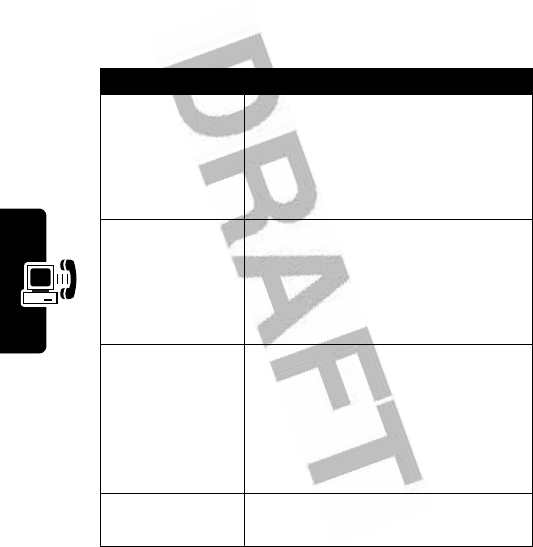
146
Getting More Out Of Your Phone
To view or reset cumulative volume meters for all data
sessions:
Select 1 of the following options:
Find the Feature
M
>
Recent Calls
>
Data Volumes
>
All Data Sessions
Option Description
External Data
Session
View data sent, data received,
and total volume of data sent and
received for all external data
sessions since the last time you
reset this volume meter.
Internal Data
Session
View data sent, data received,
and total volume of data sent and
received for all internal data
sessions since the last time you
reset this volume meter.
Total Data
Transferred
View data sent, data received,
and total volume of data sent and
received for all external and
internal data sessions since the
last time you reset this volume
meter.
Reset All
Reset all data sessions volume
meters.
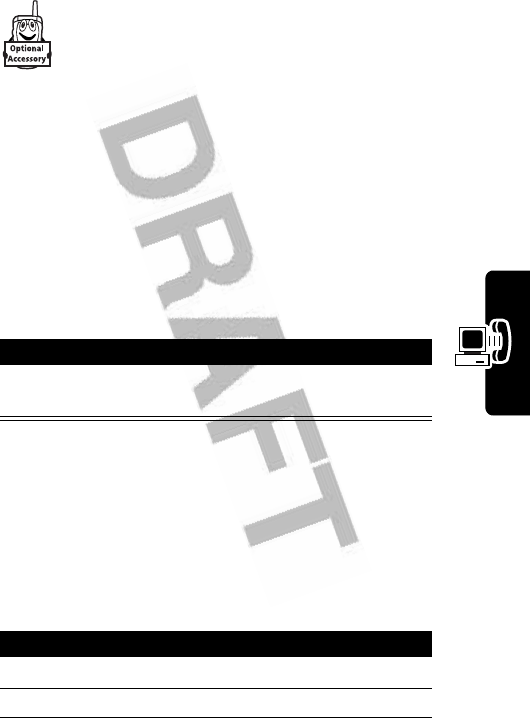
147
Getting More Out Of Your Phone
Using Handsfree Features
You can purchase an optional Motorola Original™
handsfree car kit, speakerphone, or headset for
your phone. These accessories provide alternative
ways for you to use your phone without using your
hands.
Note:
The use of wireless devices and their accessories
may be prohibited or restricted in certain areas. Always
obey the laws and regulations on the use of these
products.
Activating an External Speakerphone
To use an external speakerphone with your phone,
connect the speakerphone and, during an active call:
Automatic Answer
Set your phone to automatically answer calls after 2 rings
(4 seconds) when connected to a car kit, speakerphone, or
headset.
Press To
SPEAKER
(
+
) (if available)
or
M
>
Spkrphone On
activate the connected
speakerphone
Find the Feature
M
>
Settings
>
Car Settings
or
Headset
Press To
1
S
scroll to
Auto Answer
2
SELECT
(
+
)select
Auto Answer
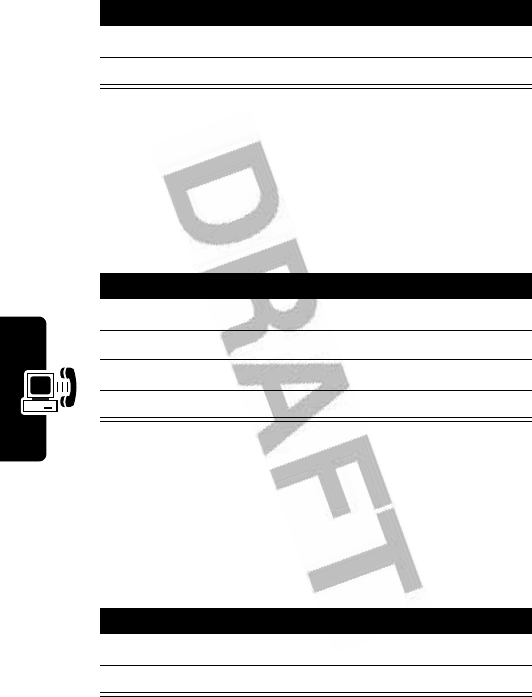
148
Getting More Out Of Your Phone
Voice Dial From Headset
If your headset has a send/end key, this feature enables
you to press the send/end key to voice dial a call from the
headset.
Automatic Handsfree
Set your phone to automatically route calls to a car kit
when it detects a connection.
3
S
scroll to
On
or
Off
4
SELECT
(
+
) confirm the setting
Find the Feature
M
>
Settings
>
Headset
Press To
1
S
scroll to
Voice Dial
2
SELECT
(
+
) select
Voice Dial
3
S
scroll to
On
or
Off
4
SELECT
(
+
) confirm the setting
Find the Feature
M
>
Settings
>
Car Settings
>
Auto Handsfree
Press To
1
S
scroll to
On
or
Off
2
SELECT
(
+
) confirm the setting
Press To
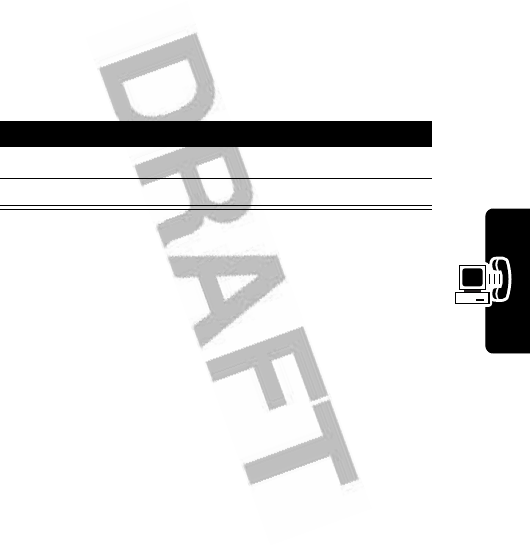
149
Getting More Out Of Your Phone
Power-Off Delay
When connected to a car kit, you can set your phone to
stay on for a period of time after you switch off the ignition.
This prevents the phone from draining your vehicle battery,
but leaves the phone on long enough that you do not have
to re-enter your unlock code when making short stops.
Note:
This feature may not work with all car ignition
switches.
Caution:
If you select
Continuous
, the phone does not
power off when you turn off the ignition. Be careful not to
drain your vehicle battery if you select this option.
Charger Time
When connected to a car kit, you can set your phone to
charge itself for a specified time period after you switch off
the ignition. This helps ensure that the phone battery gets
fully charged while the vehicle is parked.
Find the Feature
M
>
Settings
>
Car Settings
>
Power-Off Delay
Press To
1
S
scroll to the time delay
2
SELECT
(
+
) confirm your selection
Find the Feature
M
>
Settings
>
Car Settings
>
Charger Time
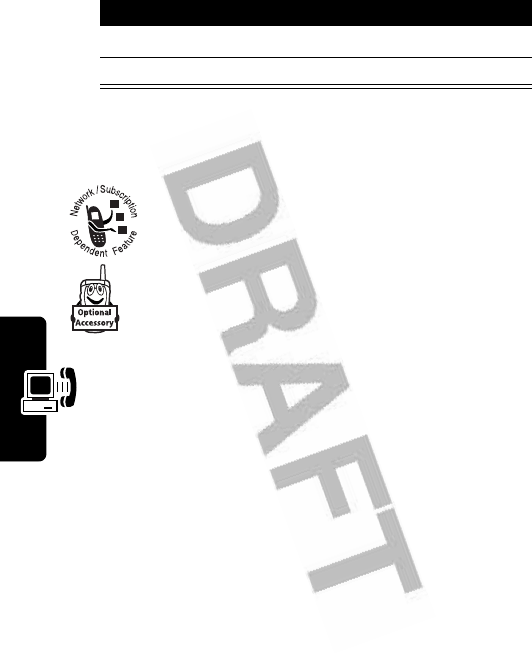
150
Getting More Out Of Your Phone
Note:
This feature may not work with all car ignition
switches.
Making Data and Fax
Calls
An optional Motorola Original data kit (which
includes a cable connector) lets you transfer data
between your phone and a computer, Palm OS
®
compatible device, or Microsoft Windows CE,
Pocket PC, or Handheld PC device. You can:
•
Use your phone as a modem to connect to the
Internet.
•
Use your phone to send and receive data and fax calls
from your computer or handheld device.
You can also synchronize phonebook and datebook
information between your phone, computer, and PDA with
BVRP Mobile PhoneTools software, included with your
phone.
Making a Cable Connection
Installing the Software
To transfer data between your phone and computer, you
must install the software included with the Motorola
Press To
1
S
scroll to the charge time
2
SELECT
(
+
) confirm your selection
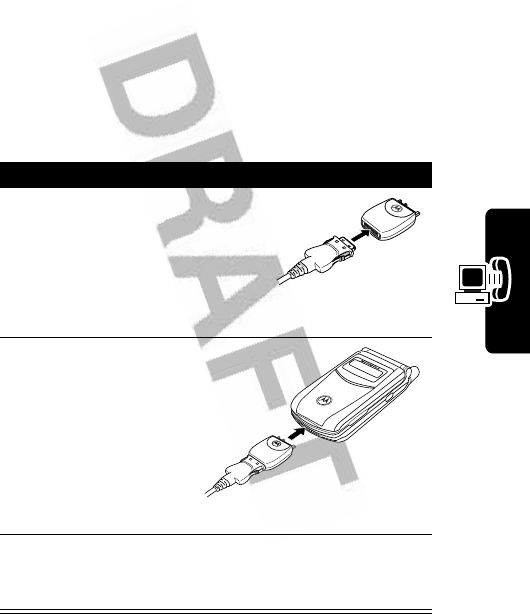
151
Getting More Out Of Your Phone
Original data kit. See the data kit user’s guide for more
information.
Attaching the Cable
Use a Motorola Original serial cable or Motorola Original
USB cable to connect your phone to the external device.
Note:
Not all devices are compatible with a cable
connection. Check your computer or hand-held device to
determine the type of cable you need.
Serial Cable
Action
1
Plug the serial cable into
the detachable head. Make
sure that the Motorola logo
on the detachable head and
the metal shielding on the
serial cable plug are both facing you.
2
With the Motorola
logo and the
phone both facing
you, plug the
detachable head
into the phone’s
accessory
connector port.
3
Plug the other end of the cable into the serial
interface connection on the device and tighten
the screws, if present.
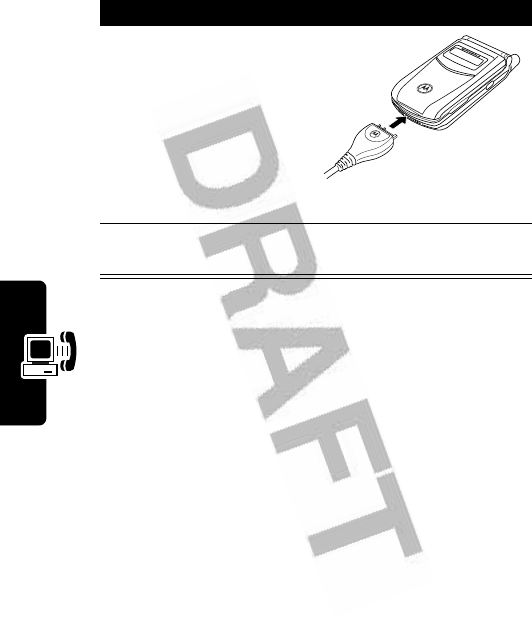
152
Getting More Out Of Your Phone
USB Cable
Synchronizing Data
You can synchronize phonebook and datebook
information between your phone, computer, and PDA
with BVRP Mobile PhoneTools software, included with
your phone. See the Mobile PhoneTools user’s guide for
more information.
Note:
BVRP Mobile PhoneTools software is designed to
synchronize with basic features of many popular Personal
Information Management (PIM) software and hardware
products.
Action
1
Plug the end of the
cable with the
Motorola logo into
the phone’s
accessory connector
port. Make sure that
the logo and the
phone are both facing you.
2
Plug the other end—the USB connection—into
the USB port on the device.
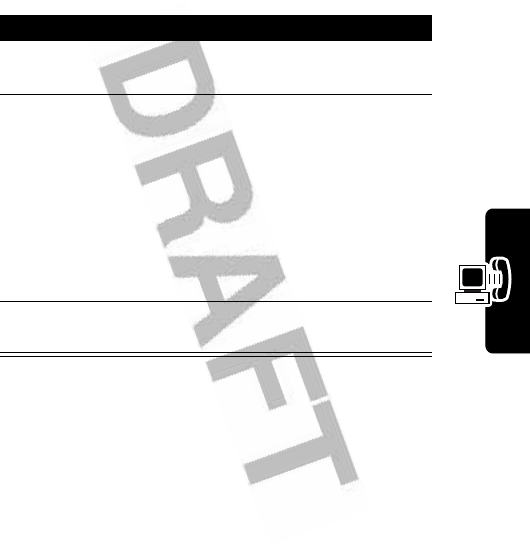
153
Getting More Out Of Your Phone
Sending a Data or Fax Call
Use this procedure to send data or a fax from a connected
computer or hand-held device using a CSD or GPRS
network connection.
Receiving a Data or Fax Call
Use this procedure to transfer data or a fax to a connected
computer or hand-held device.
Transferring the Data or Fax
Your phone notifies you when the data or fax call arrives,
and transfers the call to the connected device. Use the
application running on the device to answer the call.
Action
1
Make sure that the phone is connected and
powered on.
2
Open the application (such as dial-up-networking
or fax) on your computer, and place the call
through the application.
Note:
You cannot dial data or fax numbers
through your phone’s keypad. You must dial
them through your computer, unless you are
making a talk then fax call (see following
section).
3
When the transfer is complete, end the call from
the connected device to close the connection.
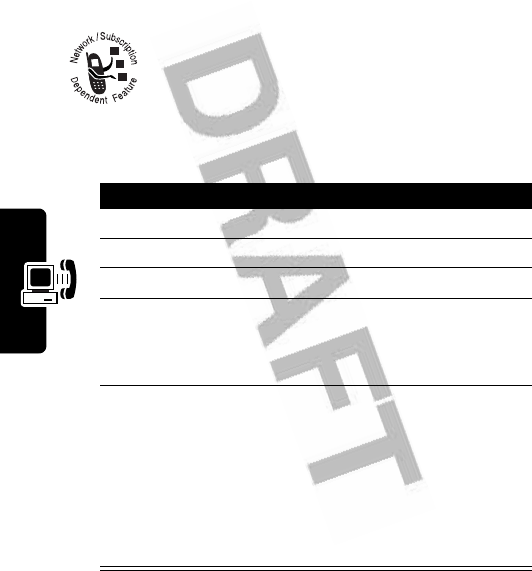
154
Getting More Out Of Your Phone
Ending the Data/Fax Connection
When the data or fax transfer is complete, end the call
from the connected device to close the connection.
Making a Talk Then Fax Call
You can place a call where you talk and then
send a fax to the same phone number within the
same call.
Connect to the device that will send the fax, and do the
following:
Press To
1
keypad keys enter the phone number
2
M
open the
Dialing Menu
3
S
scroll to
Talk Then Fax
4
SELECT
(
+
) select
Talk Then Fax
Your selection applies to the
next call only.
5
N
make the call
Speak and, when ready,
initiate the fax transfer on the
connected device. When the
transfer is complete, end the
call from the connected
device.
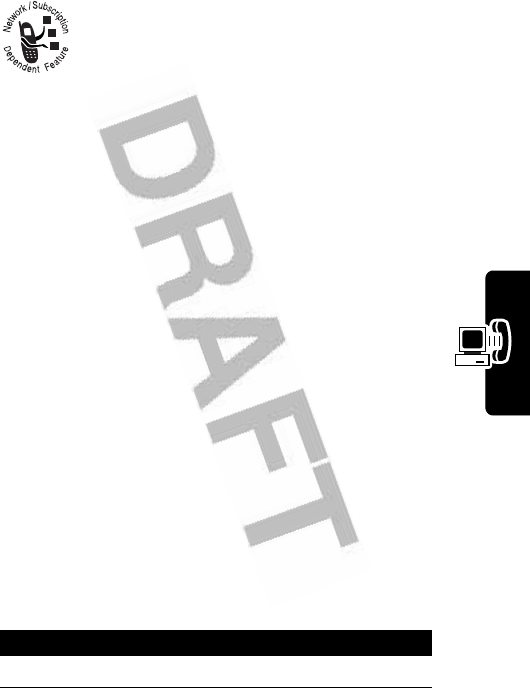
155
Getting More Out Of Your Phone
Adjusting Network Settings
Your service provider registers your phone to its
network. In some situations, such as using the
phone as a modem or connecting it to a TTY
device, you may need to change the network
registration.
Note:
Some settings and/or options described in this
section may not be available for all phone models.
Finding a New Network
You may decide to switch to another network to improve
the calling conditions, because of network coverage or
roaming conditions. To select a new network:
Your phone locates and registers on the strongest
network apart from the current network.
Listing All Networks
View a list of available networks, and register your phone
with a network.
Your phone displays a list of available networks.
Find the Feature
M
>
Settings
>
Network
>
New Network
Find the Feature
M
>
Settings
>
Network
>
Available Networks
Press To
1
S
scroll to the network you want
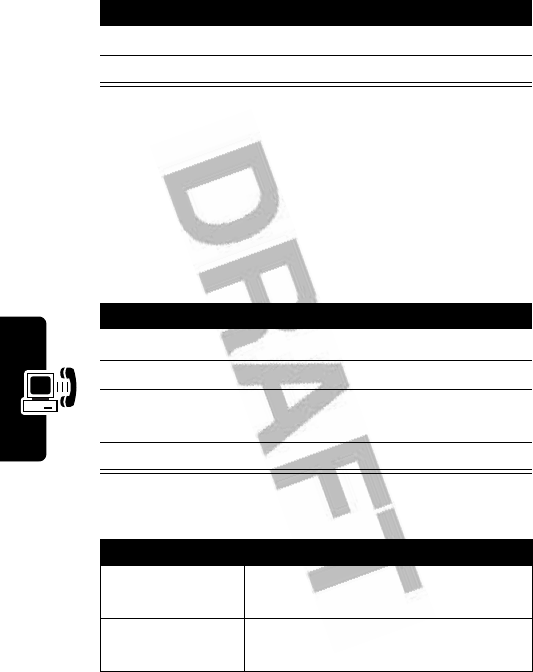
156
Getting More Out Of Your Phone
Changing Network Setup Values
Set how your phone searches for a network connection.
Note:
Actual field names and values may vary depending
on the technologies available to your service provider.
Network search
Type
options:
2
VIEW
(
+
) view network details
3
REGISTER
(
+
) register with the network
Find the Feature
M
>
Settings
>
Network
>
Network Setup
Press To
1
S
scroll to an item to change
2
CHANGE
(
+
) open the item’s list
3
S
scroll to an option described
in the following lists
4
SELECT
(
+
) select the option
Option Description
Automatic
Scan for networks automatically
based on priority.
Manual
View a list of all networks from
which you can choose.
Press To
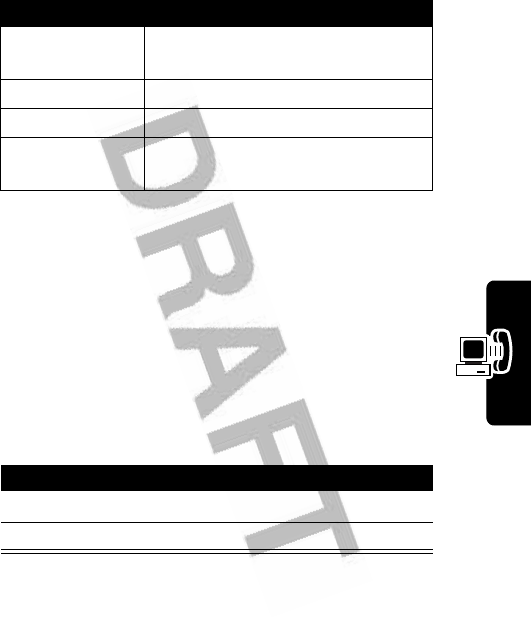
157
Getting More Out Of Your Phone
Network search
Speed
options:
Setting Preferred Networks
You can create a preferred networks list, so that the phone
searches for networks by your preference. The preferred
list normally is stored on your SIM card. Some service
providers may store network preferences on the phone.
Accessing the Preferred Network List
Your home network is always the first entry in the list, and
is identified by the
V
(home) icon. Other network entries
are sorted by preference.
Option Description
Slow
Slowest network search and
repeat rate.
Medium
Medium search/repeat.
Fast
Fast search/repeat.
Continuous
Continuous search until a network
is found.
Find the Feature
M
>
Settings
>
Network
>
My Network List
Press To
1
S
scroll to the network you want
2
SELECT
(
+
) view network details
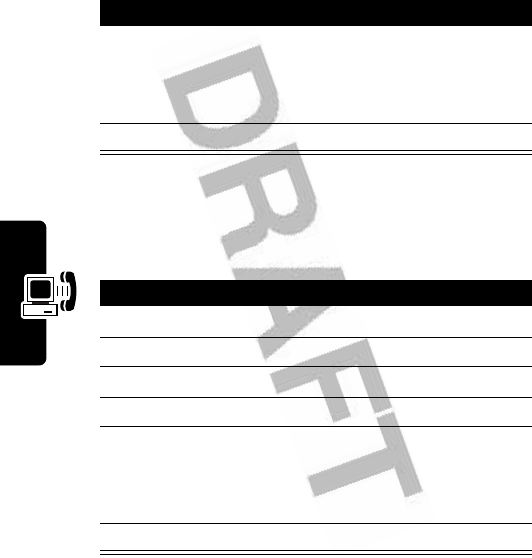
158
Getting More Out Of Your Phone
Adding an Entry to the Preferred Network List
Editing a Preferred Network List Entry
Deleting a Preferred Network List Entry
Find the Feature
M
>
Settings
>
Network
>
My Network List
>
Add
Press To
1
BROWSE
(
+
)
or
OK
(
+
)
browse available networks
enter the network ID number
2
OK
(
+
) confirm the new entry
Find the Feature
M
>
Settings
>
Network
>
My Network List
Press To
1
S
scroll to the entry
2
M
open the network menu
3
S
scroll to
Edit
4
SELECT
(
+
) select
Edit
5
DELETE
(
-
)
or
keypad keys
delete information
enter information
6
OK
(
+
) store the new information
Find the Feature
M
>
Settings
>
Network
>
My Network List
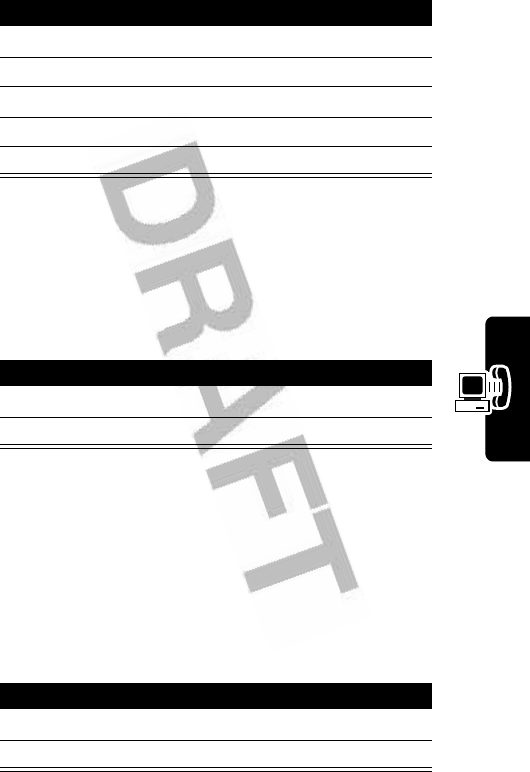
159
Getting More Out Of Your Phone
Adjusting Service Tones
You can set your phone to beep each time the network
registration status changes.
Setting the Call Drop Alert
You can set your phone to emit an alert tone whenever the
network drops a call. Because digital networks are so
quiet, the call drop alert may be your only indication that a
call has been dropped.
Press To
1
S
scroll to the entry
2
M
open the network menu
3
S
scroll to
Delete
4
SELECT
(
+
)select
Delete
5
YES
(
-
) confirm the deletion
Find the Feature
M
>
Settings
>
Network
>
Service Tone
Press To
1
S
scroll to
On
or
Off
2
SELECT
(
+
) select the option
Find the Feature
M
>
Settings
>
Network
>
Call Drop Tone
Press To
1
S
scroll to
On
or
Off
2
SELECT
(
+
) select the option

160
Getting More Out Of Your Phone
Monitoring Battery Charge
To view a detailed battery charge meter:
Find the Feature
M
>
Settings
>
Phone Status
>
Battery Meter

161
Personal Organizer
Personal Organizer
Datebook
The datebook is a calendar that you can use to schedule
and organize events such as appointments and meetings.
Note:
You must set the correct time and date to use the
datebook.
To schedule or review datebook events:
You can set the datebook to display a calendar for the
month or week. To change the default view, see page 167.
Month View
When default view is set to month, the datebook initially
displays a calendar for the month. An indicator in the lower
Find the Feature
M
>
Datebook
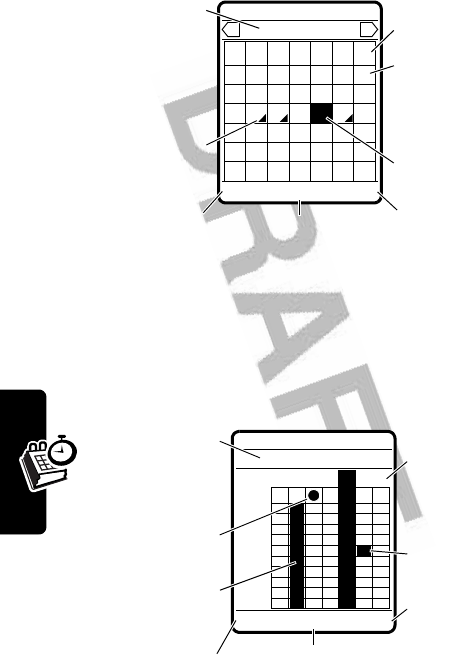
162
Personal Organizer
right corner of the date box indicates that 1 or more events
are scheduled for the day.
Week View
When default view is set to week, the datebook initially
displays a calendar for the week. Filled boxes indicate
scheduled events.
EXIT
M
WEEK
October 2003
SS
F
T
TW
M
1234
567891011
12 13 14 15 16 17 18
19 20 21 22 23 24 25
26 27 28 29 30 31
*
#
(yÉ
Go to week
view
Dates of the
Month (press
S
to scroll to
and select day)
Scheduled
Events Indicator
Exit datebook.
Selected Day
Month (press
*
or
#
to
select previous
month or next
month)
Press
M
to open
Datebook Menu
.
Days of the
Week
EXIT
M
DAY
12 OCT - 18 OCT ‘03
*
#
7:00
9:00
11:00
13:00
15:00
SS
F
T
TW
M
(yÉ
Go to month
view
1-Hour Event
Days of the
Week (press
S
to scroll to
and select day)
Full Day
(12-Hour) Event
Exit datebook.
Untimed Event
Week (press
S
up or down
to select)
Press
M
to open
Datebook Menu
.
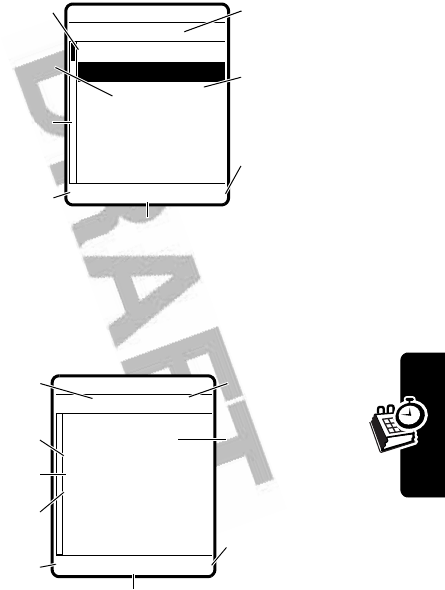
163
Personal Organizer
Day View
Scroll to a day and press the center select key (
S
) to see
the day’s events.
Event View
Select an event and press
VIEW
(
+
) to see event details.
BACK
M
VIEW
THU 20-NOV
•Joe's Birthday
8:00
A
Marie, meeti...
9:00
A
Jim meeting
9:30
A
conference c...
11:00
A
status report
12:00
A
Jane lunch
14:00
A
presentation
(yÉ
Show event
details.
Scroll down for
more events.
Reminder Alarm Events
Day of WeekUntimed Event
Return to
previous
screen. Press
M
to open
Datebook Menu
.
BACK
M
EDIT
A
THU 8:00am
Marie, meeting for
status reports
(1 hrs)
A
10 min before
None
(yÉ
Edit event.
Reminder Alarm
Duration Event Details
Return to
previous
screen.
Repeat Interval
Day & Time
Alarm Time
Press
M
to open
Datebook Menu
.
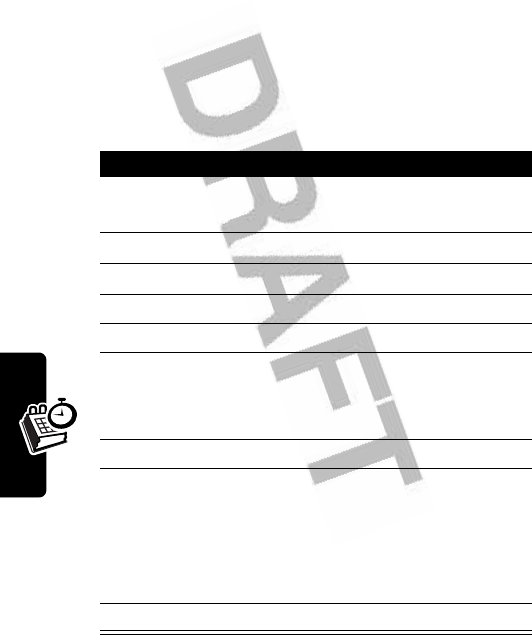
164
Personal Organizer
Creating a Datebook Event
A title is required for a datebook event. All other
information is optional.
Notes:
•
You must create an event to use the reminder alarm.
•
Your phone must be turned on for the reminder alarm
to sound.
Find the Feature
M
>
Datebook
Press To
1
S
left, right, up,
or down
scroll to a day
2
S
center select a day
3
S
scroll to
New
4
SELECT
(
+
) create a new event
5
CHANGE
(
+
) select
Title
6
keypad keys enter a title for the event
Tip:
Press
M
to select a text
entry method (see page 46).
7
OK
(
+
) store the event title
8
S
scroll to other fields and enter
information as necessary
You can set start time,
duration, date, repeat
interval, and reminder alarm.
9
DONE
(
-
) store the event
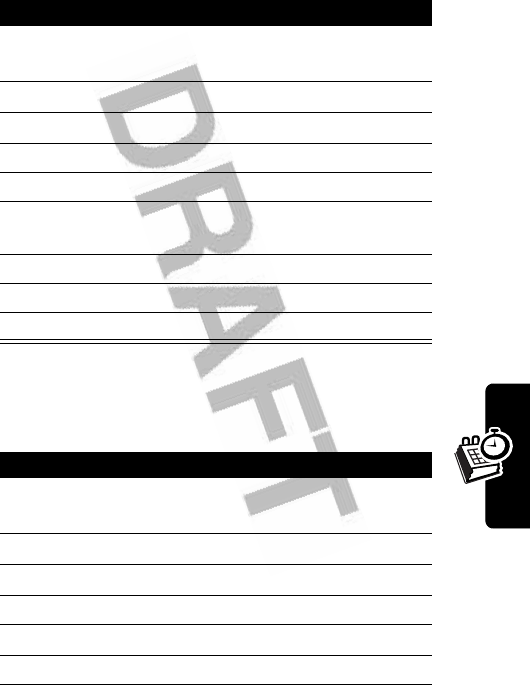
165
Personal Organizer
Changing Event Information
Copying an Event
Find the Feature
M
>
Datebook
Press To
1
S
left, right, up,
or down
scroll to a day
2
S
center select a day
3
S
scroll to the event
4
VIEW
(
+
) display the event view
5
EDIT
(
+
) edit the event
6
S
scroll to the information you
want to change
7
CHANGE
(
+
) edit the information
8
keypad keys enter new information
9
DONE
(
-
) store the information
Find the Feature
M
>
Datebook
Press To
1
S
left, right, up,
or down
scroll to a day
2
S
center select a day
3
S
scroll to the event
4
M
open the
Datebook Menu
5
S
scroll to
Copy
6
SELECT
(
+
) copy the event
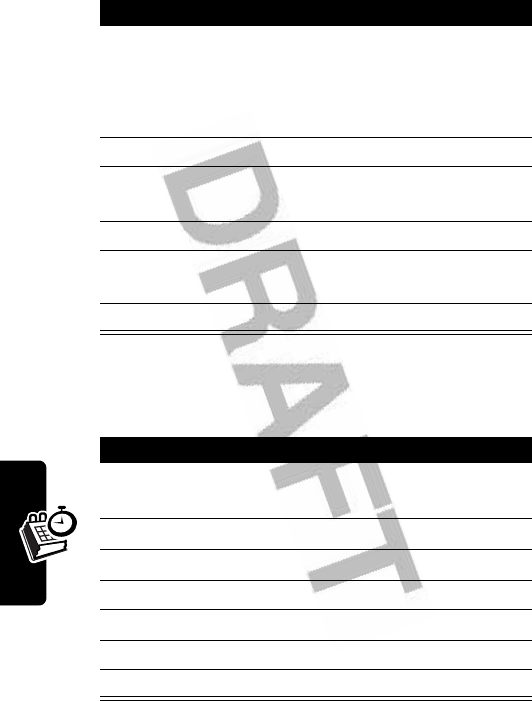
166
Personal Organizer
Deleting an Event
7
YES
(
-
) confirm the copy
Your phone assumes that
you want to change the date,
and displays the
Date
field.
8
keypad keys enter the date information
9
}
(
+
) or
S
to
the right
move to month, day, and year
10
DONE
(
-
) save the copy of the event
11
S
scroll to and edit event
information, if necessary
12
DONE
(
-
) store the information
Find the Feature
M
>
Datebook
Press To
1
S
left, right, up,
or down
scroll to a day
2
S
center select a day
3
S
scroll to the event
4
M
open the
Datebook Menu
5
S
scroll to
Delete
6
SELECT
(
+
) select
Delete
7
YES
(
-
) confirm the deletion
Press To
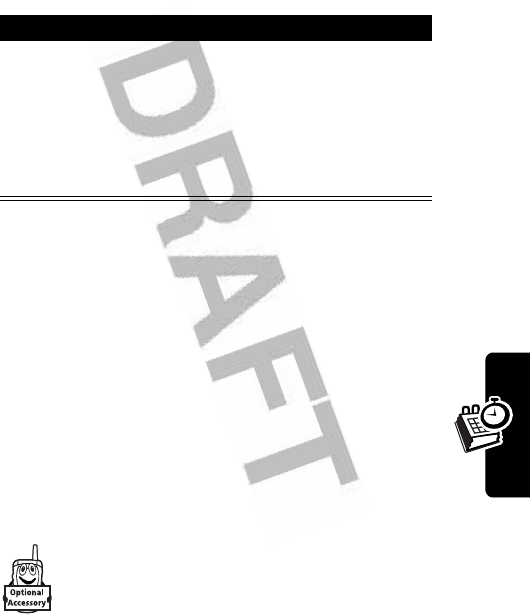
167
Personal Organizer
Viewing and Dismissing an Event Reminder
When you set a reminder alarm for an event, the phone
displays an event reminder and sounds a reminder alarm.
To view or dismiss an event reminder:
If you have more than 1 event set up for the same time, the
phone displays each event in sequence. As you view and
dismiss each event reminder, the next event is displayed.
Changing the Datebook Setup
You can set the datebook’s default view to month or week,
change the daily start time, and set the length of time
that events are stored.
Synchronizing Datebook Entries
You can synchronize datebook entries between
your phone and computer or hand-held device
with BVRP Mobile PhoneTools software, included
with your phone. See the Mobile PhoneTools
user’s guide for more information.
Press To
VIEW
(
+
)
or
EXIT
(
-
)
view the event
Press
S
to scroll through
the event details.
dismiss the reminder
Find the Feature
M
>
Datebook
M
>
Setup
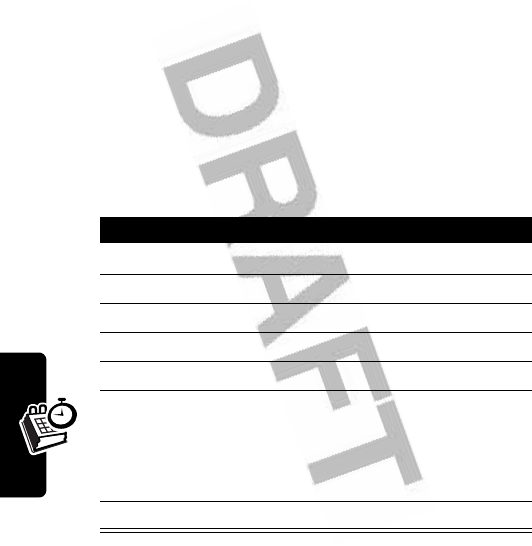
168
Personal Organizer
Note:
Mobile PhoneTools software is designed to
synchronize with basic features of many popular Personal
Information Management (PIM) software and hardware
products.
Alarm Clock
Your phone has an alarm clock with 5 separate alarms that
you can set and use when the phone is powered on. Each
alarm can be configured with a name, time, and alert tone.
Setting an Alarm
Find the Feature
M
>
Office Tools
>
Alarm Clock
Press To
1
S
scroll to
[New Alarm]
2
SELECT
(
+
) select the option
3
CHANGE
(
+
) select
Name
4
keypad keys enter a name for the alarm
5
OK
(
+
) store the name
6
S
scroll to other fields and enter
information as necessary
You must set start time, alert
tone, and alarm volume.
7
DONE
(
-
) store the alarm
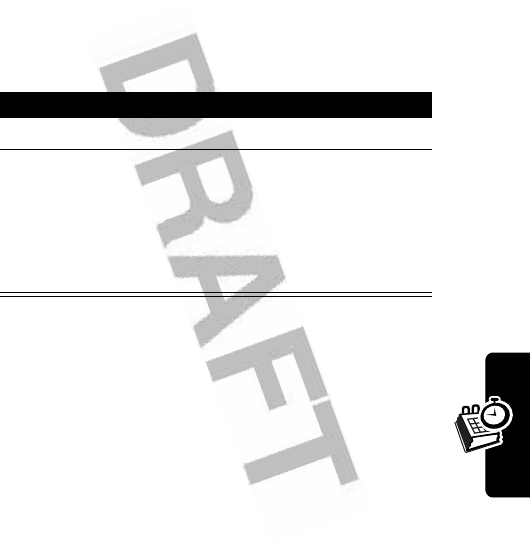
169
Personal Organizer
Enabling/Disabling an Alarm
Alarms that you set are listed by name on the
Alarm Clock
menu. An active alarm is identified by an
ã
(alarm)
indicator.
To enable or disable an alarm:
Turning Off an Alarm
When an alarm sounds, your phone displays the alarm
name, time, and date.
Find the Feature
M
>
Office Tools
>
Alarm Clock
Press To
1
S
scroll to the alarm
2
ENABLE
(
+
)
or
DISABLE
(
+
)
enable a highlighted
(disabled) alarm
disable a highlighted
(enabled) alarm
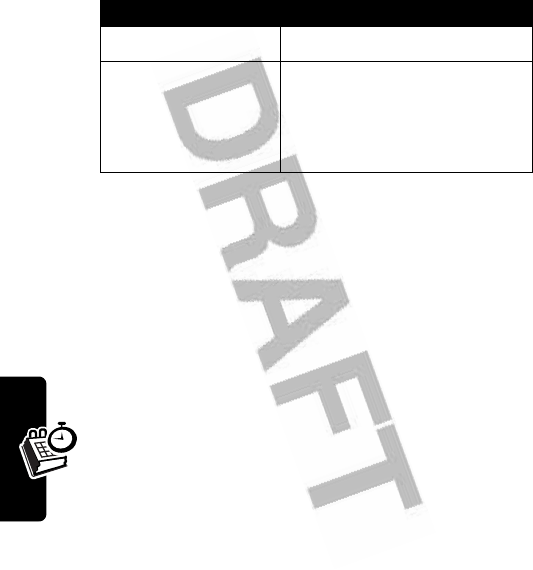
170
Personal Organizer
The alarm rings for 3 minutes, then snoozes for 8 minutes.
The alarm repeats this cycle for up to 90 minutes, or until
you perform 1 of the following procedures.
Voice Records
You can record personal messages and phone calls on
your phone.
Making a Recording
Use this procedure to create a voice record from the home
screen, or to record a phone call in progress. Your phone
plays an alert tone to notify the other party that the call
is being recorded.
Note:
Recording phone calls is subject to varying state
and federal laws regarding privacy and recording of
conversations.
Press To
DISABLE
(
-
) or
O
turn off the alarm
SNOOZE
(
+
) turn off the alarm for 8
minutes
The alarm is reactivated at
the end of 8 minutes.
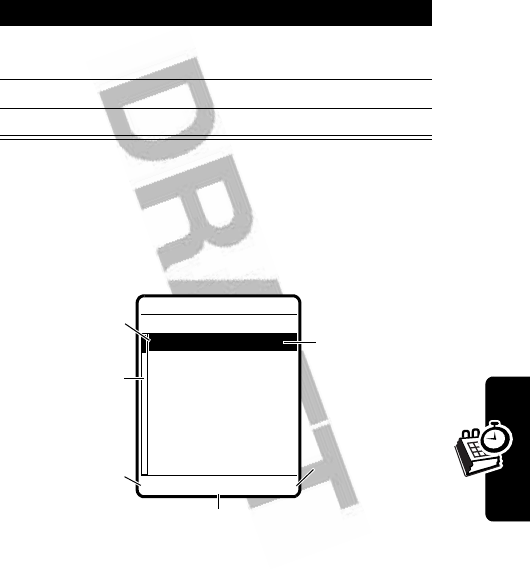
171
Personal Organizer
Tip:
Make your recording in a quiet location. Hold the
phone about 4 inches (10 centimeters) from your mouth,
and speak directly into the phone in a normal tone.
Viewing the Voice Records List
Playing a Recording
Action
1
Press and hold the voice key. The phone sounds
an alert tone and begins recording.
2
Speak into the phone.
3
Release the voice key to stop recording.
Find the Feature
M
>
Office Tools
>
Voice Records
Find the Feature
M
>
Office Tools
>
Voice Records
EXIT
M
PLAY
Voice Records
f
10) 2:20pm 10/15/03
9) 4:05pm 10/10/03
8) 4:00pm 10/10/03
7) 11:05am 10/10/03
6) 9:00am 10/10/03
5) 7:15pm 10/09/03
4) 12:22pm 10/06/03
(yÉ
Scroll down for
more
recordings.
Locked
Recording
Return to
previous
screen. Press
M
to open
Voice Records Menu
.
Play highlighted
recording.
Time/Date
Recorded
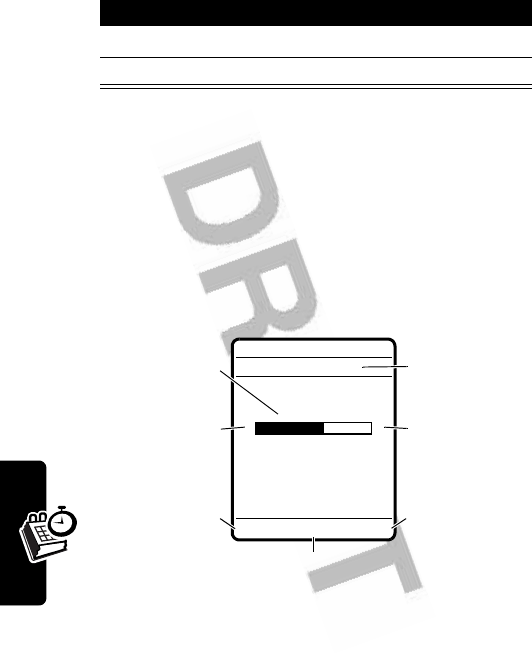
172
Personal Organizer
When you connect an optional Motorola Original™
headset or FM Stereo Radio Headset accessory to your
phone, playback is automatically routed to the headset.
Tip:
You can play a recording while taking a call. It will not
be transmitted to the other party.
Playback Screen
The playback screen is displayed as the recording plays.
Press To
1
S
scroll to the recording
2
PLAY
(
+
) play the recording
SAVE
M
DELETE
Voice Record 3
{}
(yÉ
Indicates %
played.
Return to
previous
screen.
Recording
Number
Press
S
right
to fast forward.
Erase
recording.
Press
M
to open
Voice Records Menu
.
Press
S
left to
rewind.
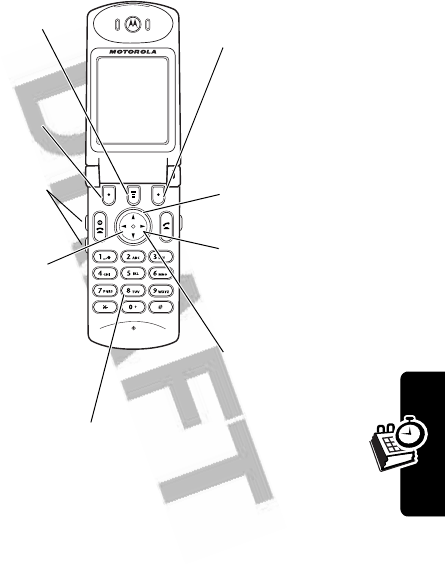
173
Personal Organizer
Voice Record Controls
Locking and Unlocking a Recording
Lock a recording to prevent it from being deleted. You must
unlock a recording to delete it.
Find the Feature
M
>
Office Tools
>
Voice Records
Raise or lower
playback
volume.
Press
up/down
to stop playback
& scroll to next
voice record.
Press
left
to
rewind 3
seconds. Press
left and hold
to
rewind to
beginning.
Press
right
to
fast forward 3
seconds. Press
right and hold
to
fast forward to
end.
When playback
is complete,
press
right
to
restart.
Press any number key to alternately
stop/start playback.
Stop playback &
go to
Voice
Records Menu
.
Stop playback &
return to voice
record list.
Stop playback,
view options to
unlock or delete
voice record.
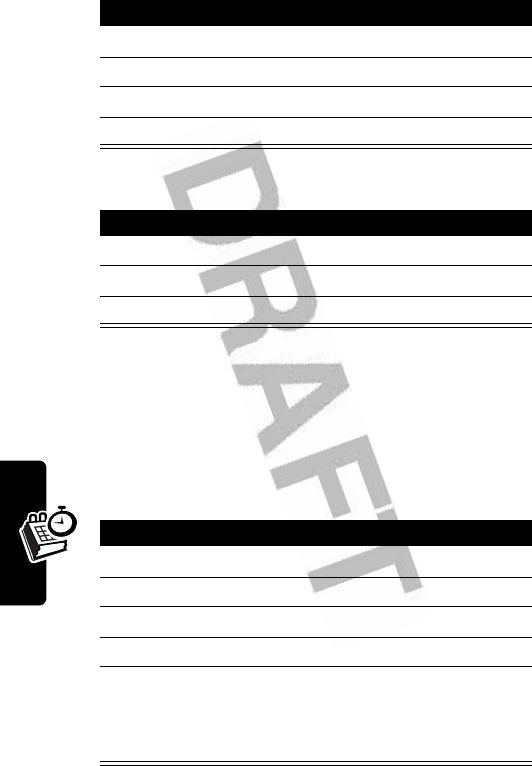
174
Personal Organizer
To lock or unlock a recording during playback:
Playback stops when you lock or unlock a recording. Press
any number key to resume playback.
Deleting a Recording
Press To
1
S
scroll to the recording
2
M
open the
Voice Records Menu
3
S
scroll to
Lock
or
Unlock
4
SELECT
(
+
) lock or unlock the recording
Press To
1
M
open the
Voice Records Menu
2
S
scroll to
Lock
or
Unlock
3
SELECT
(
+
) lock or unlock the recording
Find the Feature
M
>
Office Tools
>
Voice Records
Press To
1
S
scroll to the recording
2
M
open the
Voice Records Menu
3
S
scroll to
Delete
or
Delete All
4
SELECT
(
+
) select the highlighted option
5
YES
(
-
)
or
NO
(
+
)
confirm the deletion
cancel deletion
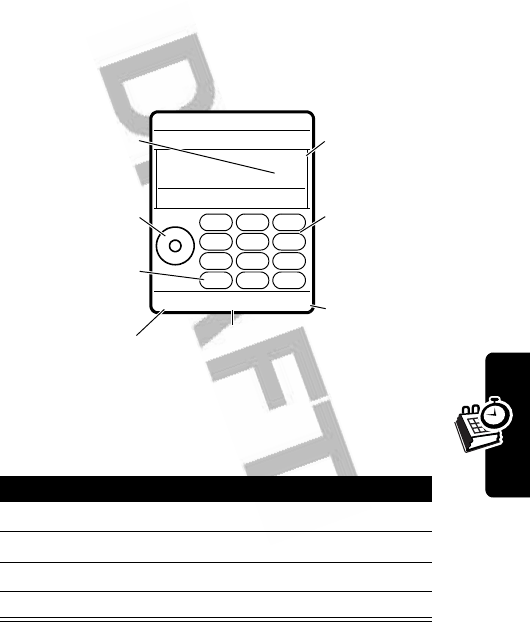
175
Personal Organizer
Notes:
•
You cannot delete a locked recording.
•
You cannot recover a deleted recording.
Calculator
You can use your phone as a calculator and currency
converter.
Calculating Numbers
Find the Feature
M
>
Office Tools
>
Calculator
Press To
1
number keys enter a number
2
S
select a calculator function
3
number keys enter next number
4
=
(
+
) calculate the result
EXIT
M
=
Calculator
35
20
55
1
4
7
ce
2
5
8
0
3
6
9
.
+
_
÷
×
+
(yÉ
Selected
Function
Use keypad to
enter number or
insert decimal
point.
Press
M
to open
Calculator Menu
.
Exit calculator.
Entered
Numbers
Press
S
to
select function.
Calculate the
result.
Press
ce
to clear
last entry.
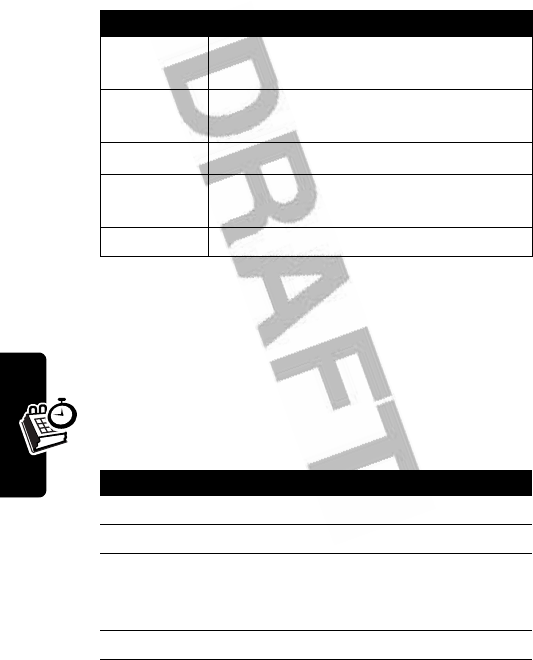
176
Personal Organizer
Press
c
to clear the calculation. Press
ce
(clear entry) to
clear the last entry when performing a calculation.
Press
M
to open the
Calculator Menu
to perform the following
functions:
Converting Currency
The currency converter works just like the calculator, but
converts a currency value based on the exchange rate you
specify:
Function Description
+/-
Change the entry’s sign
(positive/negative)
.
MS
Store the value in memory (overwrites
values already stored)
.
MC
Clear the value stored in memory
.
MR
Replace the displayed value with the
value stored in memory
.
%
Divide the displayed value by 100
.
Find the Feature
M
>
Office Tools
>
Calculator
M
>
Exchange Rate
Press To
1
number keys enter the exchange rate
2
OK
(
+
) store the exchange rate
3
number keys enter the amount to convert
(amount to multiply by the
exchange rate)
4
M
open the
Calculator Menu

177
Personal Organizer
5
S
scroll to
Convert Currency
6
SELECT
(
+
) perform the conversion
Press To
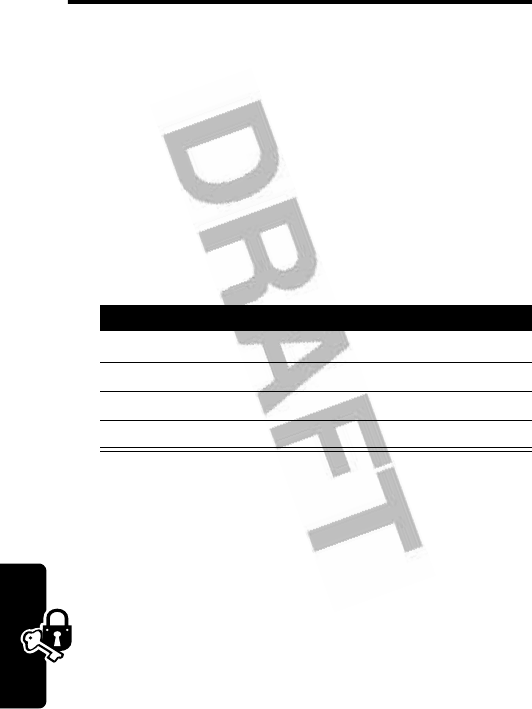
178
Security
Security
Locking the SIM Card
Yo u r Personal Identification Number (PIN) code protects
the information stored on your SIM card. When the SIM
card is locked, you must enter your SIM card PIN code to
unlock the SIM card each time you turn on the phone or
insert the SIM card in the phone. Your SIM card PIN code
is given to you by your service provider.
Unblock the SIM Card PIN Code
If you enter an incorrect SIM card PIN code 3 times in a
row, your SIM card is disabled and your phone displays
SIM Blocked
. You must enter a PIN unblocking key (PUK)
code, which you can obtain from your service provider.
Find the Feature
M
>
Settings
>
Security
>
SIM PIN
Press To
1
S
scroll to
On
or
Off
2
SELECT
(
+
) switch SIM PIN lock on or off
3
keypad keys enter your SIM card PIN code
4
OK
(
+
) submit your code
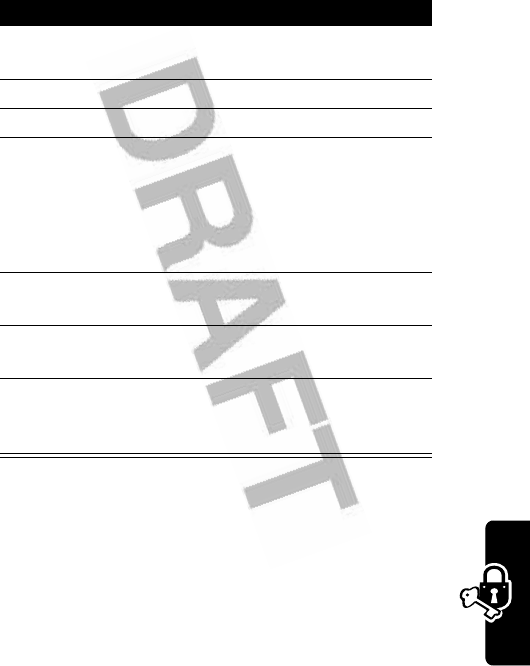
179
Security
Caution:
If the unblocking attempt is tried unsuccessfully
10 times, the SIM card is permanently disabled and your
phone displays
SIM Disabled
.
Unblock the SIM Card PIN2 Code
If you enter an incorrect SIM card PIN2 code 3 times in a
row, your phone’s SIM PIN2 protected features are
disabled and your phone displays
SIM Blocked
when you
try to use a PIN2 feature. You must enter a PIN2
Press To
1
*
*
0
5
*
open the PIN
unblocking editor
2
keypad keys enter the PUK code
3
OK
(
+
) submit the PUK code
4
keypad keys enter a new SIM card
PIN code
Note:
The SIM PIN
code must be between
4 and 8 digits in length.
5
OK
(
+
) assign the new SIM PIN
code
6
keypad keys re-enter the new SIM
PIN code
7
OK
(
+
) confirm the new SIM
PIN code and unblock
the SIM card
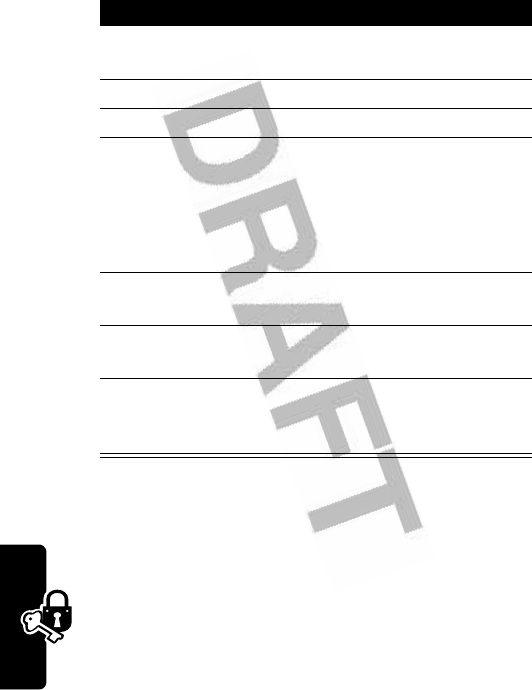
180
Security
unblocking key (PUK2) code, which you can obtain from
your service provider.
Locking and Unlocking
Applications
You can lock specific phone applications (such as the
phonebook) so that users must enter the unlock code
to use them.
Press To
1
*
*
0
5
2
*
open the PIN2
unblocking editor
2
keypad keys enter the PUK2 code
3
OK
(
+
) submit the PUK2 code
4
keypad keys enter a new SIM card
PIN2 code
Note:
The SIM PIN2
code must be between
4 and 8 digits in length.
5
OK
(
+
) assign the new SIM
PIN2 code
6
keypad keys re-enter the new SIM
PIN2 code
7
OK
(
+
) confirm the new SIM
PIN2 code and unblock
PIN2 features
Find the Feature
M
>
Settings
>
Security
>
Lock Application
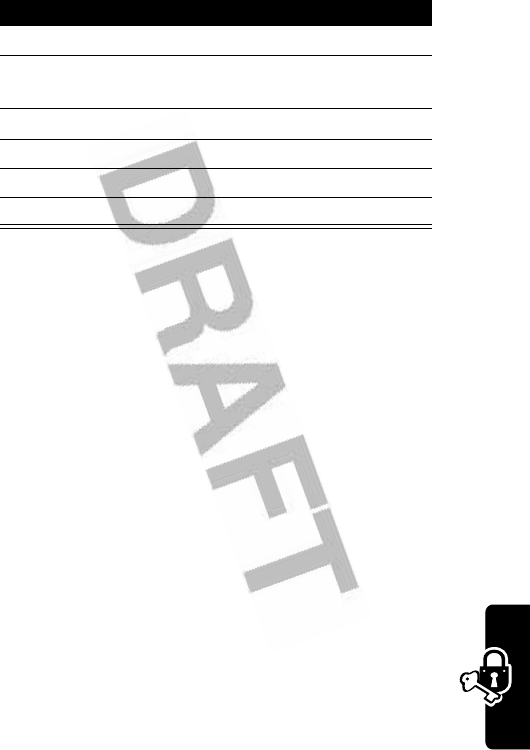
181
Security
Press To
1
keypad keys enter your unlock code
2
OK
(
+
) open the lock application
menu
3
S
scroll to the application
4
CHANGE
(
+
) select the application
5
S
scroll to
Locked
or
Unlocked
6
SELECT
(
+
)select
Locked
or
Unlocked

182
News and Entertainment
News and
Entertainment
mMode
mMode lets you access Web pages and
Web-based applications on your phone. Contact
your service provider to set up access, if
necessary.
Note:
Your phone may use a high-speed General Packet
Radio Service (GPRS) network connection. This type of
connection is identified by a
+
(GPRS) indicator in the
home screen that disappears when you start an mMode
session. If you see an
?
(in-call) indicator during an
mMode session, your phone is using a standard voice
channel connection. The type of network connection your
phone uses depends on your service provider’s network.
Your network connection charges may vary depending on
the type of connection used.
Starting an mMode Session
Find the Feature
M
>
Web Access
>
mMode
Press To
1
S
scroll to a bookmark, service,
or application
2
SELECT
(
+
) select the item
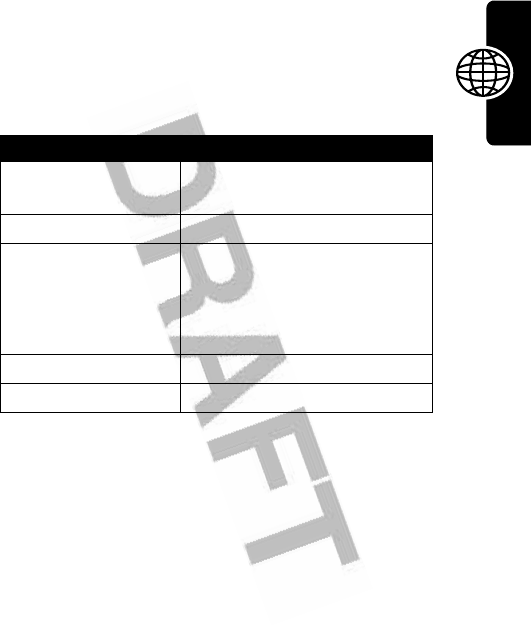
183
News and Entertainment
Shortcut:
Press mMode (
+
) in the home screen to start
an mMode session.
If you are unable to establish a network connection with
mMode, contact your service provider.
Interacting With Web Pages
Downloading Objects From a Web Page
You can download a photo, picture, animation, sound, or
phone theme from a Web page be selecting its link. You
can store these media objects on your phone, and use
them as wallpaper images, screen saver images, and
event alerts.
Press To
S
scroll through text, or
highlight a selectable item
SELECT
(
+
) select the highlighted item
keypad keys,
followed by
OK
(
+
)
enter information
Tip:
Press
DELETE
(
-
) to delete
1 letter at a time if you make
a mistake.
BACK
(
-
) go back to the previous page
M
open the menu
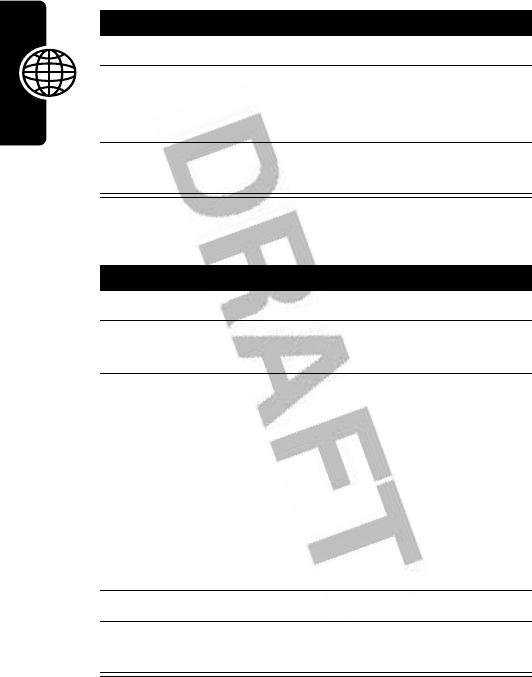
184
News and Entertainment
Storing a Picture File
Storing a Sound File
Press To
1
STORE
(
+
) view storage options
2
S
scroll to
Store Only
,
Apply as Wallpaper
or
Apply as Screen Saver
3
SELECT
(
+
) perform the storage option of
your choice
Press To
1
STORE
(
+
) view storage options
2
S
scroll to
Store Only
or
Set As Ring Tone
3
SELECT
(
+
) select the option
If you select
Store Only
, the
procedure is complete.
If you select
Set As Ring Tone
,
your phone displays
Set As Which?
, and lists the
events for which you can set
an alert.
4
S
scroll to the event
5
SELECT
(
+
) store the sound and set it as
the event alert
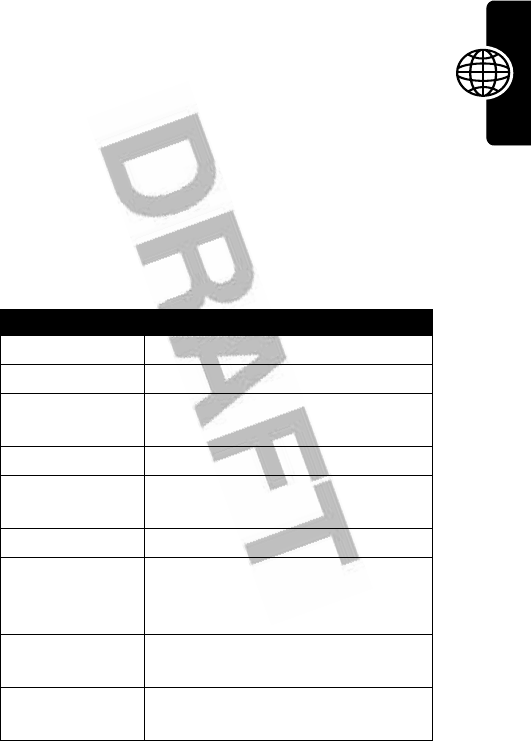
185
News and Entertainment
Selecting or Creating a Web Session
Use this feature to select or create a Web session, or
network connection profile. You can use different Web
sessions to connect to the Internet in different ways.
To create a Web session, you must configure the following
settings. Contact your service provider to obtain the
following information, if necessary. Actual field names and
values may vary depending on the technologies available
to your service provider. Some settings may not be
available for all phone models.
Find the Feature
M
>
Web Access
>
Web Sessions
Option Description
Name
Enter the Web session name.
Homepage
Specify the default home page.
WAPIP1
Primary WAP gateway IP
address.
WAP Port 1
Primary WAP port number.
WAPIP2
Secondary WAP gateway IP
address.
WAP Port 2
Secondary WAP port number.
Timeout
Time at which the phone exits
mMode when no keypress activity
is detected.
CSD No. 1
Primary phone number to use to
set up a CSD connection.
User Name 1
User name for primary CSD
number.
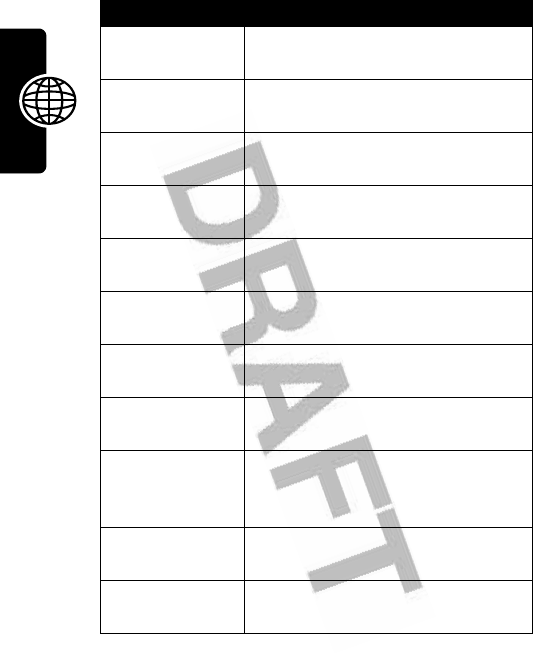
186
News and Entertainment
Phone Themes
A phone theme consists of a bundled set of image and
sound files with a specific theme (such as a special event
or cartoon character) that you can apply collectively to
Password 1
Password for primary CSD
number.
Speed (Bps) 1
Connection speed for primary
CSD number.
Line Type 1
Line type (modem or ISDN) for
primary CSD number.
CSD No. 2
Secondary CSD dial-up phone
number.
User Name 2
User name for secondary CSD
number.
Password 2
Password for secondary CSD
number.
Speed (Bps) 2
Connection speed for secondary
CSD number.
Line Type 2
Line type (modem or ISDN) for
secondary CSD number.
GPRS APN
GPRS access point name (the
name of the WAP service
provider).
User Name
User name for GPRS APN
connection.
Password
Password for GPRS APN
connection.
Option Description

187
News and Entertainment
your phone. Phone themes typically include a wallpaper
image, screen saver image, and ring tone. Your phone
includes several preloaded themes. You can download
and install additional themes on your phone.
Downloading Themes
To download a theme from mMode, see page 183. When
you install the theme, you can instantly apply its screen
saver, wallpaper, and ring tone when your phone prompts
you to
Apply Theme Now?
Selecting Themes
You can apply any of the themes installed on your phone.
Note:
If 1 of a theme’s components is not available, then a
default setting is applied.
Deleting Themes
You cannot delete the preloaded themes on
your phone. To delete 1 or all of the themes that
you have downloaded and installed:
Find the Feature
M
>
Multimedia
>
Themes
>theme
Find the Feature
M
>
Multimedia
>
Themes
>theme
Press To
1
M
open the
Theme
menu
2
S
scroll to
Delete
or
Delete All
3
SELECT
(
+
) select the option
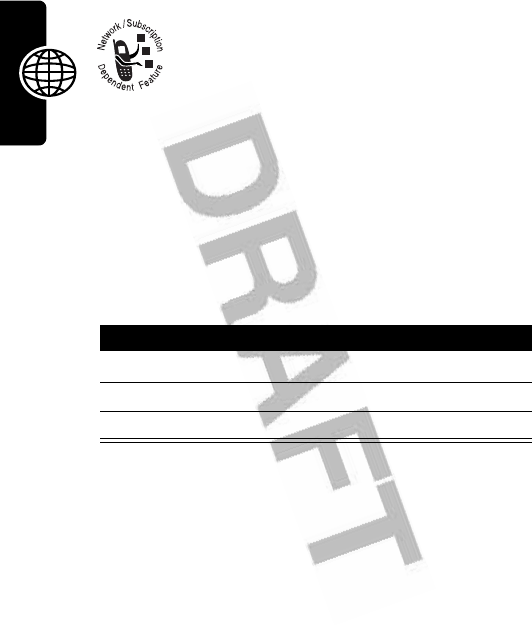
188
News and Entertainment
Games and Applications
Your phone contains Java games that you
can play between calls. Each game includes
online playing instructions.
Your phone may contain additional Java
applications that add features and functionality to your
phone. Java games and applications are stored in the
Games & Apps
folder on your phone.
Downloading an Application With mMode
Go to the page that contains the application, then:
Note:
If you do not have enough phone memory to
download a Java application, you can free memory space
by deleting unused Java applications.
Launching a Java Application
Find the Feature
M
>
Web Access
>
mMode
Press To
1
S
scroll to the application
2
SELECT
(
+
) view the application details
3
DWNLOAD
(
+
) download the application
Find the Feature
M
>
Games & Apps
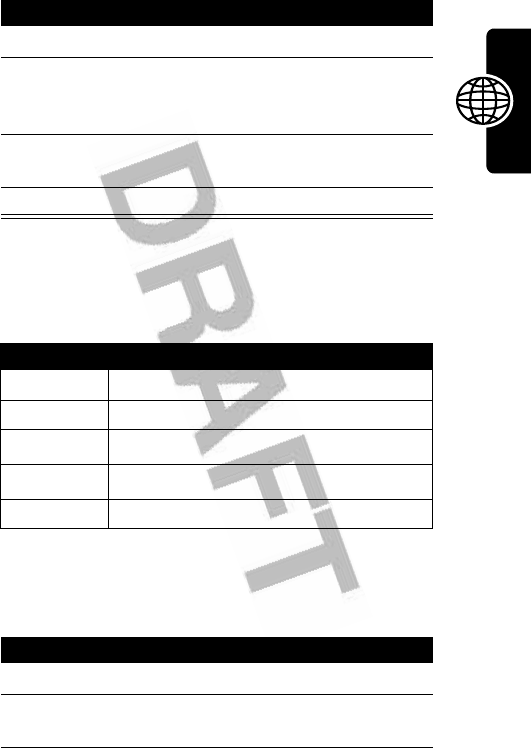
189
News and Entertainment
Using Control Keys
Your phone’s keys perform the following functions in a Java
application.
Analyzing or Deleting a Java Application
Press To
1
S
scroll to the application
2
SELECT
(
+
) launch the application, or
open the list of applications in
a suite
3
S
scroll to the application you
want, if necessary
4
SELECT
(
+
) launch the application
Key Function
S
Move up, down, left, or right in a game.
5
“Fire” your weapon in a game.
O
End the application.
N
Call a number in the application.
M
Open the Java applications menu.
Find the Feature
M
>
Games & Apps
Press To
1
S
scroll to the application
2
M
open the application manager
menu
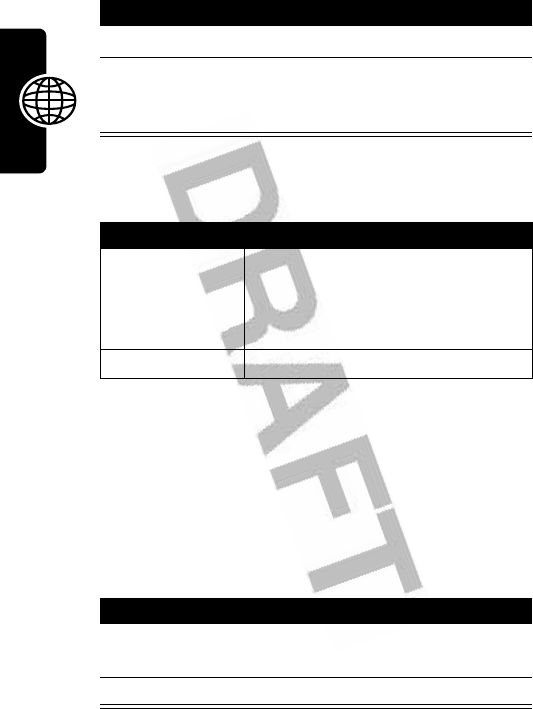
190
News and Entertainment
The application manager menu can include the following
options:
Viewing Java Version and Available
Memory
To view Java version information, or the amount of phone
memory available for Java applications:
3
S
scroll to a menu option
4
SELECT
(
+
) select the option to perform
procedures as described in
the following list
Option Description
View Details
Display the suite name, vendor,
version, number of apps, flash
usage, and memory
requirements.
Delete
Delete the suite.
Find the Feature
M
>
Settings
>
Java Settings
>
Java System
Press To
1
S
scroll through information as
described in the following list
2
OK
(
+
) close the display
Press To
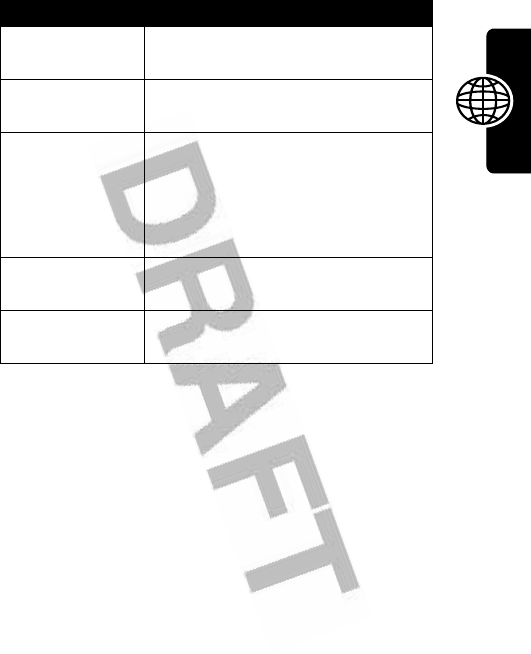
191
News and Entertainment
Note:
If you do not have enough phone memory to
download a Java application, you can free memory space
by deleting unused Java applications.
Editing Sounds with MotoMixer
MotoMixer lets you edit and save special MIDI-based
sound files called Groove Tunes on your phone. These
sound files are made up of 4 instruments such as
piano
,
bass
,
drums
, and
guitar
. The phone comes preloaded
with base tracks (which you cannot edit or delete), but you
can download others and use them all to create or edit
your own mix files. The mix files you create display in the
list of available alerts.
Note:
To download new MotoMixer files, see page 183.
Option Displays
CLDC Version
Your phone’s connected limited
device configuration version.
MIDP Version
Your phone’s mobile information
device profile version.
Data Space
(both Java and
non-Java data
space)
Memory available for application
data (such as game scores or
application settings), and for
downloaded graphics, ring tones,
all photos and MMS messages.
Program Space
Memory available for Java
applications.
Heap Size
Amount of runtime memory
available for Java applications.
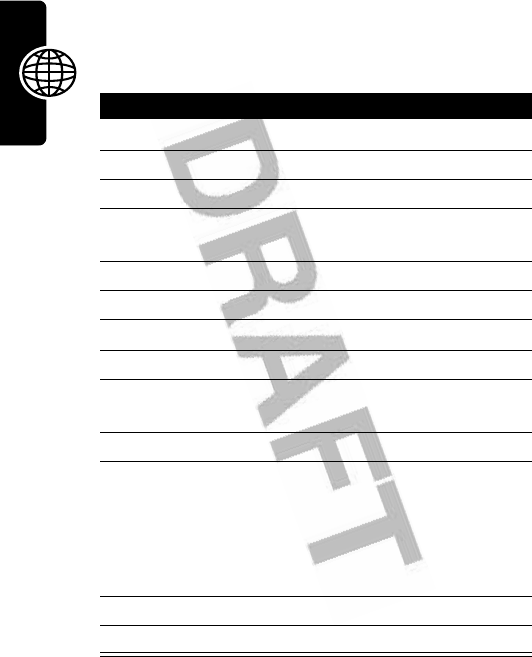
192
News and Entertainment
Creating or Editing a Mix File
Find the Feature
M
>
Multimedia
>
MotoMixer
>
[New MotoMixer]
or
mix file name
Press To
1
S
scroll to the base track
2
SELECT
(
+
) select the base track
3
CHANGE
(
+
) select
Name
4
keypad keys enter a name for the mix file
you are creating
5
OK
(
+
) store the name
6
CHANGE
(
+
) select
Tempo
7
S
left or right adjust the tempo setting
8
OK
(
+
) store the tempo setting
9
CHANGE
(
+
) select
Mix
to open the mix
editor
10
PLAY
(
+
) start playing/mixing the track
11
keypad keys edit the instruments (see
following section)
The track plays to the end
and stops. To edit your mix,
press
PLAY
(
+
) again.
12
BACK
(
-
) close the base track editor
13
DONE
(
-
) close the mix file display
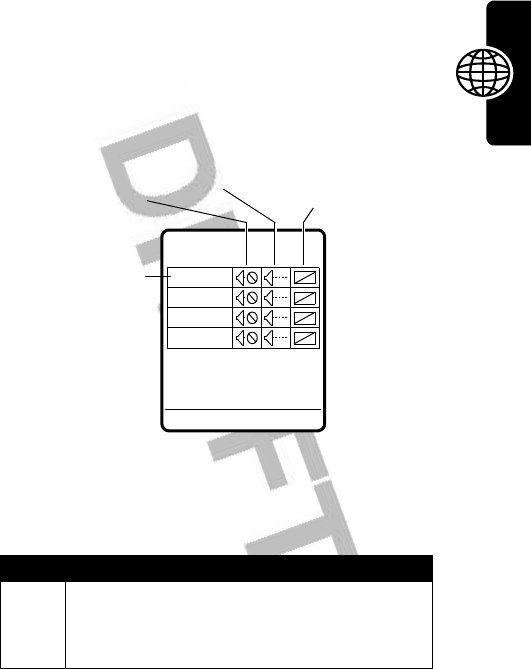
193
News and Entertainment
MotoMixer Editing Controls
You can select which instruments you want to play and
when you want to play them. The mix editor shows the
current settings for each instrument (see following table
for details).
Press
PLAY
(
+
) to play the mix file. Turn instruments on or
off, add effects, and/or set an instrument variant using the
following keypad keys:
Key Effect
1
Turn on/off
first
instrument (
Piano
above)
2
Add effect to first instrument
3
Set variant for first instrument
BACK
M
PLAY
Piano
Bass
Drums
Guitar
Second column
keypad keys add
effects.
Instrument Name
Press first column
keypad keys (
1
,
4
,
7
,
*
) to
turn instruments
on/off.
Third column
keypad keys
set instrument
variant.
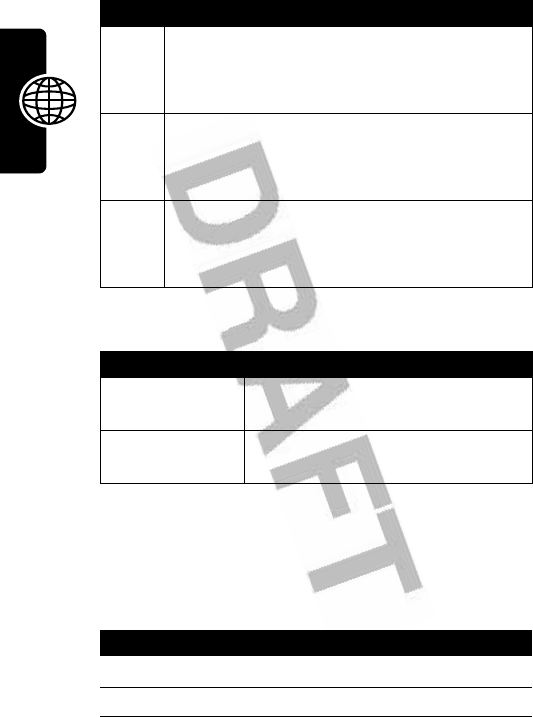
194
News and Entertainment
Use the following keys to perform additional mix functions:
Using, Editing, or Deleting a Mix File
To edit or delete a mix file, or set a mix file as a ring tone:
4
Turn on/off
second
instrument (
Bass
above)
5
Add effect to second instrument
6
Set variant for second instrument
7
Turn on/off
third
instrument (
Drums
above)
8
Add effect to third instrument
9
Set variant for third instrument
*
Turn on/off
fourth
instrument (
Guitar
above)
0
Add effect to fourth instrument
#
Set variant for fourth instrument
Key Effect
M
Open the
Mix Menu
to reset 1 or all
instruments
BACK
(
-
) Return to the
Mix Details
display
when you are finished mixing
Find the Feature
M
>
Multimedia
>
MotoMixer
Press To
1
S
scroll to the mix file
2
M
open the
Mix Menu
Key Effect
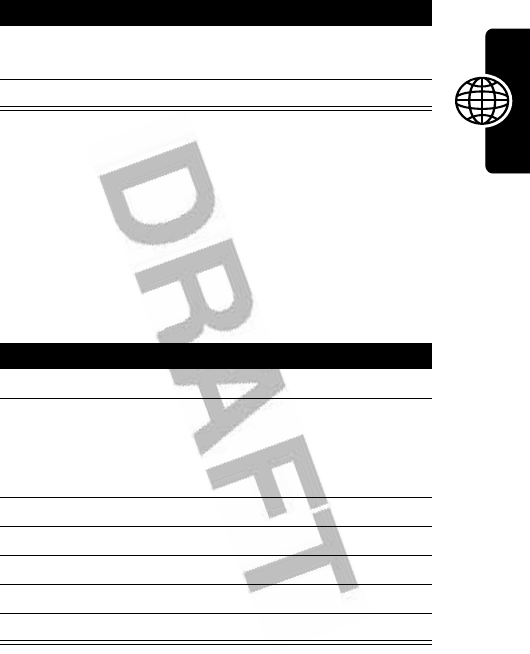
195
News and Entertainment
Creating Ring Tones
You can create and store custom ring tones on your
phone. The ring tones display in the list of available alerts.
Creating a Tone
Entering Notes
Press
S
up or down to cycle through notes and select the
note you want.
3
S
scroll to
Edit
,
Delete
,
Play
, or
Set as Ring Tone
4
SELECT
(
+
) select the option
Find the Feature
M
>
Multimedia
>
Sounds
>
[New iMelody]
Press To
1
CHANGE
(
+
)select
Notes
2
S
up or down
or
keypad keys
enter notes (see following
section)
3
OK
(
+
) store the notes
4
CHANGE
(
+
)select
Name
5
keypad keys enter the name for the tone
6
OK
(
+
) store the name
7
DONE
(
-
) store the tone
Press To
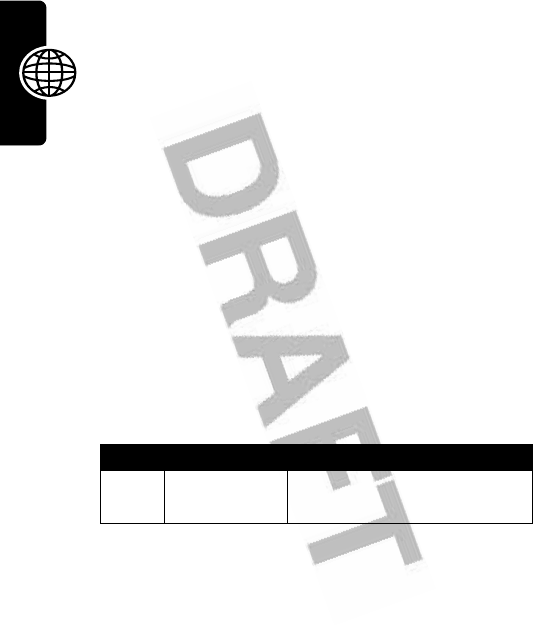
196
News and Entertainment
Press the keypad keys to set note length, enter rests, and
enter or edit note information. If necessary, press a keypad
key multiple times to cycle through its available options.
Tip:
Press
M
>
Play All
at any time to play the notes you
have entered.
Your phone identifies each note by
octave
(
*0
through
*8
),
note
(
a
through
g
, with sharp notes preceded by a
#
),
and note
length
(
0
through
5
). For example, a C# quarter
note in octave 4 displays as
*4#c2
.
Each note must contain the following information, in the
following sequence:
octave
,
note
,
length
, and length
modifier
(optional).
Octave
Enter
*
before a number to identify it as an octave value.
Octave information (
*0
to
*8
) must come
before
the note. If
you do not specify an octave, the note is played as an
octave 4 note.
Notes and Rests
To make a note sharp or flat, enter the sharp or flat
character (
#
or
&)
before
the note.
Key Display Description
0
*
enter
*
followed by a number
(
0
to
8
) to set the octave
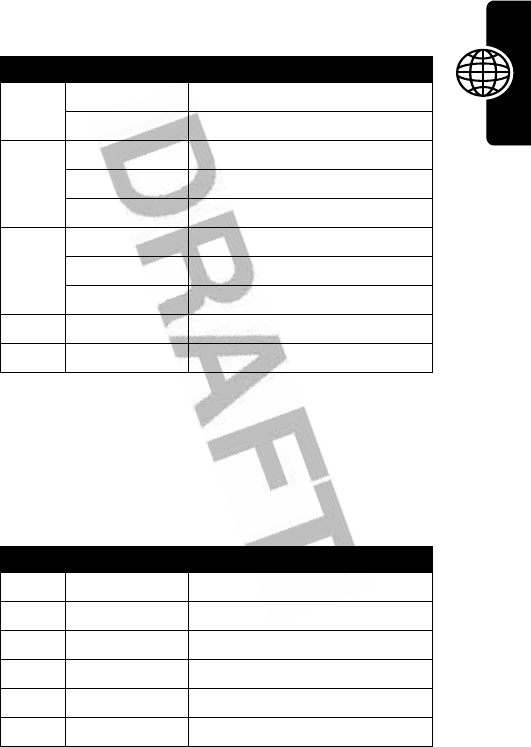
197
News and Entertainment
You can enter 1 or more rest characters (
r
) in the note
sequence. Set rest length the same way you set note
length.
Lengths and Modifiers
Set the length (
0
to
5
)
after
a note or rest. If you do not
specify a length, a quarter note length (
2
) is appended to
the note. If needed, you can enter an optional length
modifier (
.
or
:
or
;
)
after
the length character.
Key Display Description
0
#
sharp
&
flat
2
a
note A
b
note B
c
note C
3
d
note D
e
note E
f
note F
4
g
note G
7
r
rest
Key Display Description
0
0
whole note
1
1
half note
2
2
quarter note
3
3
eighth note
4
4
sixteenth note
5
5
1/32 note
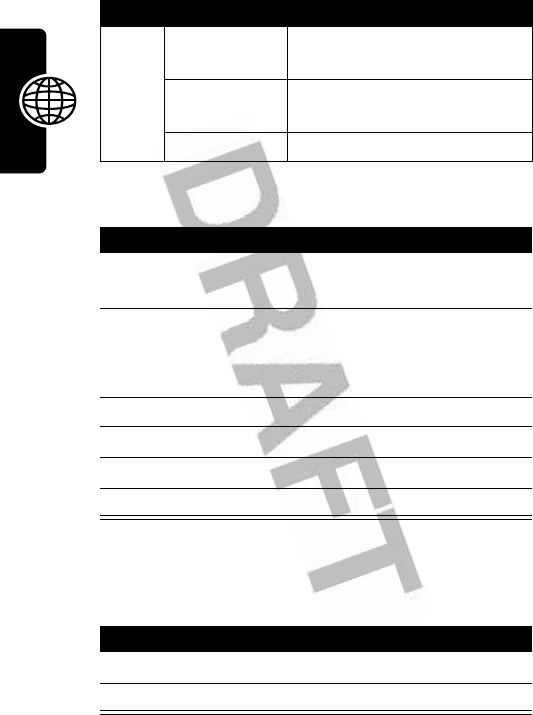
198
News and Entertainment
Example
Playing a Tone
1
.
dotted note
(1 and 1/2 length note)
:
double dotted note
(1 and 3/4 length note)
;
2/3 length note
Action
1
Press
S
to scroll up to
*4c
, then wait for the
cursor to move to the next position
2
Press
S
to scroll down to
*3f
The phone adds a
2
after each note you enter to
identify it as a quarter note.
3
Press 7 to enter a rest character (
r
)
4
Press
S
to scroll up to
*3a
5
Press
S
to scroll up to
*4c
6
Press
M
>
Play All
to play the tone
Find the Feature
M
>
Multimedia
>
Sounds
Press To
1
S
scroll to the tone
2
PLAY
(
+
) play the tone
Key Display Description
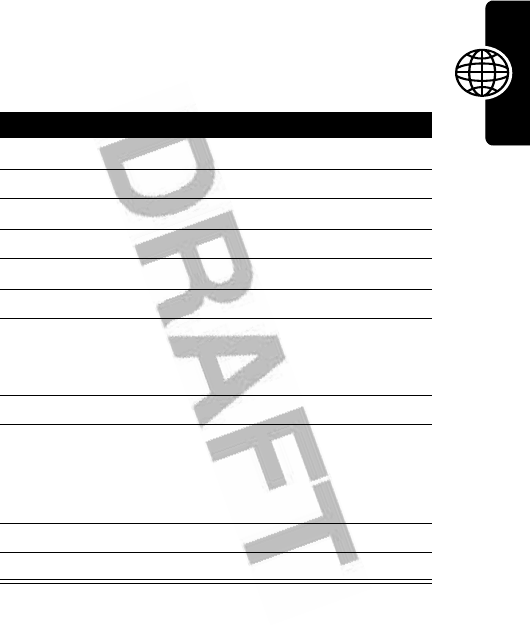
199
News and Entertainment
Editing a Tone
You cannot edit the predefined ring tones included with
your phone. To edit a ring tone that you created:
Deleting a Tone
You cannot delete the predefined ring tones included with
your phone. To delete a ring tone that you created:
Find the Feature
M
>
Multimedia
>
Sounds
Press To
1
S
scroll to the tone
2
M
open the
Tone Menu
3
S
scroll to
Edit
4
SELECT
(
+
) select
Edit
5
S
scroll to
Notes
6
CHANGE
(
+
)select
Notes
7
S
left or right move the cursor to the right of
the note information you want
to edit
8
DELETE
(
-
) delete note information
9
S
up or down
or
keypad keys
enter new note information
10
OK
(
+
) store new note information
11
DONE
(
-
) save your changes
Find the Feature
M
>
Multimedia
>
Sounds
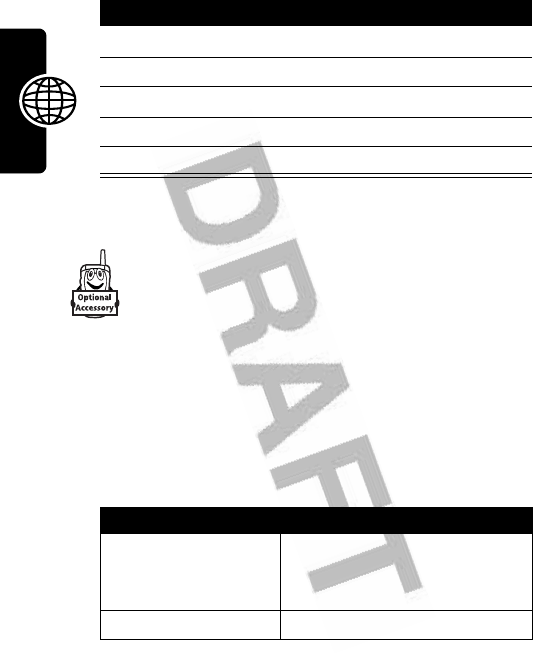
200
News and Entertainment
Camera Settings
You can take photos with your phone when the
optional Motorola Original™ Digital Camera
accessory is plugged into the phone’s accessory
connector port. For instructions on how to take
and send photos, see page 33.
To adjust camera settings:
The
Pictures Setup
menu can include the following options:
Press To
1
S
scroll to the tone
2
M
open the
Tone Menu
3
S
scroll to
Delete
4
SELECT
(
+
) select
Delete
5
YES
(
-
) confirm the deletion
Find the Feature
M
>
Multimedia
>
Pictures
M
>
Pictures Setup
Option Description
Lighting Conditions
Set to
Automatic
,
Sunny
,
Cloudy
,
Indoor (Home)
,
Indoor (Office)
, or
Night
.
Exposure
Set to
+2
,
+1
,
0
,
-1
, or
-2
.
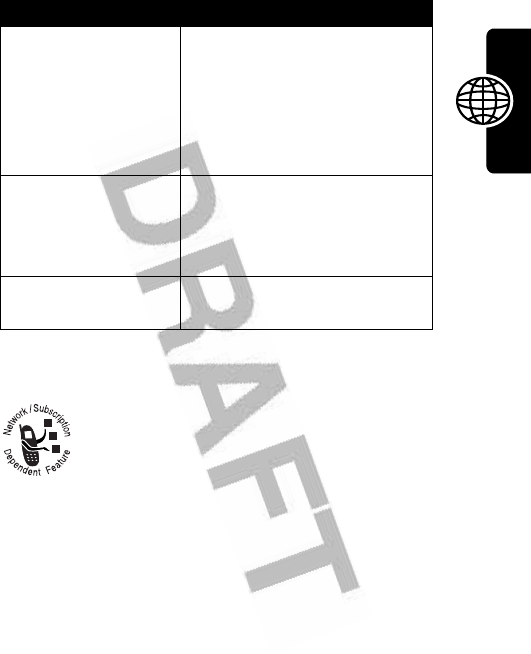
201
News and Entertainment
SIM Applications
Your SIM card may contain applications that
process your outgoing calls, text messages, and
other events. Contact your service provider for
more information.
Resolution
Set the camera to capture
photos at the following
resolutions:
MMS
(160x120
pixels),
Medium
(320x240
pixels, or
High
(640x480
pixels)
Shutter Tone
Activate a tone that sounds
when you take a photo. Can
be set to
None
,
Chimp
,
Quack
,
Flix
,
Boing
, or
Click
.
Status Icons
Turn status icons
On
or
Off
in
camera viewfinder mode.
Find the Feature
M
>
Office Tools
>
SIM Applications
Option Description
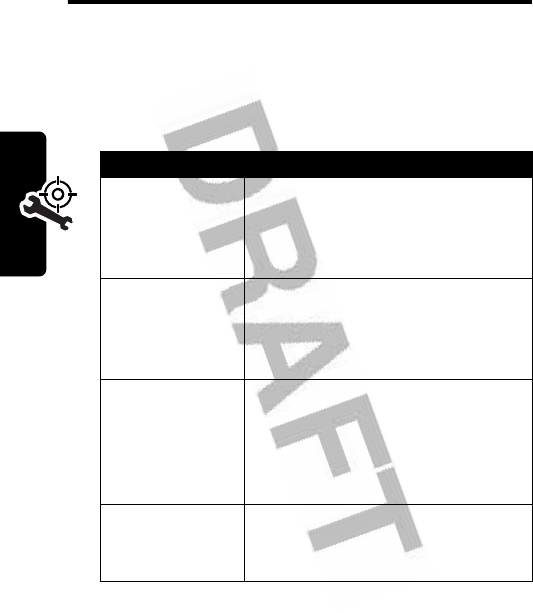
202
Troubleshooting
Troubleshooting
Check these questions first if you have problems with your
phone. If you need additional help, contact the Motorola
Customer Call Center at 1-800-331-6456 (USA) or
1-800-461-4575 (Canada).
Question Answer
Is your battery
charged? Do
you see
Ä
in
the display?
The battery level indicator should
have at least 1 segment showing
(
Å
). If it does not, recharge your
battery (see page 20.)
Do you have a
valid SIM card
inserted in
your phone?
If necessary, turn off your phone
and make sure that you have
inserted a valid SIM card (see
page 19).
Does the
handset have
a signal? Do
you see
!
in
the display?
The signal strength indicator
should have at least 1 segment
showing (
#
). If it does not, move
to an area with a stronger signal
to use your phone.
Is the earpiece
volume too
low?
While on a call, press the upper
volume key on the side of your
phone.

203
Troubleshooting
The following refer to specific problems:
Is the other
party unable to
hear you?
Your phone may be muted. Press
UNMUTE
(
+
) if necessary to unmute
the phone.
Also, make sure that your phone’s
microphone is not blocked by its
carrying case or a sticker.
Has the phone
been
damaged,
dropped, or
gotten wet?
Dropping your phone, getting it
wet, or using a non-Motorola
battery or battery charger can
damage the phone. The phone’s
limited warranty does not cover
liquid damage or damage caused
from using non-Motorola
accessories.
Was a
non-Motorola
battery or
battery
charger used?
Problem Solution
My phone was
stolen. To
whom should I
report this?
Report a stolen phone to the
police and to your service provider
(the company that sends you your
monthly wireless service bill).
I forgot my
password.
See page 58.
Question Answer
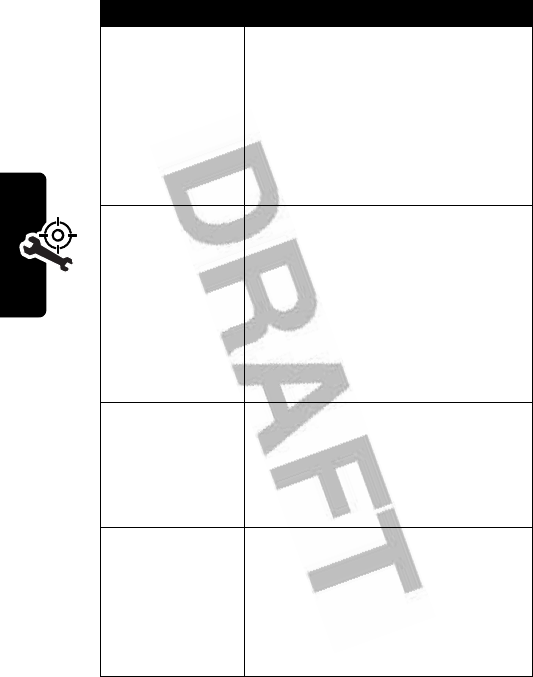
204
Troubleshooting
I pressed the
power key, but
nothing
happened.
Be sure to press and hold
P
(power key) until the display
appears and you hear an alert.
This could take several seconds.
If nothing happens, check that a
charged battery is installed (see
page 19).
The display
says:
Insert SIM Card
or
Check SIM Card
even though I
have inserted
my SIM card in
the phone.
The SIM card may be incorrectly
inserted. Check the SIM card to
make sure that it is inserted
properly (see page 19).
The display
says:
SIM Blocked
. How
do I unblock
my SIM card?
Call your service provider (the
company that sends you your
monthly wireless service bill) to
obtain the PIN unblocking key
(PUK) code (see page 178).
The display
says:
Enter
Unlock Code
. How
do I unlock my
phone?
Enter the factory-preset unlock
code (1234), or the last 4 digits of
your phone number. If this fails,
call your service provider (the
company that sends you your
monthly wireless service bill).
Problem Solution
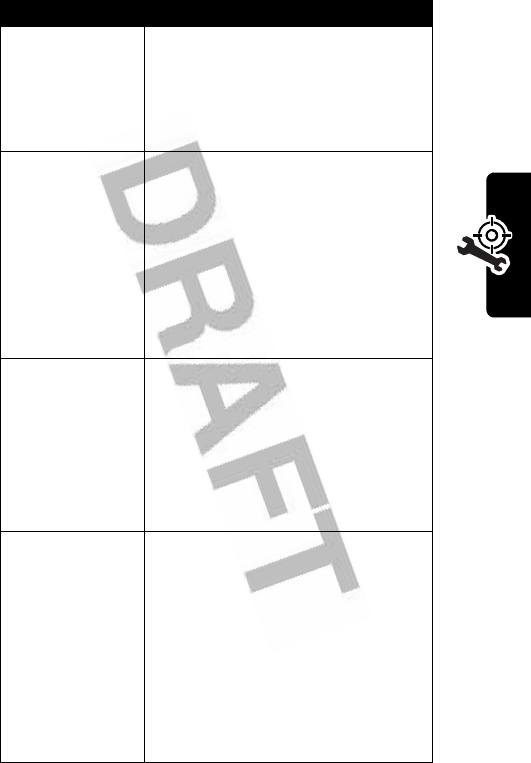
205
Troubleshooting
My phone asks
for an unlock
code when I
try to open a
feature.
The application you want is
locked. If you do not know the
unlock code, see page 58.
My phone
does not ring.
If you see
{
or
|
in the display,
then the ringer is turned off. To
change the ring style, see
page 61.
Also, the ringer may be set to
Silent
even though your phone is set to
an audible ring style. To set an
audible alert, see page 123.
I tried to place
a call and
heard an
alternating
high/low tone.
Your call did not reach the
wireless system. You may have
dialed the number too soon after
turning the phone on. Wait until
the display shows the name of
your service provider before
making a call.
I cannot send/
receive calls.
Make sure that you have a phone
signal (the signal strength
indicator should have at least 1
segment showing). Avoid
electrical or radio interference,
and obstructions such as bridges,
parking garages, or tall buildings.
Also, check to be sure your SIM
card is installed and working.
Problem Solution
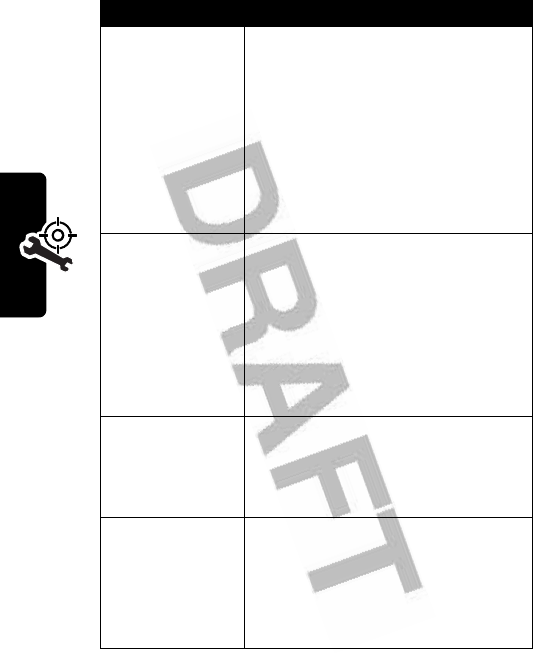
206
Troubleshooting
My phone has
poor reception
and drops
calls.
Make sure that your antenna is
not bent or damaged.
Also, make sure you have a
phone signal (the signal strength
indicator should have at least 1
segment showing). Stay clear of
any obstructions such as bridges,
parking garages, or tall buildings.
I cannot hear
others on my
phone.
While on a call, press the upper
volume key. Your phone display
should show the volume
increasing.
Also, make sure that your phone’s
earpiece is not blocked by its
carrying case.
I cannot open
my text
message
inbox.
Before you can use text
messages, you must set up the
message inbox (see page 77).
How do I see
the calls I sent
or received?
To see the most recent calls you
dialed or received:
M
>
Recent Calls
>
Received Calls
or
Dialed Calls
Problem Solution
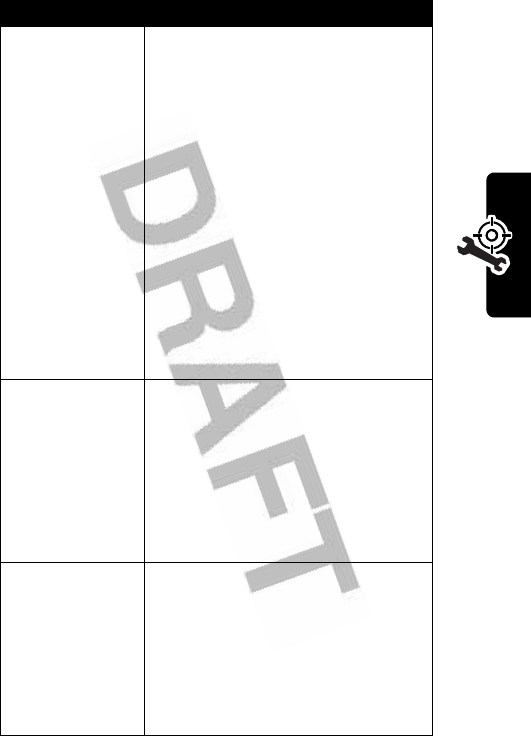
207
Troubleshooting
My phone will
not send
voicemail
commands,
passwords, or
other codes.
You must send PIN codes and
passwords as DTMF tones while
on a call. You can set your
phone’s DTMF tones to be
Long
,
Short
, or
Off
. If you have trouble
sending numbers, try changing
the DTMF setting.
1
From the home screen, press:
M
>
Settings
>
Initial Setup
>
DTMF
2
Press
S
to scroll to
Long
or
Short
.
3
Press
SELECT
(
+
) to select it.
My phone’s
display is too
dark.
Use the
Brightness
feature to
change the level of contrast in
your display (see page 65).
You can also use the
Backlight
feature to change the length of
time that the display backlight
stays on (see page 65).
My battery
didn’t last as
long as I
expected.
What can I do
to extend
battery life?
Your battery’s performance is
affected by charge time, feature
use, temperature changes,
backlight use, and other factors.
For tips on extending battery life,
see page 21.
Problem Solution
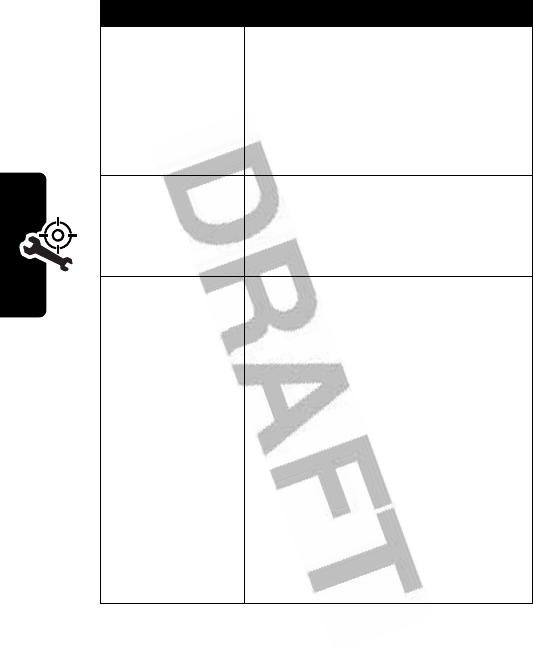
208
Troubleshooting
I am unable to
record a voice
note, voice
name, or voice
shortcut
Try moving to a quieter location to
make your voice recording. Hold
the phone about 4 inches (10
centimeters) from your mouth,
and speak directly into the phone
in a normal tone of voice.
My TTY device
doesn’t work
with my
phone.
Your phone must be set to a TTY
mode for the phone to detect your
TTY device (see page 137).
I plugged the
data cable into
my phone but
my phone did
not beep. How
do I know if
the data cable
is ready to go?
The beep indicates that you are
set up correctly. If you did not
hear a beep, make sure that both
ends of the data cable are
connected—the smaller end to
your phone and the larger end to
your computer.
Also, your computer may have
deactivated the port to save
power. Try opening an application
that uses the port, like a fax or
dial-up application, to
automatically activate the port.
Problem Solution
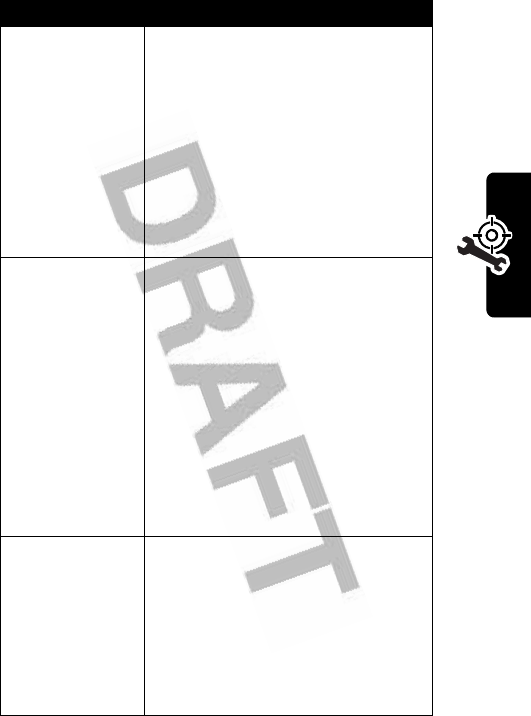
209
Troubleshooting
My phone
beeped when I
attached the
data cable, but
my data and
fax
applications
do not work.
Some wireless networks may not
support data or fax transmission.
If you are roaming on an
unfamiliar network, this may be
the case.
Also, remember that data and fax
transmission usually requires a
subscription. Call your service
provider for more information.
When sending
data with the
data cable,
why does the
computer
show a
connection
rate of 19200
Kbps?
19200 Kbps is the data transfer
rate of the connection between
your computer and the phone in a
standard Circuit Switch Data
(CSD) connection. The rate of the
connection between your phone
and the network is displayed on
your phone, and will be either
14400 or 9600 Kbps.
Note:
A GPRS connection may
have a higher data transfer rate.
I can’t end my
data call by
closing the
application on
my computer.
What can I do?
Try pressing
O
on your phone.
Also try disconnecting the cable or
turning off the phone. If possible,
always close the connection
through your computer. These
alternative methods may disrupt
the application on your computer.
Problem Solution
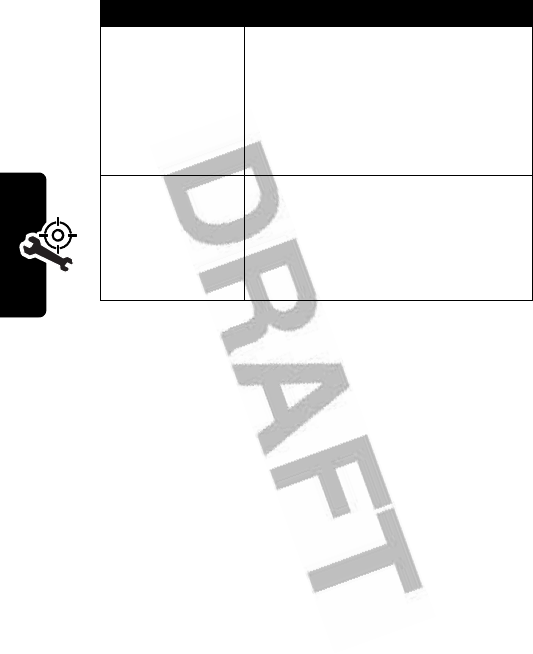
210
Troubleshooting
I launched the
micro-browser
but the display
says:
Network Not
Available
.
You may be in an area without
service, or you may be connected
to a network that does not support
Internet access.
I launched the
micro-browser
but the display
says:
Server Not
Responding
.
Try again in a few minutes. The
servers may be temporarily busy.
Problem Solution

211
Specific Absorption Rate Data
Specific Absorption Rate Data
The model wireless phone meets the government’s requirements for
exposure to radio waves.
Your wireless phone is a radio transmitter and receiver. It is designed and
manufactured not to exceed limits for exposure to radio frequency (RF)
energy set by the Federal Communications Commission (FCC) of the U.S.
Government and by the Canadian regulatory authorities. These limits are
part of comprehensive guidelines and establish permitted levels of RF
energy for the general population. The guidelines are based on standards
that were developed by independent scientific organizations through
periodic and thorough evaluation of scientific studies. The standards
include a substantial safety margin designed to assure the safety of all
persons, regardless of age or health.
The exposure standard for wireless mobile phones employs a unit of
measurement known as the Specific Absorption Rate, or SAR. The SAR
limit set by the FCC and by the Canadian regulatory authorities is
1.6 W/kg.
1
Tests for SAR are conducted using standard operating
positions accepted by the FCC and by Industry Canada with the phone
transmitting at its highest certified power level in all tested frequency
bands. Although the SAR is determined at the highest certified power
level, the actual SAR level of the phone while operating can be well below
the maximum value. This is because the phone is designed to operate at
multiple power levels so as to use only the power required to reach the
network. In general, the closer you are to a wireless base station, the
lower the power output.
Before a phone model is available for sale to the public in the U.S. and
Canada, it must be tested and certified to the FCC and Industry Canada
that it does not exceed the limit established by each government for safe
exposure. The tests are performed in positions and locations (e.g., at the
ear and worn on the body) reported to the FCC and available for review by
Industry Canada. The highest SAR value for this model phone when
tested for use at the ear is 0.71 W/kg, and when worn on the body, as

212
described in this user guide, is 0.26 W/kg. The SAR value for this product
in its data transmission mode (body-worn use) is 0.12 W/kg. (Body-worn
measurements differ among phone models, depending upon available
accessories and regulatory requirements).
2
While there may be differences between the SAR levels of various phones
and at various positions, they all meet the governmental requirements for
safe exposure. Please note that improvements to this product model
could cause differences in the SAR value for later products; in all cases,
products are designed to be within the guidelines.
Additional information on Specific Absorption Rates (SAR) can be found
on the Cellular Telecommunications & Internet Association (CTIA) Web
site:
http://www.phonefacts.net
or the Canadian Wireless Telecommunications Association (CWTA) Web
site:
http://www.cwta.ca
1. In the United States and Canada, the SAR limit for mobile phones used by
the public is 1.6 watts/kg (W/kg) averaged over one gram of tissue. The
standard incorporates a substantial margin of safety to give additional
protection for the public and to account for any variations in measurements.
2. The SAR information includes the Motorola testing protocol, assessment
procedure, and measurement uncertainty range for this product.

213
Additional Health and Safety Information
Consumer Information
on Wireless Phones from
the FDA
The U.S. Food and Drug Administration (FDA) provides consumer
information on wireless phones at:
http://www.fda.gov/cellphones/qa.html
Following are safety-related questions and answers discussed at this web
site.
Do wireless phones pose a health hazard?
The available scientific evidence does not show that any health problems
are associated with using wireless phones. There is no proof, however,
that wireless phones are absolutely safe. Wireless phones emit low levels
of radio frequency energy (RF) in the microwave range while being used.
They also emit very low levels of RF when in the stand-by mode. Whereas
high levels of RF can produce health effects (by heating tissue), exposure
to low level RF that does not produce heating effects causes no known
adverse health effects. Many studies of low level RF exposures have not
found any biological effects. Some studies have suggested that some
biological effects may occur, but such findings have not been confirmed
by additional research. In some cases, other researchers have had
difficulty in reproducing those studies, or in determining the reasons for
inconsistent results.
What is FDA's role concerning the safety of
wireless phones?
Under the law, FDA does not review the safety of radiation-emitting
consumer products such as wireless phones before they can be sold, as it
does with new drugs or medical devices. However, the agency has
authority to take action if wireless phones are shown to emit radio
frequency energy (RF) at a level that is hazardous to the user. In such a

214
case, FDA could require the manufacturers of wireless phones to notify
users of the health hazard and to repair, replace or recall the phones so
that the hazard no longer exists.
Although the existing scientific data do not justify FDA regulatory actions,
FDA has urged the wireless phone industry to take a number of steps,
including the following:
•
Support needed research into possible biological effects of RF of the
type emitted by wireless phones;
•
Design wireless phones in a way that minimizes any RF exposure to
the user that is not necessary for device function; and
•
Cooperate in providing users of wireless phones with the best
possible information on possible effects of wireless phone use on
human health.
FDA belongs to an interagency working group of the federal agencies that
have responsibility for different aspects of RF safety to ensure
coordinated efforts at the federal level. The following agencies belong to
this working group:
•
National Institute for Occupational Safety and Health
•
Environmental Protection Agency
•
Federal Communications Commission
•
Occupational Safety and Health Administration
•
National Telecommunications and Information Administration
The National Institutes of Health participates in some interagency working
group activities, as well.
FDA shares regulatory responsibilities for wireless phones with the
Federal Communications Commission (FCC). All phones that are sold in
the United States must comply with FCC safety guidelines that limit RF
exposure. FCC relies on FDA and other health agencies for safety
questions about wireless phones.

215
FCC also regulates the base stations that the wireless phone networks
rely upon. While these base stations operate at higher power than do the
wireless phones themselves, the RF exposures that people get from
these base stations are typically thousands of times lower than those they
can get from wireless phones. Base stations are thus not the primary
subject of the safety questions discussed in this document.
What is FDA doing to find out more about the
possible health effects of wireless phone RF?
FDA is working with the U.S. National Toxicology Program and with
groups of investigators around the world to ensure that high priority
animal studies are conducted to address important questions about the
effects of exposure to radio frequency energy (RF).
FDA has been a leading participant in the World Health Organization
International Electromagnetic Fields (EMF) Project since its inception in
1996. An influential result of this work has been the development of a
detailed agenda of research needs that has driven the establishment of
new research programs around the world. The Project has also helped
develop a series of public information documents on EMF issues.
FDA and the Cellular Telecommunications & Internet Association (CTIA)
have a formal Cooperative Research and Development Agreement
(CRADA) to do research on wireless phone safety. FDA provides the
scientific oversight, obtaining input from experts in government, industry,
and academic organizations. CTIA-funded research is conducted through
contracts to independent investigators. The initial research will include
both laboratory studies and studies of wireless phone users. The CRADA
will also include a broad assessment of additional research needs in the
context of the latest research developments around the world.

216
What steps can I take to reduce my exposure to
radio frequency energy from my wireless
phone?
If there is a risk from these products--and at this point we do not know that
there is--it is probably very small. But if you are concerned about avoiding
even potential risks, you can take a few simple steps to minimize your
exposure to radio frequency energy (RF). Since time is a key factor in how
much exposure a person receives, reducing the amount of time spent
using a wireless phone will reduce RF exposure.
If you must conduct extended conversations by wireless phone every day,
you could place more distance between your body and the source of the
RF, since the exposure level drops off dramatically with distance. For
example, you could use a headset and carry the wireless phone away
from your body or use a wireless phone connected to a remote antenna.
Again, the scientific data do not demonstrate that wireless phones are
harmful. But if you are concerned about the RF exposure from these
products, you can use measures like those described above to reduce
your RF exposure from wireless phone use.
What about children using wireless phones?
The scientific evidence does not show a danger to users of wireless
phones, including children and teenagers. If you want to take steps to
lower exposure to radio frequency energy (RF), the measures described
above would apply to children and teenagers using wireless phones.
Reducing the time of wireless phone use and increasing the distance
between the user and the RF source will reduce RF exposure.
Some groups sponsored by other national governments have advised that
children be discouraged from using wireless phones at all. For example,
the government in the United Kingdom distributed leaflets containing such
a recommendation in December 2000. They noted that no evidence exists
that using a wireless phone causes brain tumors or other ill effects. Their
recommendation to limit wireless phone use by children was strictly

217
precautionary; it was not based on scientific evidence that any health
hazard exists.
Do handsfree kits for wireless phones reduce
risks from exposure to RF emissions?
Since there are no known risks from exposure to RF emissions from
wireless phones, there is no reason to believe that handsfree kits reduce
risks. Handsfree kits can be used with wireless phones for convenience
and comfort. These systems reduce the absorption of RF energy in the
head because the phone, which is the source of the RF emissions, will not
be placed against the head. On the other hand, if the phone is mounted
against the waist or other part of the body during use, then that part of the
body will absorb more RF energy. Wireless phones marketed in the U.S.
are required to meet safety requirements regardless of whether they are
used against the head or against the body. Either configuration should
result in compliance with the safety limit.
Do wireless phone accessories that claim to
shield the head from RF radiation work?
Since there are no known risks from exposure to RF emissions from
wireless phones, there is no reason to believe that accessories that claim
to shield the head from those emissions reduce risks. Some products that
claim to shield the user from RF absorption use special phone cases,
while others involve nothing more than a metallic accessory attached to
the phone. Studies have shown that these products generally do not work
as advertised. Unlike “handsfree” kits, these so-called “shields” may
interfere with proper operation of the phone. The phone may be forced to
boost its power to compensate, leading to an increase in RF absorption.
In February 2002, the Federal Trade Commission (FTC) charged two
companies that sold devices that claimed to protect wireless phone users
from radiation with making false and unsubstantiated claims. According to
FTC, these defendants lacked a reasonable basis to substantiate their
claim.
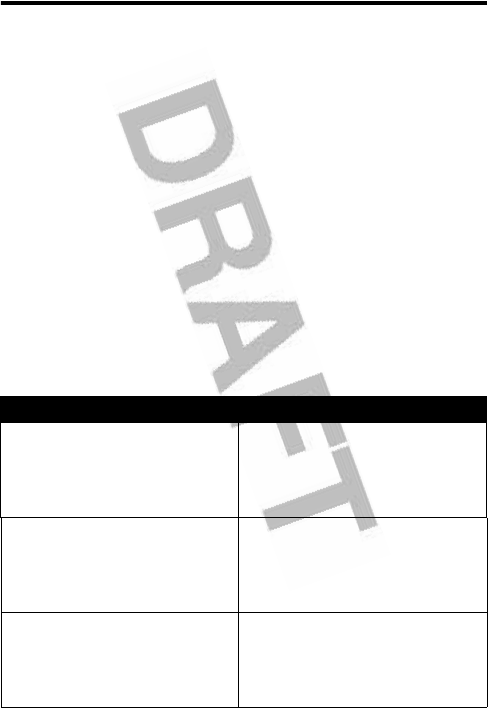
218
Warranty
Motorola Limited Warranty for
the United States and Canada
What Does this Warranty Cover?
Subject to the exclusions contained below, Motorola, Inc. warrants its
telephones, pagers, messaging devices, and consumer and professional
two-way radios (excluding commercial, government or industrial radios)
that operate via Family Radio Service or General Mobile Radio Service,
Motorola-branded or certified accessories sold for use with these
Products (“Accessories”) and Motorola software contained on CD-ROMs
or other tangible media and sold for use with these Products (“Software”)
to be free from defects in materials and workmanship under normal
consumer usage for the period(s) outlined below. This limited warranty is
a consumer's exclusive remedy, and applies as follows to new Motorola
Products, Accessories and Software purchased by consumers in the
United States or Canada, which are accompanied by this written
warranty:
Products and Accessories
Products Covered Length of Coverage
Products and Accessories
as
defined above, unless otherwise
provided for below.
One (1) year
from the date of
purchase by the first consumer
purchaser of the product unless
otherwise provided for below.
Decorative Accessories and
Cases
. Decorative covers,
bezels, PhoneWrap™ covers
and cases.
Limited lifetime warranty
for the
lifetime of ownership by the first
consumer purchaser of the
product.
Monaural Headsets.
Ear buds
and boom headsets that transmit
mono sound through a wired
connection.
Limited lifetime warranty
for the
lifetime of ownership by the first
consumer purchaser of the
product.
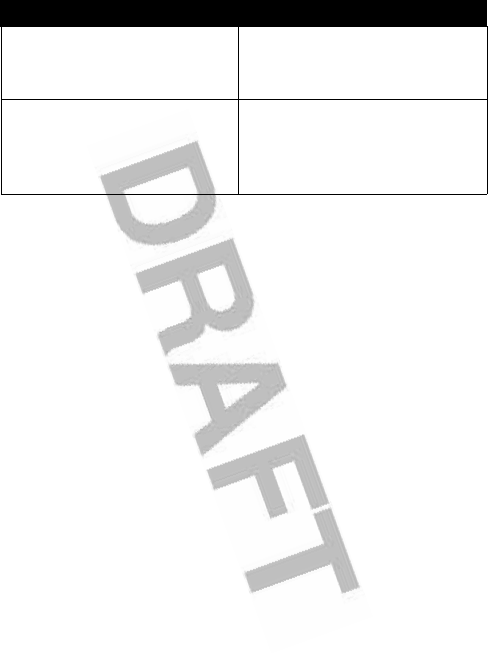
219
Exclusions
Normal Wear and Tear.
Periodic maintenance, repair and replacement of
parts due to normal wear and tear are excluded from coverage.
Batteries.
Only batteries whose fully charged capacity falls below 80% of
their rated capacity and batteries that leak are covered by this limited
warranty.
Abuse & Misuse.
Defects or damage that result from: (a) improper
operation, storage, misuse or abuse, accident or neglect, such as physical
damage (cracks, scratches, etc.) to the surface of the product resulting
from misuse; (b) contact with liquid, water, rain, extreme humidity or
heavy perspiration, sand, dirt or the like, extreme heat, or food; (c) use of
the Products or Accessories for commercial purposes or subjecting the
Product or Accessory to abnormal usage or conditions; or (d) other acts
which are not the fault of Motorola, are excluded from coverage.
Use of Non-Motorola Products and Accessories.
Defects or damage
that result from the use of Non-Motorola branded or certified Products,
Accessories, Software or other peripheral equipment are excluded from
coverage.
Unauthorized Service or Modification.
Defects or damages resulting
from service, testing, adjustment, installation, maintenance, alteration, or
modification in any way by someone other than Motorola, or its authorized
service centers, are excluded from coverage.
Consumer and Professional
Two-Way Radio Accessories.
Ninety (90) days
from the date of
purchase by the first consumer
purchaser of the product.
Products and Accessories that
are Repaired or Replaced.
The balance of the original
warranty or for ninety (90) days
from the date returned to the
consumer, whichever is longer.
Products Covered Length of Coverage
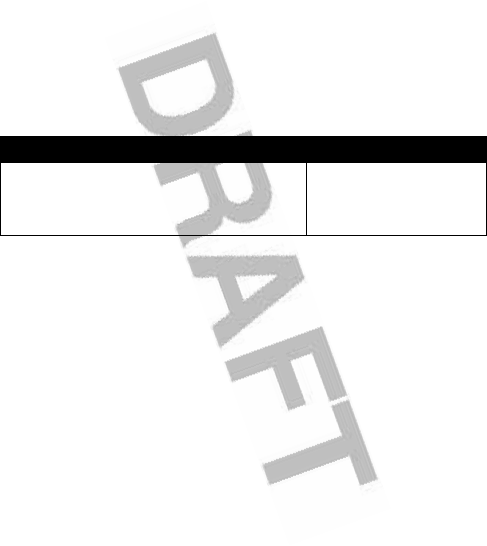
220
Altered Products.
Products or Accessories with (a) serial numbers or
date tags that have been removed, altered or obliterated; (b) broken seals
or that show evidence of tampering; (c) mismatched board serial
numbers; or (d) nonconforming or non-Motorola housings, or parts, are
excluded from coverage.
Communication Services.
Defects, damages, or the failure of Products,
Accessories or Software due to any communication service or signal you
may subscribe to or use with the Products Accessories or Software is
excluded from coverage.
Software
Exclusions
Software Embodied in Physical Media.
No warranty is made that the
software will meet your requirements or will work in combination with any
hardware or software applications provided by third parties, that the
operation of the software products will be uninterrupted or error free, or
that all defects in the software products will be corrected.
Software NOT Embodied in Physical Media.
Software that is not
embodied in physical media (e.g. software that is downloaded from the
internet), is provided “as is” and without warranty.
Who is Covered?
This warranty extends only to the first consumer purchaser, and is not
transferable.
What Will Motorola Do?
Motorola, at its option, will at no charge repair, replace or refund the
purchase price of any Products, Accessories or Software that does not
conform to this warranty. We may use functionally equivalent
Products Covered Length of Coverage
Software.
Applies only to physical defects
in the media that embodies the copy of the
software (e.g., CD-ROM, or floppy disk).
Ninety (90) days
from
the date of purchase.
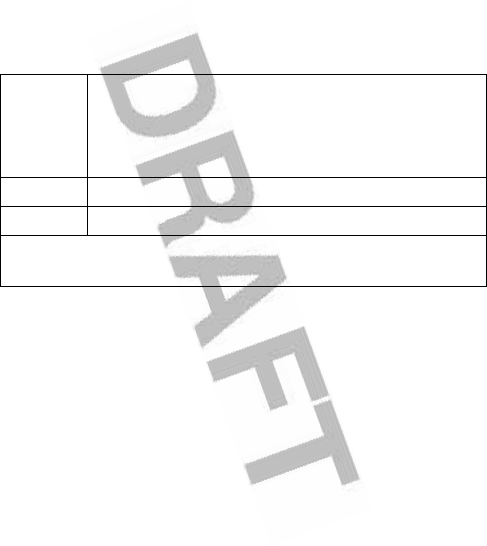
221
reconditioned/refurbished/pre-owned or new Products, Accessories or
parts. No data, software or applications added to your Product, Accessory
or Software, including but not limited to personal contacts, games and
ringer tones, will be reinstalled. To avoid losing such data, software and
applications please create a back up prior to requesting service.
How to Obtain Warranty Service or Other
Information
You will receive instructions on how to ship the Products, Accessories or
Software, at your expense, to a Motorola Authorized Repair Center. To
obtain service, you must include: (a) a copy of your receipt, bill of sale or
other comparable proof of purchase; (b) a written description of the
problem; (c) the name of your service provider, if applicable; (d) the name
and location of the installation facility (if applicable) and, most importantly;
(e) your address and telephone number.
What Other Limitations Are There?
ANY IMPLIED WARRANTIES, INCLUDING WITHOUT LIMITATION THE
IMPLIED WARRANTIES OF MERCHANTABILITY AND FITNESS FOR A
PARTICULAR PURPOSE, SHALL BE LIMITED TO THE DURATION OF
THIS LIMITED WARRANTY, OTHERWISE THE REPAIR,
REPLACEMENT, OR REFUND AS PROVIDED UNDER THIS EXPRESS
LIMITED WARRANTY IS THE EXCLUSIVE REMEDY OF THE
CONSUMER, AND IS PROVIDED IN LIEU OF ALL OTHER
USA
Phones
1-800-331-6456
Pagers
1-800-548-9954
Two-Way Radios
and Messaging Devices
1-800-353-2729
Canada
All Products
1-800-461-4575
TTY
1-888-390-6456
For
Accessories
and
Software
, please call the telephone number
designated above for the product with which they are used.

222
WARRANTIES, EXPRESS OR IMPLIED. IN NO EVENT SHALL
MOTOROLA BE LIABLE, WHETHER IN CONTRACT OR TORT
(INCLUDING NEGLIGENCE) FOR DAMAGES IN EXCESS OF THE
PURCHASE PRICE OF THE PRODUCT, ACCESSORY OR SOFTWARE,
OR FOR ANY INDIRECT, INCIDENTAL, SPECIAL OR
CONSEQUENTIAL DAMAGES OF ANY KIND, OR LOSS OF REVENUE
OR PROFITS, LOSS OF BUSINESS, LOSS OF INFORMATION OR
DATA, SOFTWARE OR APPLICATIONS OR OTHER FINANCIAL LOSS
ARISING OUT OF OR IN CONNECTION WITH THE ABILITY OR
INABILITY TO USE THE PRODUCTS, ACCESSORIES OR SOFTWARE
TO THE FULL EXTENT THESE DAMAGES MAY BE DISCLAIMED BY
LAW.
Some states and jurisdictions do not allow the limitation or
exclusion of incidental or consequential damages, or limitation on
the length of an implied warranty, so the above limitations or
exclusions may not apply to you. This warranty gives you specific
legal rights, and you may also have other rights that vary from state
to state or from one jurisdiction to another.
Laws in the United States and other countries preserve for Motorola
certain exclusive rights for copyrighted Motorola software such as the
exclusive rights to reproduce and distribute copies of the Motorola
software. Motorola software may only be copied into, used in, and
redistributed with, the Products associated with such Motorola software.
No other use, including without limitation disassembly of such Motorola
software or exercise of the exclusive rights reserved for Motorola, is
permitted.

223
Product Registration
Product Registration
Online Product Registration:
http://www.motorola.com/warranty
Product registration is an important step toward enjoying your new
Motorola phone. Registering helps us facilitate warranty service, and
permits us to contact you should your phone require an update or other
service. Registration is for U.S. residents only and is not required for
warranty coverage.
Please retain your original dated sales receipt for your records. For
warranty service of your Motorola Personal Communications Product you
will need to provide a copy of your dated sales receipt to confirm warranty
status.
Thank you for choosing a Motorola product.
Export Law Assurances
Export Law Assurances
This product is controlled under the export regulations of the United
States of America and Canada. The Governments of the United States of
America and Canada may restrict the exportation or re-exportation of this
product to certain destinations. For further information contact the U.S.
Department of Commerce or the Canadian Department of Foreign Affairs
and International Trade.
RF Energy Interference
RF Energy Interference
This device complies with Part 15 of the FCC Rules. Operation is subject
to the following two conditions: (1) this device may not cause harmful
interference, and (2) this device must accept any interference received,
including interference that may cause undesired operation.

224
Wireless: The New Recyclable
Wireless: The New Recyclable
Your wireless phone can be recycled. Recycling your wireless phone
reduces the amount of waste disposed in landfills and allows recycled
materials to be incorporated into new products.
The Cellular Telecommunications Industry Association (CTIA) and its
members encourage consumers to recycle their phones and have taken
steps to promote the collection and environmentally sound recycling of
end-of-life wireless devices.
As a wireless phone user, you have an important role in ensuring that this
phone is recycled properly. When it comes time to give this phone up or
trade it in for a new one, please remember that the phone, the charger,
and many of its accessories can be recycled. It's easy.
To learn more about CTIA's Recycling Program for Used Wireless
Devices in the United States, including information on where to recycle
wireless devices near you, please visit
www.recyclewirelessphones.com

225
Index
A
accessories 18, 136, 147,
150, 172
accessory connector port 1
active line indicator 40, 41
active line, changing 66
alarm clock 168
alert
creating 195
defined 61
downloading 2, 88, 183
setting 24, 61, 123, 184
turning off 24, 68
animation
downloading 2, 88, 183
managing 31
screen saver 32, 64, 184
wallpaper 32, 63, 184
answering a call 25, 62
application, locking and
unlocking 180
appointments. See
datebook
B
backlight 65
battery
charging 20
extending battery life 21,
56, 64, 65
installing 19
level indicator 40, 42
meter 160
browser messages 89
browser. See mMode
C
calculator 175
calendar. See datebook
call
adding digits after phone
number 70
alert, setting 24, 61, 123
alert, turning off 24, 68
answer options 62
answering 25
call waiting 74
calling card 109
conference call 36
deleting 69
dialed calls list 69
dialing 24
emergency number 68
ending 24, 25
forwarding 134
hold 75

226
international access code
68
making 24
received calls list 69
receiving 25
recent calls 69
speakerphone 147
storing 69
talk then fax 70
timing 140, 142
transferring 75
unanswered call 70
call timers 140
call waiting 74
caller ID 67, 70, 107
calling card call 109
calling line identification.
See caller ID
camera 200
attaching 23
taking a photo 33
capitalization, changing 48
car kit 147
center select button 43
character chart 52
clock
illustration 38
selecting analog or digital
126
setting 61
codes
changing 57
default 57, 58
forgetting 58
color, setting 65
computer
connecting to phone 150
synchronizing data 122,
152, 167
conference call 36
contrast, setting 65
currency converter 176
cursor 46
customizing the menu 127
D
data call
making 150
timers 142
volume meters 142
date, setting 61
datebook
alarm clock 168
reminders 164, 167
synchronizing 152, 167
using 161
deleting a call 69
dialed calls list 69
dialing a number 24, 138,
139
display
backlight 65
color 65
contrast 65

227
description 38
greeting 125
home screen 38
language 128
menu icons, showing or
hiding 126
personalizing 127
drafts folder 30, 80, 85, 96,
97
DTMF tones
activating 139, 207
defined 139
sending 69, 70, 140
E
earpiece volume 24
email
deleting 98
draft 30, 96
inbox setup 91
locking 98
personal folders 102
phone number, calling
101
reading 98
receiving 97
reminders 97
sending 28, 94, 101
sending manually 100
email address, storing in
phonebook 105
emergency number 68
end key 1, 24, 25, 43
ending a call 24, 25
Enter Unlock Code
message 58, 59
event alert 123
exchange rate, calculating
176
external device
connecting to phone 150
synchronizing data 122,
152, 167
external display 56
F
fax call 70, 150
5-way navigation key 1, 42,
43
fixed dial 138
flashing cursor 46
flip
external display 56
open to answer 25, 62
screen saver 64
forwarding calls 134
G
games 38, 188
GPRS indicator 40, 182
greeting 125
groove tunes 191

228
H
handsfree use 147
headset
accessory, using 147
headset jack 1
Hide ID feature 70
hold a call 75
home keys, personalizing
127
home screen
defined 38
menu icons, showing or
hiding 126
selecting clock view 126
setting display text 125
I
in use indicator 40
incoming call
answering 25
forwarding 134
Incoming Call message 67
indicators
active line 40, 41
battery level 40, 42
GPRS 40, 182
in use 40
location 40, 42
loud ring alert 42
menu 38
message waiting 28, 40,
42, 85, 89, 97
missed call 70
phonebook number type
104
ring alert 40, 42
roam 40, 41
signal strength 40, 41
silent alert 42
soft ring alert 42
text case 47
text entry method 42, 47
transmission 40
vibrate alert 42
vibrate and ring alert 42
voice name 104
voicemail message 42,
73
international access code
68
iTAP software 48
J
Java applications 188, 191
joystick 1, 43
K
key
center select button 43
end 1, 24, 25, 43
5-way navigation 1, 42,
43

229
left soft key 1, 39, 43, 127
menu 1, 43, 44
power 1, 23
right soft key 1, 39, 43,
127
send 1, 24, 25, 69
voice 1, 170
volume control 1, 24
keypad
answering calls 62
backlight 65
volume, setting 124
L
language, setting 128
left soft key
functions 1, 39, 43
personalizing 127
line, changing 66
location indicator 40, 42
lock
application 180
phone 57
SIM card 178
Low Battery message 42
M
mailing list, creating 107
making a call 24
master clear 129
master reset 129
memory available 191
Memory is Full! message
85, 97
menu
entering text 46
icons, changing in idle
display 127
icons, converting to text
127
icons, described 38
icons, showing or hiding
126
language, setting 128
lists 45
navigating 43
personalizing 128
scroll 128
using features 45
view, changing 127
wrap around 128
menu indicator 38
menu key 1, 43, 44
message
animation 88
browser messages 89
deleting 86
draft 80, 85, 97
email 91
inbox setup 77
locking 86
menu feature icon 38
MMS, defined 26, 77
outbox 84

230
picture 88
quick note 80
reading 2, 86
receiving 85
reminders 85, 125
ring tone 88
sending 79
status 84
text 2
message waiting indicator
28, 40, 42, 85, 89, 97
messages menu feature
icon 38
micro-browser
animation 183
browser messages 89
browser setup 185
Java applications 188,
191
picture 183
ring tone 183
Web sessions 185
microphone 1
missed call indicator 70
Missed Calls message 71
mMode
using 182
MMS, defined 34
MMS. See message
MotoMixer 191
multimedia letter
receiving 85
multimedia message
receiving 28, 85
sending 26, 81
multimedia messaging
service. See
message
my telephone number 5,
25, 61
my tones 195
N
network settings 155
notepad 71
number
storing in phonebook 105
storing your number 61
viewing your number 5,
25
numbers, entering 55
O
1-touch dial
setting preference 121
using 72
open to answer 62
optional accessory, defined
18
optional feature, defined 18
outbox 84

231
P
passwords. See codes
pause character 109, 110
phone
active line indicator 41
active line, changing 66
alert, setting 24, 61, 123
alert, turning off 24, 68
answer options 62
clear stored information
129
codes 57
connecting to external
device 150
date, setting 61
flip 25
keypad, answering calls
62
language, setting 128
locking 57
network settings 155
reset all options 129
security code 57
time, setting 61
turning on/off 23
unlock code 57
unlocking 23, 57, 58, 59
phone number
active line indicator 41
active line, changing 66
adding digits after 70
attaching 2 numbers 70,
72
international access code
68
long numbers, storing
112
redialing 66
storing in phonebook 2,
105
storing your number 61
viewing your number 5,
25
phone theme 186
phonebook
attaching 2 numbers 70,
72
capacity, checking 121
category views 60, 116
copying entries 120
creating an entry 105
deleting an entry 114
dialing a number 2, 111
editing an entry 113
email address, storing
105
entry category 105, 108
entry details 104
long numbers 112
mailing list 107
menu feature icon 38
number type indicator
104

232
number, storing 105
1-touch dial 72
picture caller ID 107
primary number, setting
116
ringer ID 106, 118, 123
sorting entries 60, 114
speed dial number 72,
104, 106, 108
storing an entry 2
synchronizing 122, 152
voice dialing 2
voice name, recording
110
photo
downloading 2, 88, 183
managing 31
picture caller ID 107
screen saver 32
sending 33, 81
taking 33
wallpaper 32
picture
downloading 2, 88, 183
managing 31
screen saver 32, 64, 184
sending 81
wallpaper 32, 63, 184
picture caller ID 107
PIN code
changing 57
defined 178
entering 178
storing with phonebook
entry 109
unblocking 178
PIN2 code
changing 57
entering 138
unblocking 179
power key 1, 23
predictive text entry 48
primary text entry method
47
PUK code 178
PUK2 code 180
Q
quick note 80
R
received calls list 69
recent calls 69
redial
busy number 66
reminders
datebook 164, 167
defined 125
email message 97
text message 85
turning on/off 125
right soft key
functions 1, 39, 43
personalizing 127

233
ring alert
creating 195
setting 24, 61, 123, 184
turning off 24, 68
ring alert indicators 40, 42
ring tone
creating 195
downloading 2, 88, 183
editing with MotoMixer
191
sending 81
setting as event alert 184
ringer ID
setting 106, 118
turning on/off 123
ringer volume, setting 24,
124
roam indicator 40, 41
S
screen saver 32, 64, 184
scroll, menu 128
secondary text entry
method 47
security code
changing 57
default 57
forgetting 59
send key 1, 24, 25, 69
service dial 139
settings 38
short message service. See
message
shortcuts 5, 129
Show ID feature 70
signal strength indicator 40,
41
silent alert indicator 42
silent alert, setting 24, 61,
123
SIM applications 201
SIM Blocked message 178,
179
SIM Blocked
message 23
SIM card
applications 201
defined 19
installing 19
locking 178
PIN code entry 23
PIN code, changing 57
PIN2 code, changing 57
precautions 19
service phone numbers
139
SIM Blocked message
178, 179
SIM Blocked
message 23
SIM Disabled message
179
unblocking 178
SIM Disabled message 179
SIM PIN code

234
changing 57
defined 178
entering 178
unblocking 178
SIM PIN2 code
changing 57
entering 138
unblocking 179
SMS. See message
soft keys
functions 39, 43
illustration 1
labels 38
personalizing 127
sound
downloading 2, 88, 183
sending 81
speakerphone
activating 147
automatic answer 147
speed dial
number, setting 106, 108
sorting phonebook entries
114
using 72
standby time, increasing
56, 64, 65
status light 1, 56
storing a call 69
symbol chart 54
symbols, entering 54
synchronizing data 122,
152, 167
T
talk then fax call 70
tap method text entry 50
telephone number
storing in phonebook 105
storing your number 61
viewing your number 5,
25
text 48
character chart 52
entering 46
entry method, selecting
47
entry method, setup 48
flashing cursor 46
iTAP software predictive
text entry 48
numeric method 55
symbol chart 54
symbol method 54
tap method 50
text case indicator 47
text entry method
selecting 47
setup 48
text entry method indicator
42, 47
theme 186
time, setting 61

235
timers 140, 142
transfer a call 75
transmission indicator 40
travel charger 21
TTY device 136
U
unblocking the SIM card
178
unlock
application 180
phone 57
unlock code
bypassing 58
changing 57
default 57, 58
entering 23, 58
forgetting 59
V
vibrate alert
setting 24, 61, 123
turning off 24, 68
voice dial 2
dialing a number 112
dialing from headset 148
recording voice name
110
voice key
dialing a number 2, 112
illustration 1
recording voice name
110
recording your voice 170
voice name
dialing 112
indicator 104
recording 110
voice record
playing 171
recording 170
voice shortcut 130
voicemail 73
voicemail message indicator
42, 73
volume
earpiece 24
keypad 124
ringer 24, 124
volume keys 1, 24
W
wait character 110
wallpaper 32, 63, 184
warranty 218
Web pages 182
Web sessions 185
U.S. patent Re. 34,976

236
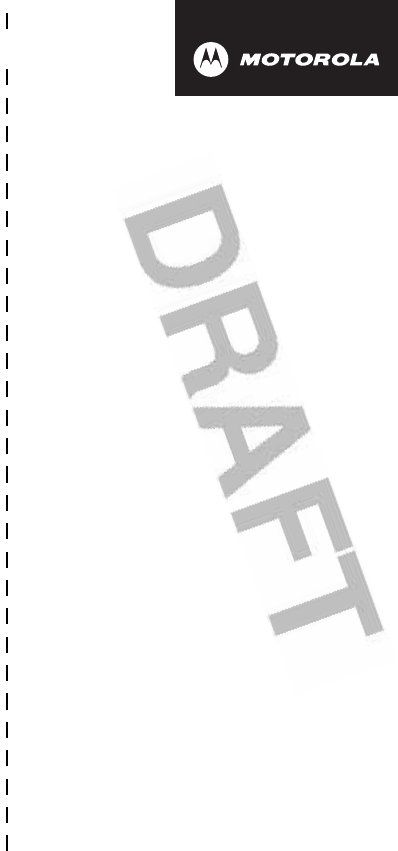
✂
237
art# 020827-O.eps
Wireless Phone Safety
Tips
“Safety is your most important call!”
Your Motorola wireless telephone gives you
the powerful ability to communicate by voice—
almost anywhere, anytime, wherever wireless
phone service is available and safe conditions allow.
But an important responsibility accompanies the
benefits of wireless phones, one that every user
must uphold.
When driving a car, driving is your first
responsibility. If you find it necessary to use your
wireless phone while behind the wheel of a car,
practice good common sense and remember the
following tips:
1 Get to know your Motorola wireless phone and its
features such as speed dial and redial.
If available,
these features help you to place your call without taking
your attention off the road.
2 When available, use a handsfree device.
If possible,
add an additional layer of convenience to your wireless

✂
238
phone with one of the many Motorola Original™
handsfree accessories available today.
3 Position your wireless phone within easy reach.
Be
able to access your wireless phone without removing
your eyes from the road. If you receive an incoming call
at an inconvenient time, if possible, let your voice mail
answer it for you.
4 Let the person you are speaking with know you are
driving; if necessary, suspend the call in heavy
traffic or hazardous weather conditions.
Rain, sleet,
snow, ice, and even heavy traffic can be hazardous.
5 If you receive an incoming call at an inconvenient
time do not take notes or look up phone numbers
while driving.
Jotting down a “to do” list or going
through your address book takes attention away from
your primary responsibility—driving safely.
6 Dial sensibly and assess the traffic; if possible,
place calls when you are not moving or before
pulling into traffic.
Try to plan calls when your car will
be stationary. If you need to make a call while moving,
dial only a few numbers, check the road and your
mirrors, then continue.
7 Do not engage in stressful or emotional
conversations that may be distracting.
Make people
you are talking with aware you are driving and suspend
conversations which have the potential to divert your
attention away from the road.
8 Use your wireless phone to call for help.
Dial 9-1-1 or
other local emergency number in the case of fire, traffic
accident or medical emergencies.*

✂
239
9 Use your wireless phone to help others in
emergencies.
If you see an auto accident, crime in
progress or other serious emergency where lives are in
danger, call 9-1-1 or other local emergency number, as
you would want others to do for you.*
10 Call roadside assistance or a special
non-emergency wireless assistance number when
necessary.
If you see a broken-down vehicle posing no
serious hazard, a broken traffic signal, a minor traffic
accident where no one appears injured, or a vehicle you
know to be stolen, call roadside assistance or other
special non-emergency wireless number.*
* Wherever wireless phone service is available.
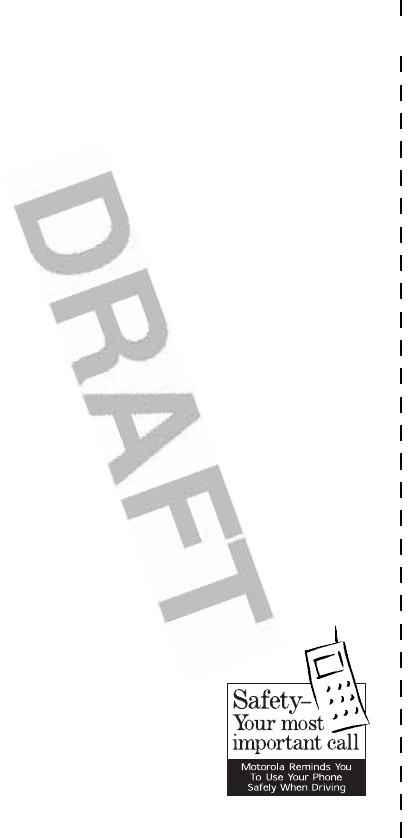
✂
240
Check the laws and regulations on the use of
wireless telephones and their accessories in the
areas where you drive. Always obey them. The
use of these devices may be prohibited or
restricted in certain areas.
For more information,
please call
1-888-901-SAFE
or visit the
CTIA Web site at
www.wow-com.com™
